Crocodile encounters in Australia’s Northern Territory

Aug 7, 2018 • 5 min read

A saltwater crocodile cooling himself with his open mouth © Australian Scenics / Getty Images
The closest living relative to the dinosaur, with a bite force thought to rival that of a T.Rex, saltwater crocodiles are the ultimate apex predators. With more than 100,000 of them patrolling the waterways of Australia’s Northern Territory alone – that’s one saltie for every two human residents – it’s the best place on the planet to see these reptilian relics in action.
Valued at more than AU$100 million, the Northern Territory’s crocodile industry isn’t just important to the local economy, but also to croc conservation, with croc tourism – and even croc farming – credited for an enormous rebound in their numbers since they became a protected species in the 1970s. There are now loads of ways to see a crocodile up close in the Top End, from low-impact wildlife viewing to more manufactured interactions. Given claims by animal welfare experts that using animals for the purpose of entertainment can be harmful for them, however, some options raise ethical questions. To help you make the most informed decision about how you spend your croc-viewing dollars in Australia, we take a closer look at the most popular experiences accessible from Darwin.

Whichever way you decide to go croc-spotting, don’t forget to be croc-wise: stay well back from the edge of any waterway where crocs may live, and don’t even think about taking a dip in any Top End water body unless official signage designates it croc-free, even if it doesn’t seem like there are any crocs around.

Corroboree Billabong boat tours
Part of the Mary River Wetlands – home to the world’s largest concentration of saltwater crocs – Corroboree Billabong is one of the best places in the Top End to see crocs in their natural habitat. On a boat cruise along the scenic billabong, 100km east of Darwin, you’ll spot plenty of salties as well as a huge variety of bird species and other wildlife that call the waterlily-rimmed billabong home. Crocs here are not baited, fed or prodded to perform for tourists, ensuring a relaxed, organic wildlife-spotting experience, with an informative commentary provided by knowledgeable guides.

Cahill’s Crossing
Known as Australia’s most dangerous water crossing, this shallow causeway across the East Alligator River in Kakadu National Park sees dozens of crocs congregate to feast on swarms of fish heading upstream when the road is submerged by the incoming tide. Despite its remote location, the spectacle always draws a crowd of tourists who line the west bank with their cameras and fishing rods.
Trying to cross the muddy river at high tide is prohibited, yet each year dozens of brazen drivers attempt it and end up being washed into the croc-infested waters. In 2017 a man was killed by a crocodile while attempting the crossing on foot, while others have been snatched while standing too close to the riverbank. You’ve been warned.
Outback Floatplane Adventures
This adrenaline-packed tour begins with a scenic floatplane ride across Darwin Harbour to the stunningly remote Sweets Lagoon – the former lurking ground of Sweetheart, the enormous stuffed saltie on display at Darwin’s Museum and Art Gallery of the Northern Territory . Otis, a 4.6m saltie, is likely to be hanging around the pontoon to greet you before you head off on a boat cruise along the pristine lagoon, followed by an airboat tour along narrower surrounding waterways crawling with crocs. If you’re lucky, you might also meet some of Otis’ neighbours, who have names like ‘Chug’, ‘Bone Cruncher’ and ‘Nitro’.

While the half-day tour isn’t cheap, it’s one of the Top End’s best thrills, buoyed by the expertise of guides who know the lagoon – and its resident crocs – inside out. There’s no croc feeding, though you’re welcome to tempt Otis by taking a dip in a swimming cage attached to the side of the pontoon.
Crocodylus Park
The brainchild of renowned crocodile biologist Professor Grahame Webb , Crocodylus Park , 15km from the centre of Darwin, is home to more than 1000 crocs (including salties, freshies and American alligators) and a mini-zoo comprising big cats, monkeys, large birds and more. Tours (held four times daily), include informative wildlife talks and croc feeding and handling sessions, with a new boat cruise offering an opportunity to view salties in a more ‘natural’ setting.
Jumping croc boat tours
Perhaps only when you see a saltie launch its enormous body out of the water to snatch its prey can you fully appreciate the extent of its power. On an hour-long jumping croc cruise down the Adelaide River, about 75 minutes drive from Darwin , you can expect to get a good fright or two when locals such as Dominator and his arch rival Brutus, two of the river’s biggest salties, jump out of the murky water to snap up hunks of meat dangled from poles alongside your tour boat.
Jumping croc tours (there are several operators) are regulated to ensure crocs aren’t fed anything they wouldn’t usually eat in the wild, with snacks doled out in small enough portions to prevent crocs becoming dependent on them as their key food source. It’s worth noting, however, that feeding wild animals – including crocodiles – is discouraged by animal welfare experts, as well as the Northern Territory government itself.

Crocasaurus Cove
The closest you can get to swimming with a croc without becoming its next meal, this croc theme park of sorts in central Darwin is best known for its ‘Cage of Death’, a super-strong clear cylinder with room for two people that is lowered into a pool containing a large saltwater crocodile.
Crocosaurus Cove’s larger residents include a former showbiz croc and several ‘problem crocs’ with a taste for boat motors or livestock that typically sees repeat offenders put down, though critics argue this fact doesn’t compensate for the stress the crocs endure while being coaxed by handlers to perform for tourists in the Cage of Death. Baby crocs can also become distressed while being handled, which is another activity on offer here. Other attractions include a reptile display, a freshwater aquarium, a ‘fishing for crocs’ experience and an enclosure of juvenile crocs separated from a swimming pool by a wall of glass.
The writer travelled to the Northern Territory with support from Tourism NT ( northernterritory.com ) and Venture North Safaris ( venturenorth.com.au ). Lonely Planet does not accept freebies for positive coverage.
Explore related stories

Wildlife & Nature
Sep 6, 2024 • 6 min read
Australia has an incredible breadth of unique wildlife but it can be a challenge to locate them. Here's how to respectfully observe the cutest critters.

Aug 8, 2024 • 6 min read
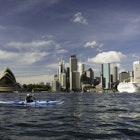
Jun 19, 2024 • 7 min read

May 21, 2024 • 5 min read

Mar 4, 2024 • 8 min read

Nov 5, 2023 • 16 min read
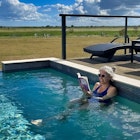
Aug 1, 2023 • 4 min read

Jan 2, 2023 • 12 min read
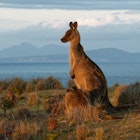
Nov 24, 2022 • 4 min read

Aug 24, 2022 • 4 min read

- PERPETUAL PLANET
Behind the scenes of a close crocodile encounter
A marine sanctuary teems with life, including a curious crocodile. A photographer has just seconds to decide: intervene or take a picture?
David Doubilet: Gardens of the Queen National Park is a marine sanctuary formed by a necklace of keys, mangrove islets, and reefs about 60 miles south of mainland Cuba. On a previous assignment with my wife and photographic partner, Jennifer Hayes, we’d documented healthy coral reefs pulsing with fish and sharks, and mangroves patrolled by crocodiles. We knew that time, increased tourism, and climate change could alter the 850-square-mile national park—so 15 years later, we returned to see how it was faring.
We were in a mangrove channel photographing Cassiopeia, aka the upside-down jellyfish. Jennifer, her back to me, was focused on a specimen above her. Out of the corner of my viewfinder, I saw a sizable American crocodile drifting downstream. As I began to take its photograph, I realized that the crocodile was going to drift directly between Jennifer and me.
I started to make loud noises through my regulator and moved toward Jen, firing a burst of flash-lit shots to warn her that we had company. She quickly detected my signal and turned to meet our visitor.
Jennifer Hayes: I found myself face-to-snout with an American crocodile . Both surprised and very pleased, I greeted him through my regulator.

DD: She gave me a quick thumbs-up, nodded OK, and burbled an audible “Helloooo, handsome” as she bent closer to take its portrait (shown above). I marveled as she addressed the crocodile with respect, calm curiosity, and absolute joy. She settled in to capture the moment without missing a beat.
JH: I didn’t feel threatened. For several days I’d watched these crocodiles wander about, investigate things in the mangroves, chase fish in circles for fun, and sleep within view of us. Many of them swam with snorkelers on a daily basis. I felt familiar with their behavior—and I had a big SEACAM underwater housing that could double as a mighty shield if needed.
But I want to be clear: I was comfortable with this species of crocodile in this particular place at that particular time. I would not have been comfortable with a more aggressive species, such as a Nile or saltwater crocodile, in a different environment.
DD: When people see the image of the crocodile behind Jennifer, reactions include wonder, awe, and horror. But after a few frames the croc, unimpressed with us, drifted downstream on its way to do other crocodile things. We continued our quest for jellyfish.
JH: Many people ask if I’m angry that David took a picture instead of trying to “save” me. My answer is this: I would have been unhappy if he had not taken the photos. I was a visitor in this creature’s environment, and it was compelled to investigate. This is what I hope for on assignment—I’m not afraid but thrilled to see such an ancient creature.
DD: There is always risk in our line of work. Jennifer and I have aborted many dives with aggressive animals—for our safety and theirs. But this encounter reinforced the good news that we saw all around us in Gardens of the Queen. The crocodile is an indicator species, a symbol of a healthy marine ecosystem that can support apex predators (unlike overfished and degraded areas elsewhere in the Caribbean).
This preserve is a conservation success because it is actively patrolled and protected. The easing of travel restrictions is bound to bring more tourists—so it’s vital to maintain a balance among ecotourism, exploration, and conservation. That’s possible if visitors adopt the same philosophy that we hold toward that curious crocodile and every other marine creature. We enter Earth’s oceans on their terms, not our own.
Related Topics
- UNDERWATER PHOTOGRAPHY
- WILDLIFE PHOTOGRAPHY
- PHOTOGRAPHY
- MARINE SANCTUARIES
- ENVIRONMENT AND CONSERVATION
You May Also Like

7 extraordinary photographers share the stories behind their most iconic images

These images will help you see coral reefs in a whole new way

The Gulf of Maine is warming fast. What does that mean for lobsters—and everything else?

Palau’s waters are some of the most biodiverse in the world—thanks to its defenders

American crocodiles are spreading north in Florida. That’s a good thing.
- Environment
- Paid Content
History & Culture
- History & Culture
- Destination Guide
- Terms of Use
- Privacy Policy
- Your US State Privacy Rights
- Children's Online Privacy Policy
- Interest-Based Ads
- About Nielsen Measurement
- Do Not Sell or Share My Personal Information
- Nat Geo Home
- Attend a Live Event
- Book a Trip
- Inspire Your Kids
- Shop Nat Geo
- Visit the D.C. Museum
- Learn About Our Impact
- Support Our Mission
- Advertise With Us
- Customer Service
- Renew Subscription
- Manage Your Subscription
- Work at Nat Geo
- Sign Up for Our Newsletters
- Contribute to Protect the Planet
Copyright © 1996-2015 National Geographic Society Copyright © 2015-2024 National Geographic Partners, LLC. All rights reserved
- Search Please fill out this field.
- Manage Your Subscription
- Give a Gift Subscription
- Newsletters
- Sweepstakes
- Destinations
- Australia & South Pacific
‘Crocodile Dundee’ Turns 30: How Paul Hogan Changed Tourism in Australia
U.S. audiences were first introduced to Mick “Crocodile” Dundee on Sept. 26, 1986.
Jessica Plautz is the director of content operations at Dotdash Meredith. She previously served as the deputy digital editor of Travel + Leisure . Before joining T+L, Jessica was a travel editor at Mashable .
On Sept. 26, 1986, “Crocodile Dundee” hit theaters in the United States, and Paul Hogan became the face of Australia.
The film, about an Australian bushman who shows a New York journalist the outback before following her back for his first visit to the big city, presented a narrative—and a man—that would define the continent to audiences around the world.
For better or worse—and over the past 30 years it has primarily been for better—the 1986 film is intrinsically linked to the continent.
The story of how it happened, and how Paul Hogan became Australia's representative around the world, is about as fantastic as the film's plot.
The star of “Crocodile Dundee” was no stranger to American television audiences of the 1980s.
He had already made an impact on tourism to Australia, as documented by Jesse Desjardins in a master's thesis on the phenomenon of “Dundee,” in an advertising campaign where he offered to put another “shrimp on the barbie” for visitors to the “wonder down under”:
Hogan spent 10 years working construction before brushing with fame, first making a name for himself with Australian audiences on a show called “New Faces.” On the show, contestants would perform a talent only to be ridiculed by the show's judges. (Simon Cowell had nothing on these guys.)
Hogan had joked with his fellow construction workers about the show, and then in 1971 wrote in to be a contestant saying he was a “ knife-throwing tap dancer .” He got on (because who wouldn't want to see a knife-throwing tap dancer?) and then he spent his time on the show insulting the judges.
The audience ate it up, and “Hoges”' appearances on “New Faces” got him a regular bit on a television news show where he met John Cornell, a journalist-turned-television-producer who became his business partner. After they parlayed his television fame into two wildly successful advertising endorsements—for Winfield cigarettes and Fosters beer, of course—Hogan donated his time to the tourism ads , slowly but surely building an audience in America for his brand of Australia. In retrospect, the pair's strategy looks like it was all done to lead up to “Crocodile Dundee,” which turned Hogan's Australian everyman bit into a blockbuster movie character.
But while Cornell and Hogan had their eyes on the Hollywood prize, as the The New York Times reported in 1988 , they incidentally filmed the best destination advertisement ever created.
The Locations
The iconic images of the “outback” in “Crocodile Dundee” (and “Crocodile Dundee II”) were filmed in Kakadu National Park, the location of a former uranium mine in the Northern Territory outside of Darwin.
“In ’86, Australians hadn't even been to Kakadu, let alone Americans,” Peter Hook, communications manager at Kakadu Tourism, told Travel + Leisure . “Basically Kakadu was a mining area. Uranium was its biggest mineral. The government actually built a road from Darwin to Kakadu—not for tourism, but for mining.”
Today, there are roads to take visitors to those ancient, scenic vistas, but that wasn't the case in 1986. To get a professional film crew to the area was a feat.
The choice of Kakadu for “Crocodile Dundee” came down to a man named Craig Bolles.
“The location was terribly important for the film,” Bolles, who did all the location scouting in Australia, told Kakadu Tourism earlier this year . “It showcased a part of Australia that I don’t think had been seen...and it was inherent in Paul’s nature. He seemed to fit into the landscape perfectly.”
Hogan had grown up in a Sydney suburb, but it was Kakadu that became his cinematic home.
“I had an open brief to choose anywhere in Australia that I thought suitable,” said Bolles, who also considered the northwest region of Kimberley, but ruled it out as too extreme. And Kakadu already posed many challenges for filming.
“Kakadu was a very different place in the 1980s to what it is today,” he said. “Only the main road was sealed (paved) and there were no hotel facilities at all as far as I can remember.”
In fact, it didn't seem there was anywhere for the crew to stay, until Bolles—who spent weeks on making it physically possible for crews and equipment to reach places like Jim Jim Falls and Gunlom Waterfall Creek—happened upon abandoned housing for miners the government had put in.
As anyone who has seen the film knows, the effort paid off.
“Certainly there has been no other place in Australia that has been so well represented and well captured as Hogan did for Kakadu,” Hook told T+L. “It's hard to imagine that anybody could do it as genuinely as he did. ”
The Phenomenon
On a budget of a little more than $7 million, “Crocodile Dundee” brought in more than $300 million at the box office.
Released two years later, “Crocodile Dundee II” repeated that success, bringing in almost $240 million .
Hook says “Crocodile Dundee” couldn't have come out at a better time.
“The timing also was very important, because mid-1980s was when we had a massive wave of American interest in Australia,” he said. “Airfares became a lot more accessible. The Australian dollar was quite low...and, interestingly, that's the scenario now.”
As for why it worked, Tourism Australia's Managing Director John O'Sullivan credits authenticity.
“It's about the genuine nature of the message and the characters within those films,” O'Sullivan told Travel + Leisure .
Tourism Today
Today Chris Hemsworth has taken on being the spokesperson for Australia , but Hogan's legacy is anything but forgotten.
“I think the tourism industry in Australia owes Paul Hogan a hell of a lot of gratitude,” said O'Sullivan.
In the past decade, local tourism offices and businesses all around Australia have joined together in an unprecedented effort to promote tourism to not just Sydney or Melbourne, but to all around Australia.
“One of the big challenges we're really seeking to address is certainly opening up more parts of the country,” said O'Sullivan. “A lot of people think that if you've come to Australia and you've done Sydney Harbor and the Great Barrier Reef, that's it.”
And though Tourism Australia and its many local counterparts are looking to the future, they can also look back for how to inspire travelers.
“In [the first 45 minutes of the film], you see the incredible billabongs...you see the landscapes, which people can see just as Hogan did in the film,” Hook, at Kakadu Tourism, told T+L.
“You look down, and you could be just like Paul Hogan, as if you're the only person in Kakadu. The sense of that you are seeing something special, and quite exclusive, I think that is still very much true to today,” he said. “You can go somewhere and be the only person in your own private rock pool.”
But there's more to it than landscapes, and as Mick Dundee emphasizes in the films, respect for the land and the people is integral to the country.
“The indigenous people of Kakadu go back 50,000 years, and you can get to sites in Kakadu where you can see the story unfolding in front of your eyes: the representations in art over 50,000 years,” said Hook. “I think that's the lesson for anyone who wants to come to Kakadu. Don't look at it like a theme park.”
There have been other films that have featured Australia's amazing landscapes, but according to many observers, “Crocodile Dundee” was unique.
“For me what that film and what he did [was bring] to life that we're a country of friendly and welcoming people,” said O'Sullivan. “[Hogan] certainly introduced the indigenous Australian culture into the U.S.”
“The difference with ‘Crocodile Dundee’ is the actual narrative of the film, this man outside his comfort zone, really resonated,” said Hook. “There was a depth to the film that's made it last.”
Related Articles

Meet Panchito, the croc who swims with tourists in a Tulum cenote.

Through an Instagram video, you can see a crocodile swimming very close to some tourists in the crystal clear waters of a cenote in Tulum.
TULUM QUINTANA ROO (Social Media) – The crocodile’s name is “Panchito.” He is of the Moreletii species, also known as “Mexican crocodile” and he is the inhabitant of the Cenote Manatí or Casa Cenote.
In the video -which has reached 490 thousand reproductions and 8 thousand 195 commentaries- youcan see Panchito peacefully swiming near the tourists.
Ver esta publicación en Instagram Una publicación compartida de sebitastrip ?♂️ (@sebitastrip)
Some users talked about the anxiety they felt seeing Panchito so close to the tourists, while others joked that the crocodile was a vegetarian. But the animal’s passivity, it is said, is because this species is considered harmless; moreover, they claim that he is used to human company.
Who is Panchito? In the video shared by the youtuber and tiktoker Sebitas Trip , you can observe Panchito swimming among the tourists without attacking them. This is because the crocodile came to the waters of the Cenote Manatí five years ago searching for fish. Since then, it has become common to see him in this place.
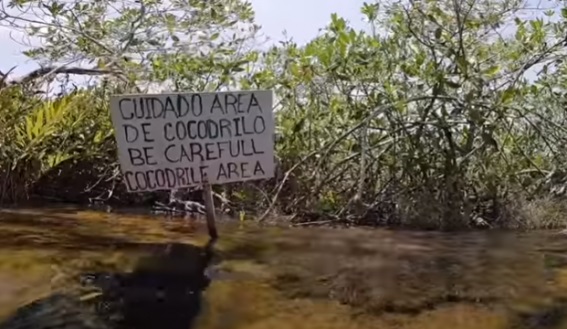
Photo: Tiktok
Panchito is a swamp crocodile that is characterized by being very territorial. Its diet is based on small mammals, birds, reptiles, amphibians, and fish, so, according to Sebitas Trip, humans are not seen as food. The only scenarios in which this species would attack a person are if they invade their territory or if their offspring are nearby. But Panchito is already used to the human presence.
The Manatee Cenote The Manatee Cenote is located on Federal Highway 307 on one side of the residential area Tankha, in Riviera Maya, in Quintana Roo, between Puerto Aventuras and Tulum.
https://www.facebook.com/CenoteManati/photos/a.241406062638841/1294474150665355
According to the site’s Facebook page, this cenote received that name because it was home to many manatees. Here you can find crystalline waters with different plays of light due to the natural illumination.
It has a depth of six meters, and you can see in its surroundings mangroves, coral reefs, rock formations, and cracks in the limestone. In the Cenote Manatí, you can also find a cave that flows into the sea.
https://www.facebook.com/CenoteManati/photos/750764618369647
If you decide to go to this cenote in the future, don’t forget the importance of respecting the Riviera Maya’s animal species, such as the Panchito crocodile.
Yucatan Times
Boat adrift in the alacranes reef rescued by state authorities and navy, psychoactive substance found in ancient mayan receptacles.

You may also like
Full internet coverage in all public schools in yucatan is a reality, us seizes venezuela president nicolas maduro’s airplane in the dominican republic, driver hospitalized after accident on the merida progreso, bicyclist found dead on the side of the road in san ignacio, centenario train: 69 years of journeys and history in mérida, the new congress of the state of yucatan takes office, our company.
Lorem ipsum dolor sit amet, consect etur adipiscing elit. Ut elit tellus, luctus nec ullamcorper mattis.
- 01 Central Park, US, New York City
- Phone: (012) 345 6789
- Email: [email protected]
- Support: [email protected]
About Links
- Advertise With Us
- Media Relations
- Corporate Information
- Apps & Products
Useful Links
- Privacy Policy
- Terms of Use
- Closed Captioning Policy
- Accessibility Statement
- Personal Information
- Data Tracking
- Register New Account
This website uses cookies to improve your experience. We'll assume you're ok with this, but you can opt-out if you wish. Accept
This website uses modern construction techniques, which may not render correctly in your old browser. We recommend updating your browser for the best online experience.
Visit browsehappy.com to help you select an upgrade.
- How Paul Hogan Changed Tourism in Australia
On Sept. 26, 1986, “Crocodile Dundee” hit theaters in the United States, and Paul Hogan became the face of Australia. To celebrate the 30th anniversary of the screening of Crocodile Dundee in the USA, Jessica Plautz, a reporter for America’s most famous travel magazine, Travel + Leisure, looked back at the film and its impact on the way the rest of the world saw Australia.
by Jessica Plautz September 26, 2016 Full story can be viewed at: http://www.travelandleisure.com/culture-design/tv-movies/crocodile-dundee-australia-tourism
The film, about an Australian bushman who shows a New York journalist the outback before following her back for his first visit to the big city, presented a narrative—and a man—that would define the continent to audiences around the world.
For better or worse—and over the past 30 years it has primarily been for better—the 1986 film is intrinsically linked to the continent.
by Jessica Plautz, Travel + Leisure (USA) September 26, 2016 The story of how it happened, and how Paul Hogan became Australia’s representative around the world, is about as fantastic as the film’s plot.
“Hoges” The star of “Crocodile Dundee” was no stranger to American television audiences of the 1980s.
He had already made an impact on tourism to Australia, as documented by Jesse Desjardins in a master’s thesis on the phenomenon of “Dundee,” in an advertising campaign where he offered to put another “shrimp on the barbie” for visitors to the “wonder down under”:
Hogan spent 10 years working construction before brushing with fame, first making a name for himself with Australian audiences on a show called “New Faces.” On the show, contestants would perform a talent only to be ridiculed by the show’s judges. (Simon Cowell had nothing on these guys.)
Hogan had joked with his fellow construction workers about the show, and then in 1971 wrote in to be a contestant saying he was a “knife-throwing tap dancer.” He got on (because who wouldn’t want to see a knife-throwing tap dancer?) and then he spent his time on the show insulting the judges.
The audience ate it up, and “Hoges”’ appearances on “New Faces” got him a regular bit on a television news show where he met John Cornell, a journalist-turned-television-producer who became his business partner. After they parlayed his television fame into two wildly successful advertising endorsements—for Winfield cigarettes and Fosters beer, of course—Hogan donated his time to the tourism ads, slowly but surely building an audience in America for his brand of Australia. In retrospect, the pair’s strategy looks like it was all done to lead up to “Crocodile Dundee,” which turned Hogan’s Australian everyman bit into a blockbuster movie character.
But while Cornell and Hogan had their eyes on the Hollywood prize, as the The New York Times reported in 1988, they incidentally filmed the best destination advertisement ever created.
The Locations The iconic images of the “outback” in “Crocodile Dundee” (and “Crocodile Dundee II”) were filmed in Kakadu National Park, the location of a former uranium mine in the Northern Territory outside of Darwin.
“In ’86, Australians hadn’t even been to Kakadu, let alone Americans,” Peter Hook, communications manager at Kakadu Tourism, told Travel + Leisure.
“Basically Kakadu was a mining area. Uranium was its biggest mineral. The government actually built a road from Darwin to Kakadu—not for tourism, but for mining.”
Today, there are roads to take visitors to those ancient, scenic vistas, but that wasn’t the case in 1986. To get a professional film crew to the area was a feat.
The choice of Kakadu for “Crocodile Dundee” came down to a man named Craig Bolles.
“The location was terribly important for the film,” Bolles, who did all the location scouting in Australia, told Kakadu Tourism earlier this year. “It showcased a part of Australia that I don’t think had been seen…and it was inherent in Paul’s nature. He seemed to fit into the landscape perfectly.”
Hogan had grown up in a Sydney suburb, but it was Kakadu that became his cinematic home.
“I had an open brief to choose anywhere in Australia that I thought suitable,” said Bolles, who also considered the northwest region of Kimberley, but ruled it out as too extreme. And Kakadu already posed many challenges for filming.
“Kakadu was a very different place in the 1980s to what it is today,” he said. “Only the main road was sealed (paved) and there were no hotel facilities at all as far as I can remember.”
In fact, it didn’t seem there was anywhere for the crew to stay, until Bolles—who spent weeks on making it physically possible for crews and equipment to reach places like Jim Jim Falls and Gunlom Waterfall Creek—happened upon abandoned housing for miners the government had put in.
As anyone who has seen the film knows, the effort paid off.
“Certainly there has been no other place in Australia that has been so well represented and well captured as Hogan did for Kakadu,” Hook told T+L. “It’s hard to imagine that anybody could do it as genuinely as he did. ”
The Phenomenon On a budget of a little more than $7 million, “Crocodile Dundee” brought in more than $300 million at the box office.
Released two years later, “Crocodile Dundee II” repeated that success, bringing in almost $240 million.
Hook says “Crocodile Dundee” couldn’t have come out at a better time.
“The timing also was very important, because mid-1980s was when we had a massive wave of American interest in Australia,” he said. “Airfares became a lot more accessible. The Australian dollar was quite low…and, interestingly, that’s the scenario now.”
As for why it worked, Tourism Australia’s Managing Director John O’Sullivan credits authenticity.
“It’s about the genuine nature of the message and the characters within those films,” O’Sullivan told Travel + Leisure.
Tourism Today Today Chris Hemsworth has taken on being the spokesperson for Australia, but Hogan’s legacy is anything but forgotten.
“I think the tourism industry in Australia owes Paul Hogan a hell of a lot of gratitude,” said O’Sullivan.
In the past decade, local tourism offices and businesses all around Australia have joined together in an unprecedented effort to promote tourism to not just Sydney or Melbourne, but to all around Australia.
“One of the big challenges we’re really seeking to address is certainly opening up more parts of the country,” said O’Sullivan. “A lot of people think that if you’ve come to Australia and you’ve done Sydney Harbor and the Great Barrier Reef, that’s it.”
And though Tourism Australia and its many local counterparts are looking to the future, they can also look back for how to inspire travelers.
“In [the first 45 minutes of the film], you see the incredible billabongs…you see the landscapes, which people can see just as Hogan did in the film,” Hook, at Kakadu Tourism, told T+L.
“You look down, and you could be just like Paul Hogan, as if you’re the only person in Kakadu. The sense of that you are seeing something special, and quite exclusive, I think that is still very much true to today,” he said. “You can go somewhere and be the only person in your own private rock pool.”
“The indigenous people of Kakadu go back 50,000 years, and you can get to sites in Kakadu where you can see the story unfolding in front of your eyes: the representations in art over 50,000 years,” said Hook. “I think that’s the lesson for anyone who wants to come to Kakadu. Don’t look at it like a theme park.”
The Legacy There have been other films that have featured Australia’s amazing landscapes, but according to many observers, “Crocodile Dundee” was unique.
“For me what that film and what he did [was bring] to life that we’re a country of friendly and welcoming people,” said O’Sullivan. “[Hogan] certainly introduced the indigenous Australian culture into the U.S.”
“The difference with ‘Crocodile Dundee’ is the actual narrative of the film, this man outside his comfort zone, really resonated,” said Hook. “There was a depth to the film that’s made it last.”
http://www.travelandleisure.com/culture-design/tv-movies/crocodile-dundee-australia-tourism
- FB icon Follow us on Facebook
- insta icon Follow us on Instagram

The annual @million_dollar_fish competition is back from 01 October giving fisho's the chance to win $1 million! Registrations are now open so head over to their website so you're in for a chance to win: milliondollarfish.com.au Will we more lucky winners at Kakadu? 🤞🏼 #milliondollarfish #fishos #fishingtips #dokakadu

📷 Get your camera ready! A new tour "Lightning Dreaming Tour" has been announced by Northern Territory wildlife and landscape photographer Paul Thomsen. A once in a lifetime Northern Territory Wet Season Experience, this 7 night tour will see guests spend 5 nights in Kakadu and 2 nights at the Finniss River Lodge where you'll enjoy incredible natural landscape and wildlife photography in the wild Top End, for all levels of experience. 📸 Includes: workshops and special access to amazing photography locations. 📸 Dates: December 4-11th from Darwin and numbers are limited. 📸 Leading NT photographers Paul Thomsen (Wildfoto) and Etienne Littlefair (Wild Territory Images) will be your guides! To find out more or to secure your spot, visit: wildfoto.au/lightningdreamingtour #wildlifephotography #topend #topendnt #naturephotography #photographytour

📣 Just dropped - the Outback Retreat at @cooindalodgekakadu is now just $249* per night! 🤩 Built on an elevated platform to ensure year-round usability and minimal environmental impact Cooinda's Outback Retreat safari tents offer an enchanting escape into the Australian wilderness, perfect for a couple getaway or a family adventure! Their harmonious blend of comfort and nature make these canvas sanctuaries redefine the notion of camping; each interior meticulously designed to reflect the unique landscape of Kakadu with an array of locally designed elements. Our Outback Retreats feature their own luxurious shared bathroom and amenities block, which include laundry facilities and a small kitchenette, ensuring a delightful and convenient stay for our guests. And if you’re travelling with the kids, book the Outback Retreat Family with bunk beds, separated by a dividing wall. Be quick, this special offer is available now for stays until 13 October, 2024. Book online at: kakadutourism.com or see link in bio 👆🏼 * Subject to availability. Must be pre-paid and is non-refundable. Book and travel by 13 October, 2024.

🐦 Kakadu Bird Week | 26 - 29 September Bird Week is a spectacular event that coincides with the dramatic mass migration of magpie geese. These magnificent birds flock to the billabongs, like Yellow Water (Ngurrungurrudjba), to feed, creating a breathtaking spectacle as the waters recede towards the end of the dry season. This is the perfect time to witness not only the diverse birdlife but also Kakadu’s impressive array of exotic wildlife, including crocodiles, buffalo, brumbies, and wallabies. Join our local NT Bird Specialist, Luke Paterson, during select morning and afternoon cruises during Kakadu Bird Week where Luke will focus on the bird life in the area whilst sharing his expertise on many of the 280+ bird species in the area. Don’t forget your binoculars and zoom lens! Book your Bird Week cruise now: https://app.respax.com/public/kt/tourinformation/BRDWK #birdweek #kakadubirdweek #ntaustralia #lukepaterson #yellowwatercruise #booknow #twitcher #birdlover #naturelover

Did you know that Parks Australia offers a range of Bininj/Mungguy led FREE activities from 29 May to 4 October 2024. It is a great opportunity to connect with our Bininj/Mungguy (Aboriginal) Country and Culture as Bininj/Mungguy guide you through some of Kakadu’s stunning sites. The activities include: 👉🏼 Nawurlandja sunset walk 👉🏼 Anbangbang billabong walk 👉🏼 Kungardun bush walk 👉🏼 Ubirr Rock Art and Sunset Experience 👉🏼 Cahills Crossing Croc Talk Bookings are handled through Eventbrite. Group sizes are limited and you will need to bring your park pass, visitor guide and arrive at your activity site 10 minutes early. For more information on seasonal guided activities, please call the Bowali Visitor Centre on 08 8938 1120. Images from @seekakadu [IG] #kakadutours #rangertours #parkranger #dokakadu
Visit Kakadu
- About Kakadu
- Where to Stay
- See & Do
- Build My Itinerary
- Media & Blog
Stay Connected
Exclusive specials and announcements!

© Copyright 2023 - 2024 Kakadu Tourism
- Terms & Conditions
site by Karmabunny
Winter is here! Check out the winter wonderlands at these 5 amazing winter destinations in Montana
- Travel Destinations
- Australia & South Pacific
It’s Always Croc Season In Darwin And The Top End
Published: September 7, 2023
Modified: December 27, 2023
by Jeri Samson
- Safety & Insurance
- Travel Tips
Introduction
Welcome to the land down under, where the land itself is as wild as the creatures that inhabit it. Australia, known for its diverse wildlife, boasts some of the most unique and fascinating animals on the planet. And when it comes to dangerous predators, few can rival the fearsome reputation of the crocodile.
Nowhere is this more evident than in Darwin and the Top End of Australia. Here, crocodiles are not just a tourist attraction, but a way of life. The region is home to a large population of saltwater crocodiles, often referred to as “salties” by the locals. These apex predators dominate the waterways, effortlessly gliding through the murky depths and lurking in the shadows, waiting for an opportune moment to strike.
Visitors to Darwin and the Top End are in for a unique and thrilling experience, as they navigate the delicate balance between human activities and the natural habitat of these prehistoric creatures. From crocodile cruises and wildlife parks to adrenaline-pumping crocodile encounters, there are plenty of opportunities to get up close and personal with these ancient reptiles.
But before delving into the world of crocodiles in Darwin and the Top End, it’s important to understand their habitats, the different species found in the region, conservation efforts, safety tips for visitors, popular crocodile spotting locations, the emergence of crocodile tourism, and the stark realities of crocodile attacks.
So fasten your seatbelts and prepare for an adventure like no other. It’s time to dive into the world of crocodiles in Darwin and the Top End, where it’s always croc season.
Crocodiles in Darwin and the Top End
Darwin and the Top End region of Australia are known for their thriving population of crocodiles. These magnificent creatures have been roaming the waterways for millions of years, adapting and evolving in response to the ever-changing environment.
One of the primary reasons for the prevalence of crocodiles in this region is the presence of suitable habitats. The lush mangrove forests, expansive wetlands, and meandering river systems provide the ideal conditions for these reptiles to thrive. The warm climate and abundant food sources further contribute to their numbers.
The Top End is home to two species of crocodiles: the saltwater crocodile (Crocodylus porosus) and the freshwater crocodile (Crocodylus johnstoni). The saltwater crocodile, also known as the estuarine crocodile, is the largest living reptile on Earth and can grow up to 6 meters in length. They are well-known for their powerful jaws, incredible strength, and ability to ambush their prey.
On the other hand, the freshwater crocodile is smaller in size, typically reaching lengths of around 3 meters. They are more timid and less aggressive compared to their saltwater counterparts. Freshwater crocodiles are commonly found in rivers, billabongs, and inland water systems, away from the brackish and saltwater environments preferred by saltwater crocodiles.
Despite their fearsome reputation, crocodiles in Darwin and the Top End play a vital role in the ecosystem. They are apex predators and help maintain the balance of the local food chain. By regulating the population of prey species, they ensure the overall health and sustainability of the region’s biodiversity.
As a result, there are ongoing efforts to conserve and protect crocodile populations in the area. Various management strategies are in place to minimize human-crocodile encounters and promote coexistence between humans and these ancient reptiles. These efforts include educational campaigns, crocodile tagging programs, and the establishment of designated crocodile habitats.
Understanding the behavior, habitats, and ecological importance of crocodiles in Darwin and the Top End is essential for both residents and visitors. By respecting their natural environment and following safety guidelines, we can appreciate and enjoy the presence of these magnificent creatures while minimizing the risks associated with their presence.
Crocodile Habitats
Crocodiles are incredibly adaptable creatures, capable of surviving in a wide range of habitats. In Darwin and the Top End region of Australia, these reptiles have established their territories in diverse environments, each offering unique advantages for their survival.
The primary habitats for crocodiles in this region are the mangrove forests, wetlands, and river systems. Mangroves provide an ideal setting for these reptiles, offering shelter, warmth, and abundant food sources. The dense network of roots and branches creates a labyrinth of hiding spots, allowing crocodiles to sneak up on their prey and ambush them with remarkable precision.
Wetlands, including billabongs, swamps, and floodplains, are another crucial habitat for crocodiles in Darwin and the Top End. These expansive areas offer shallow waters and plenty of vegetation, attracting a variety of animals, both terrestrial and aquatic. Crocodiles thrive in these wetlands, utilizing the cover of vegetation to hide and patiently wait for an opportunity to strike.
Additionally, river systems are a major crocodile habitat in the region. With their deep channels and extensive networks, rivers provide an excellent platform for crocodiles to hunt and move around. The mix of freshwater and saltwater environments along these rivers supports both freshwater and saltwater crocodile populations, each adapted to their preferred water conditions.
While saltwater crocodiles are often associated with coastal regions, they are also found in inland water systems, including rivers, estuaries, and even sometimes in freshwater billabongs. Freshwater crocodiles, on the other hand, primarily inhabit freshwater bodies such as rivers, billabongs, and smaller waterways.
It’s worth noting that crocodiles are territorial creatures, with each individual staking out its own area. They fiercely defend their territories from other crocodiles, making habitat availability a crucial factor in determining their population density in certain areas.
Understanding the diverse habitats of crocodiles in Darwin and the Top End is essential for both researchers and tourists. It allows us to appreciate the adaptability of these ancient reptiles and the significance of preserving their habitats for the overall health of the local ecosystem.
Crocodile Species Found in the Region
Darwin and the Top End of Australia are home to two distinct species of crocodiles: the saltwater crocodile (Crocodylus porosus) and the freshwater crocodile (Crocodylus johnstoni). While both species share some similarities, they have distinct characteristics and ecological preferences.
The saltwater crocodile, also known as the estuarine crocodile, is the largest living reptile on Earth. Males can grow up to 6 meters in length, and females typically reach about 3-4 meters. They have a robust build, powerful jaws, and a reputation for being formidable apex predators.
Saltwater crocodiles are well-adapted to both saltwater and brackish environments, such as estuaries, coastal mangroves, and freshwater river systems. They have a remarkable ability to regulate their salt levels, allowing them to venture into various habitats. This adaptability has contributed to their widespread distribution across the Top End region.
In contrast, freshwater crocodiles are smaller in size, usually growing up to 3 meters in length. They have a more slender build and a longer, narrower snout compared to saltwater crocodiles. This species predominantly inhabits freshwater ecosystems, including rivers, billabongs, and inland waterways away from the coastal areas.
Freshwater crocodiles have a less aggressive nature and are more tolerant of human presence. They primarily feed on fish, crustaceans, and small reptiles, and they are known for their ability to bask in the sun, often seen perched on rocks or logs near the water’s edge.
Both saltwater and freshwater crocodiles are integral parts of the ecosystem in Darwin and the Top End. They play a crucial role in regulating prey populations, keeping a balance in the food chain, and contributing to the overall health of the region’s diverse habitats.
It’s important to note that while these crocodile species are fascinating to observe, precautions should be taken to ensure human safety and minimize any negative interactions. Understanding the characteristics and behavior of each species can help visitors make informed decisions and appreciate these impressive creatures from a safe distance.
Crocodile Conservation Efforts
Recognizing the importance of maintaining a healthy balance between humans and crocodiles, various conservation efforts have been implemented in Darwin and the Top End to protect these majestic creatures and their habitats. These initiatives aim to ensure the long-term survival of crocodile populations while minimizing the risks associated with human interactions.
One of the key strategies in crocodile conservation is education and awareness. Local authorities, wildlife organizations, and tour operators work together to educate residents and visitors about crocodile behavior, safety guidelines, and the importance of respecting crocodile habitats. This includes providing informational materials, conducting workshops, and promoting responsible tourism practices.
Crocodile research and monitoring programs are also vital for conservation efforts. Scientists and researchers study crocodile populations, behavior, and movements to gain insights into their ecological needs and behavior patterns. This information helps in the development of targeted management plans and the identification of critical habitat areas that require protection.
Crocodile tagging programs play a crucial role in monitoring crocodile populations. By tagging individuals with radio transmitters or GPS trackers, researchers can track their movements, study their interactions with their environment, and monitor population trends. This data helps inform effective management decisions and enables a better understanding of crocodile behaviors.
Designating protected areas and implementing specific management plans for these areas is another cornerstone of crocodile conservation. Establishing crocodile sanctuaries and protected habitats ensures that these reptiles have undisturbed areas to nest, breed, and thrive. These protected zones form important refuges where crocodile populations can grow and flourish without human interference.
Additionally, crocodile egg collection and relocation programs have been implemented to help mitigate potential conflicts between humans and crocodiles. These programs involve the relocation of crocodile nests from high-risk areas to designated hatcheries, where the eggs can safely hatch and the young crocodiles can be released into suitable habitats away from populated areas.
Conservation efforts also extend to local communities, as their cooperation and participation are fundamental to the success of crocodile conservation. Encouraging responsible behavior around crocodile habitats, such as avoiding swimming in crocodile-inhabited waters, not feeding crocodiles, and reporting any potential threats or sightings, is essential in maintaining a safe coexistence between humans and crocodiles.
By implementing these conservation measures, Darwin and the Top End strive to ensure that crocodiles remain a vital part of the region’s unique ecosystem, while safeguarding the well-being of both humans and these ancient reptiles.
Crocodile Safety Tips for Visitors
Visiting Darwin and the Top End of Australia offers an exciting opportunity to witness crocodiles in their natural habitat. However, it’s crucial to prioritize safety and understanding to prevent any potential conflicts or dangerous encounters with these powerful reptiles. Here are some essential crocodile safety tips for visitors:
- Stay informed: Educate yourself about crocodile behavior and habitats before your visit. Understand the local regulations and guidelines regarding crocodile interactions and follow them strictly.
- Observe from a safe distance: Keep a safe distance from crocodiles at all times. Use binoculars or zoom lenses to observe them without approaching too closely.
- Stick to designated areas: Stay within designated viewing platforms or areas that are considered safe for crocodile spotting. Do not venture into unmarked or unauthorized areas where crocodiles may be present.
- Do not feed crocodiles: Feeding crocodiles is not only dangerous but also detrimental to their natural behavior. Feeding can encourage aggressive behavior and create dependency on humans as a food source.
- Avoid swimming in crocodile-inhabited waters: Always swim in designated safe swimming areas and heed any warning signs indicating the presence of crocodiles. Never swim in rivers, estuaries, or billabongs where crocodiles may be present.
- Be cautious near the water’s edge: Keep a safe distance from the water’s edge, especially in areas known to have crocodiles. Remember that crocodiles can lunge out of the water with incredible speed, so remain vigilant at all times.
- Travel in groups: When exploring crocodile habitats, travel in groups rather than alone. This increases safety and ensures there are multiple sets of eyes watching for any potential crocodile activity.
- Do not provoke or harass crocodiles: Avoid any actions that may agitate or provoke a crocodile, such as loud noises, splashing, or throwing objects towards them. Respect their habitat and maintain a quiet and calm demeanor.
- Follow the advice of local guides: If participating in a crocodile-focused activity or tour, listen carefully to the instructions and guidance provided by experienced guides. They have extensive knowledge of crocodile behavior and can ensure your safety during the encounter.
- Report any crocodile sightings or concerns: If you come across a crocodile or suspect any potential risks, report it to the appropriate authorities or park rangers. They can assess the situation and take necessary actions to ensure public safety.
By following these crocodile safety tips, visitors can enjoy their time in Darwin and the Top End while minimizing the risks associated with wild crocodile encounters. Remember, respect for these powerful reptiles and their natural habitats is key to a safe and memorable experience.
Popular Crocodile Spotting Locations
Darwin and the Top End of Australia offer numerous opportunities for visitors to witness crocodiles in their natural habitats. From dedicated wildlife parks to scenic waterways, here are some popular crocodile spotting locations that provide unforgettable encounters with these ancient reptiles:
- Adelaide River: Located just south of Darwin, the Adelaide River is renowned for its abundance of saltwater crocodiles. Many tour operators offer crocodile cruises along the river, providing a safe and thrilling experience to observe these impressive creatures up close.
- Kakadu National Park: This UNESCO World Heritage Site is not only famous for its stunning landscapes and rich cultural history but also for its diverse wildlife, including crocodiles. Boat tours along waterways like the Yellow Water Billabong offer a chance to spot crocodiles basking in the sun or stealthily patrolling the waters.
- Mary River Region: The Mary River region, located east of Darwin, is home to one of the highest densities of saltwater crocodiles in Australia. The wetlands and river systems in this area offer excellent crocodile spotting opportunities, especially during the breeding season.
- Crocodylus Park: Situated just outside Darwin, Crocodylus Park is a must-visit for crocodile enthusiasts. The park houses a large collection of crocodiles, providing visitors with a chance to see these incredible creatures up-close and learn about their behaviors and conservation efforts.
- Corroboree Billabong: Located about 90 minutes from Darwin, Corroboree Billabong is a picturesque wetland renowned for its crocodile population. Boat tours take visitors through the billabong, allowing them to observe crocodiles and other wetland wildlife in their natural habitat.
- Mary River National Park: This expansive national park is known for its diverse wildlife, including its resident saltwater crocodile population. Visitors can take guided cruises or explore walking trails to catch glimpses of these impressive creatures in their native environment.
- Window on the Wetlands: Offering panoramic views of the wetlands surrounding the Adelaide River, the Window on the Wetlands Visitor Centre provides an opportunity to learn about the diverse ecosystems and spot crocodiles in action. Interpretive displays and viewing platforms offer great vantage points for observing these ancient reptiles.
- Litchfield National Park: While Litchfield National Park is most famous for its waterfalls and stunning landscapes, it’s also home to freshwater crocodiles. Visitors can safely observe these crocodiles in swimming areas such as Wangi Falls or at the banks of the Tiwi Art Site walk.
It’s important to note that crocodile spotting should be done with caution and respect for the safety guidelines in place. It’s always advisable to join organized tours or visit designated crocodile viewing areas where experienced guides can provide insightful information and ensure a safe experience for all.
So, get ready for an unforgettable adventure as you explore these popular crocodile spotting locations in Darwin and the Top End, immersing yourself in the wonders of the natural world and witnessing the power and beauty of these incredible reptiles.
Crocodile Tourism in Darwin and the Top End
When it comes to tourism in Darwin and the Top End, crocodiles play a significant role in attracting visitors from around the world. The region’s unique ecosystem, rich biodiversity, and the allure of witnessing these prehistoric creatures in their natural habitat make crocodile tourism a thriving industry.
Crocodile tours and cruises are one of the most popular ways for visitors to experience these ancient reptiles up close. Knowledgeable guides provide insights into crocodile behavior, habitats, and conservation efforts as they navigate the waterways. These tours offer a safe and exhilarating opportunity to observe crocodiles in their natural environment.
Furthermore, some wildlife parks and sanctuaries in the region provide educational programs and interactive experiences centered around crocodiles. Visitors can learn about crocodile conservation, witness feeding demonstrations, and even cuddle baby crocodiles under the supervision of experienced handlers.
For those seeking a more adventurous experience, cage diving or swimming with crocodiles is an option. With the utmost precaution and under the guidance of trained professionals, participants can get a close-up view of these fascinating creatures while inside a submerged cage.
Crocodile-themed events and festivals are also popular in Darwin and the Top End. The famous Crocodile Dundee Festival celebrates Australia’s crocodile heritage with a range of entertainment, including crocodile-themed competitions and showcases of local arts, crafts, and cuisine. These events offer a unique and immersive experience, blending entertainment with educational opportunities.
It’s important to note that while crocodile tourism is a thriving industry, responsible and sustainable practices are crucial in order to protect the welfare of both the crocodiles and the environment. Tour operators and wildlife parks adhere to strict regulations to minimize the impact of tourism activities on natural habitats and ensure the safety of both visitors and crocodiles.
By participating in crocodile tourism activities, visitors not only have the chance to witness one of nature’s most captivating creatures, but they also contribute to the local economy and support conservation efforts. Revenue generated from tourism often goes towards funding research, conservation programs, and initiatives aimed at preserving crocodile populations and their habitats.
Crocodile tourism in Darwin and the Top End invites visitors to immerse themselves in the natural wonders of the region, offering a unique opportunity to connect with these ancient reptiles and gain a deeper appreciation for their role in the ecosystem.
Crocodile Attacks: Facts and Statistics
Crocodile attacks, while relatively rare, are a sobering reminder of the inherent risks associated with being in close proximity to these powerful creatures. Understanding the facts and statistics surrounding crocodile attacks in Darwin and the Top End can help visitors make informed decisions and prioritize their safety when exploring crocodile-infested habitats.
It’s important to note that most crocodile attacks occur when humans unintentionally enter crocodile habitats or engage in high-risk behaviors. Here are some key facts and statistics regarding crocodile attacks:
- Species involved: Saltwater crocodiles are responsible for the majority of crocodile attacks on humans. Their immense size, strength, and aggressive nature make them potentially dangerous predators.
- Preventable incidents: Many crocodile attacks can be prevented by exercising caution and following safety guidelines. Engaging in activities such as swimming in crocodile-inhabited waters or approaching crocodiles in their natural habitat significantly increases the risk of an attack.
- Attack frequency: While specific statistics vary, crocodile attacks in Darwin and the Top End are relatively rare. The Australian government has implemented stringent measures to minimize the risks and ensure public safety in crocodile-prone areas.
- Tourist encounter safety: Crocodile tourism operators prioritize visitor safety and abide by strict regulations to ensure minimal risks during guided tours and cruises. Visitors should choose reputable operators and follow their instructions at all times.
- Recorded attacks: Despite precautions, occasional crocodile attacks do occur. It’s crucial to report any sighting or potential threat promptly to local authorities or park rangers to mitigate risks and prevent further incidents.
- Survival rates: The outcome of a crocodile attack can vary, depending on the circumstances and the response of the victim. Survival rates are influenced by factors such as the size of the crocodile, the severity of the attack, and the promptness of medical assistance.
- Shared responsibility: Crocodile safety is a shared responsibility between authorities, tourism operators, and individuals. Ongoing efforts in crocodile conservation and safety awareness help minimize risks and promote safe coexistence between humans and crocodiles.
While it’s important to be aware of the risks associated with crocodile encounters, it’s essential to approach these creatures with respect and caution. By adhering to safety guidelines, staying informed, and utilizing the services of reputable operators, visitors can enjoy the beauty and wonder of Darwin and the Top End while ensuring their own safety and the protection of these incredible reptiles.
Darwin and the Top End of Australia provide a remarkable opportunity to explore the world of the ancient and formidable crocodiles. These reptiles, known for their size, strength, and primal nature, inhabit the diverse habitats of the region, making crocodile encounters a thrilling and immersive experience.
From the murky waters of the Adelaide River to the expansive wetlands of Kakadu National Park, crocodile enthusiasts have a range of popular spots to witness these creatures in their natural environment. Tour operators, wildlife parks, and educational programs offer opportunities to observe and learn about these ancient reptiles while promoting responsible and safe practices.
Crocodile conservation efforts in Darwin and the Top End are essential for the long-term survival of both crocodile populations and the delicate ecosystems they inhabit. Through education, research, and habitat protection, these efforts aim to ensure a harmonious coexistence between humans and crocodiles, while maintaining the region’s unique biodiversity.
While crocodile encounters can be exhilarating, it’s vital to prioritize safety and adhere to guidelines provided by local authorities and experienced tour operators. Respecting crocodile habitats, understanding their behavior, and following established safety protocols can minimize the risks associated with these powerful predators.
By appreciating the natural beauty and diversity of Darwin and the Top End while safeguarding the well-being of both humans and crocodiles, we can create a sustainable and enjoyable environment for all. So, embark on your journey to the land down under, where it’s always croc season, and enjoy the marvels of these ancient reptiles in their wild and untamed habitats.

- Privacy Overview
- Strictly Necessary Cookies
This website uses cookies so that we can provide you with the best user experience possible. Cookie information is stored in your browser and performs functions such as recognising you when you return to our website and helping our team to understand which sections of the website you find most interesting and useful.
Strictly Necessary Cookie should be enabled at all times so that we can save your preferences for cookie settings.
If you disable this cookie, we will not be able to save your preferences. This means that every time you visit this website you will need to enable or disable cookies again.
The return of crocodile rule
Topic: Animal Science
A crocodile sunbakes on the banks of the Daly River. ( ABC News: Michael Franchi )
The Northern Territory's saltwater crocodile population has soared since the species was almost shot to extinction 50 years ago. Now crocs are getting bigger and edging closer to urban centres.
In the hothouse blooms of Australia's tropical north, these canopies have been hiding a big secret.
Underneath, in January this year, wildlife rangers removed a crocodile nest.
The discovery was less than 1 kilometre from the suburban fringes.
The nest was found at the edge of Palmerston, a city of approximately 40,000 people, about a 15-minute drive south of Darwin.
Rangers in the Northern Territory are used to seeing crocodiles on their patrols. In the past 50 years, saltwater crocodile numbers in the NT have grown from 3,000 to 100,000.
Aboriginal and Torres Strait Islander readers are advised that this article may contain images of people who have died.
But this was the first time the saltwater crocodile, one of the deadliest predators on the planet, had been recorded laying eggs within 50 kilometres of the NT's capital city.
The find baffled Ian Hunt, a crocodile ranger with the NT government.
"It's really bizarre to find a nest up here … It's real close," Hunt says.
Yusuke Fukuda, a leading crocodile researcher in the Territory, is working to find out where the crocodile has come from.
To unravel the mystery, in his laboratory Fukuda takes a DNA sample from the hatchling.
Hundreds of crocodiles are trapped in Darwin Harbour each year, and Fukuda is building a database that maps their origins.
He says the nest discovery near Palmerston is a sign the Top End's migratory crocodiles are pushing into new places.
"I think it means good crocodile breeding habitats are getting saturated," he says.
"We might be finding more and more nests where we think they should not be, or where we do not think they would be."
Survival instinct
At Crocodylus Park, a tourist attraction on the outskirts of Darwin, park owner and croc expert Grahame Webb points to one of his biggest crocodiles.
"Crocodiles are predators, serious predators, and they've been preying on … people all through human evolution," he says.
Crocodiles, and experiences like a croc cruise at Webb's park, are synonymous with the Territory.
But for a long time, it was rare to see a large crocodile in the wild in the NT.
Only 50 years ago, large numbers of saltwater crocodiles were being killed by hunters, as depicted in this vision from the National Film and Sound Archive.
Hunting pushed crocodiles to the brink of extinction in the NT.
It was estimated at the time that from the end of World War II, 113,000 crocodile skins had been exported from the NT.
It left the croc population teetering at a perilously low 3,000.
But a hunting ban, introduced in 1971 in response to fears the lucrative resource would vanish and evolving societal attitudes to wildlife protection, saved the species from extinction.
The NT's crocs have now been a protected species for decades.
Yearly monitoring reports indicate there are now 100,000 saltwater crocodiles swimming around the NT.
Experts say while the crocodile population has stabilised, crocodiles are getting bigger on average each year as more of them reach maturity.
NT government monitoring of Top End rivers has found a shift in the total weight of crocodiles observed.
"In broad terms, there has been a decline in the proportion of crocodiles in the 1-to-3-metre size range in the population in recent years, and increases in the proportion of crocodiles in the 3-to-4-metre size range and in the proportion greater than 4 metres in length," a 2019 monitoring report says.
In the NT's waterways, big crocs are abundant in places where Territorians once swam without fear.
Living with crocodiles
Contact between humans and crocodiles in the wild doesn't get much closer than on the Top End's Daly River, about 220 kilometres south of Darwin.
This kind of protected landscape is the lure for many visitors to the NT.
The river is a mecca for barramundi fishers.
Pulling big fish out of a croc habitat into little boats, anglers are particularly alert to the re-emergence of the species.
"We don't want to count [croc] numbers anymore," Rob Cook, a fisher on the Daly, says.
However, increasing croc numbers is not the only thing concerning anglers.
"They seem to interact a lot more with boats now than they used to," Cook says.
These trends are making some on the water nervous, sparking calls for a culling program.
"Once I think they start doing that, the crocs will be a bit scared of the boats like they used to be," says Russell Walton, who fishes in the Daly every year.
Stuart Brisbane has made a living on the same river with his fishing business since the 1990s.
And he has seen the crocodile population soar.
"People used to swim in the river here," he says.
"But you wouldn't swim here now."
For Brisbane, however, culling would be contrary to the Territory way of life.
"The scenery, it's untouched. The birdlife, the crocodiles … there's not many places left that are like that."
Eyeing a crocodile swimming around his boat, he says he does not think humans need to take up arms again.
"It's their backyard, they live here," he says.
"If they're not causing a huge problem to us, why disturb them?"
However, overly familiar crocodiles — and calls for a cull — aren't new to the Top End's rivers.
The calls date back to the late '70s when, around the time of two fatal attacks, the notorious 5.1 metre "Sweetheart" began regularly attacking dinghies at a popular fishing spot.
Back in Darwin, wildlife researchers Erin and Adam Britton have been tracking crocodile attacks in Australia and around the world through their online database.
And they’ve discovered some trends in the data compiled from more than 5,250 incidents in Australia and overseas .
Erin says the data shows the likelihood of a crocodile attack rises the longer an area goes without an incident.
"We've found that the vast majority of crocodile attacks are occurring because locals feel quite comfortable with interacting with crocodiles in the environment and they're taking far more risks," she says.
From 2005 to 2014, 15 people were killed in crocodile attacks in the NT.
Since 2014, there have been only two fatal attacks, both in 2018.
Frightful beauty
Stunning sunsets are a staple of life in the Top End.
And when the raging heat of the day softens, and the sun descends on the horizon, this is when families flock to Darwin's beautiful beaches.
Beach-going is part of the lifestyle of many Territorians, despite full knowledge there could be deadly animals lurking in the water.
"The public is often complacent," the Northern Territory government's Parks and Wildlife Commission executive director, Sally Egan, says.
"I'm not comfortable that people are making the right choices necessarily.
"There are a lot of small children playing close to the water's edge on beaches, which truly makes me go cold to the bone.
"When it comes down to it, is the behaviour of the public good enough for them to stay safe, such that we won't have another fatality in the next little while? No."
Under the Northern Territory's crocodile management plan, rangers remove every crocodile found in waters around large populations.
But Egan warns that does not remove the risk of an attack.
Given the ever-present threat, Egan says it's the Northern Territory government's position that it cannot be responsible for public behaviour when it comes to crocodile risk.
"We can't keep you safe. You have to do it yourself," she says.
"That's part of why I need to publish as much information about what the risk is … so people can make their own choice."
Be Crocwise, the NT government's long-running public awareness program, warns: "Any body of water in the Top End may contain large and potentially dangerous crocodiles."
Crocodile kings
In Arnhem Land, rangers armed with long oars rush into a crocodile nest near Maningrida.
It's not egg-laying season when the rangers arrive at the nest, but the mother could still be lurking.
In case she emerges, they wield the oars to keep her at bay.
The mother has fashioned a network of grass channels into the nest from which she can attack.
Dirty water or shuffling blades of grass could be signs the rangers have company.
"She hides herself there in the grass," Bawinanga ranger Greg Wilson says.
"That's a track here going in, straight up to her nest."
For decades, the rangers have been conducting crocodile egg collecting, which helps keep croc numbers down.
"There's too many crocodiles right now," says Wilson, who has been collecting eggs since 2003.
But it's also a good earner for the rangers, whose collected eggs will hatch in crocodile farms around Darwin.
These farms are estimated to contribute more than $100 million to the Northern Territory's economy.
Aboriginal rangers and traditional owners such as Wilson are permitted to trap, relocate or shoot problem crocodiles.
For traditional owners like Jonah Ryan, such decisions are complicated.
He has totemic connections to the crocodile through the songlines of his ancestors.
"I'm part of the crocodile, too," he says. "They are called Baru around Arnhem Land, and that's my grandmother's totem.
"When I was a kid, she used to tell me, 'One day you get the right to decide what to do with the crocodile.'"
Just 110 kilometres east of Maningrida, in Ramingining, local rangers are building Australia's only Aboriginal-owned crocodile farm.
The prototype farm is big enough for almost 1,400 crocodiles.
Community leaders have long advocated farming crocodiles as a way to create jobs.
"The old people, they've been talking about putting in that crocodile farm," says elder and Arafura Swamp ranger Peter Djigirr.
"Now they've passed away, and we were for a long time asking, and now we've made it."
Northern Territory croc farmer Mick Burns has wanted to see crocodile farms in remote communities for decades.
"[Indigenous Australians] have lived with this apex predator for thousands of years, and we learn more from them about crocs than we teach them," he says.
Burns is now in discussions with multiple Aboriginal communities to establish crocodile farms that are owned and operated by Aboriginal people.
'We're in uncharted waters'
As the crocodile recovery brings profits, it also raises questions about how humans and crocodiles will continue to live together for the next 50 years.
The discovery of a saltwater crocodile nest near urban Palmerston, Grahame Webb says, is a wake-up call for the NT government's crocodile management program, and shows more research on crocodiles is needed.
"The fact that some crocodiles have escaped detection and escaped capture and gotten into some hidden swamps where they are nesting just means the program probably needs to be looked at," he says.
"Is it achieving its aims?"
The NT government says its crocodile management program will be reviewed this year.
But to get the management program right, Webb says the NT's research capability and investment, once the envy of the world, needs a considerable overhaul.
"We have no research capacity [in the NT]," he says.
"There's no institutional commitment to research. We've lost all that."
For Adam Britton, humans are once again entering the unknown when it comes to crocodiles.
"I think we're in uncharted waters," he says.
"We're seeing higher densities of larger crocodiles, we're seeing crocodiles appearing in places that people haven't expected to see them before, we're seeing behaviours from crocodiles that we haven't seen before because they're now starting to act in a more natural way.
"I think there's a lot more that we need to learn over the next few decades to try and keep this relationship between people and crocodiles at a level that is acceptable."
Reporting: Emma Masters and Steve Vivian
Photography: Michael Franchi
Digital production: Steve Vivian
- X (formerly Twitter)
Related stories
'the real crocodile dundee': meet the old-school aussie croc hunters.
Topic: Crocodile Attacks
How Darwin's iconic five-metre croc Sweetheart got stuffed
Topic: Libraries, Museums and Galleries
Related topics
Animal Attacks
Animal Behaviour
Animal Science
Conservation
Environmental Management
Environmental Policy
Environmentally Sustainable Business
Miscellaneous Animal Production
Ramingining
- Science & Environment
- History & Culture
- Opinion & Analysis
- Destinations
- Activity Central
- Creature Features
- Earth Heroes
- Survival Guides
- Travel with AG
- Travel Articles
- About the Australian Geographic Society
- AG Society News
- Sponsorship
- Fundraising
- Australian Geographic Society Expeditions
- Sponsorship news
- Our Country Immersive Experience
- AG Nature Photographer of the Year
- View Archive
- Web Stories
- Adventure Instagram
Learning to live with a carnivore

How do you persuade a community to support the protection of a killer predator that silently waits in murky recreational waterways to occasionally ambush and tear apart people?
That was the dilemma facing ecologists in the Northern Territory in the late 1970s and early ’80s. After almost a decade of legal protection, the number of saltwater crocodiles around the 2m bracket was rising across northern Australia – as were attacks on people. Suddenly, after years of barely a sighting of the reptiles near Darwin, people were being killed or hideously injured in the jaws of crocs near the northern capital, and a 5.1m male, known ironically as Sweetheart, hit the headlines for terrorising tourists at a popular fishing hole, knocking them out of boats.
Politicians, community leaders and tourism operators screamed for a return to mass culling to make the newly self-governing NT safe from the huge carnivores, while the now-legendary croc researcher Professor Grahame Webb and other experts looked for creative ways to ensure the species continued to be protected. “The croc population was going up, the animals were getting bigger, and we were facing this impending collision course between humans and reptiles,” he recalls. “People were saying, ‘Those things eat cows, horses and people! Why do you want to protect them?’”
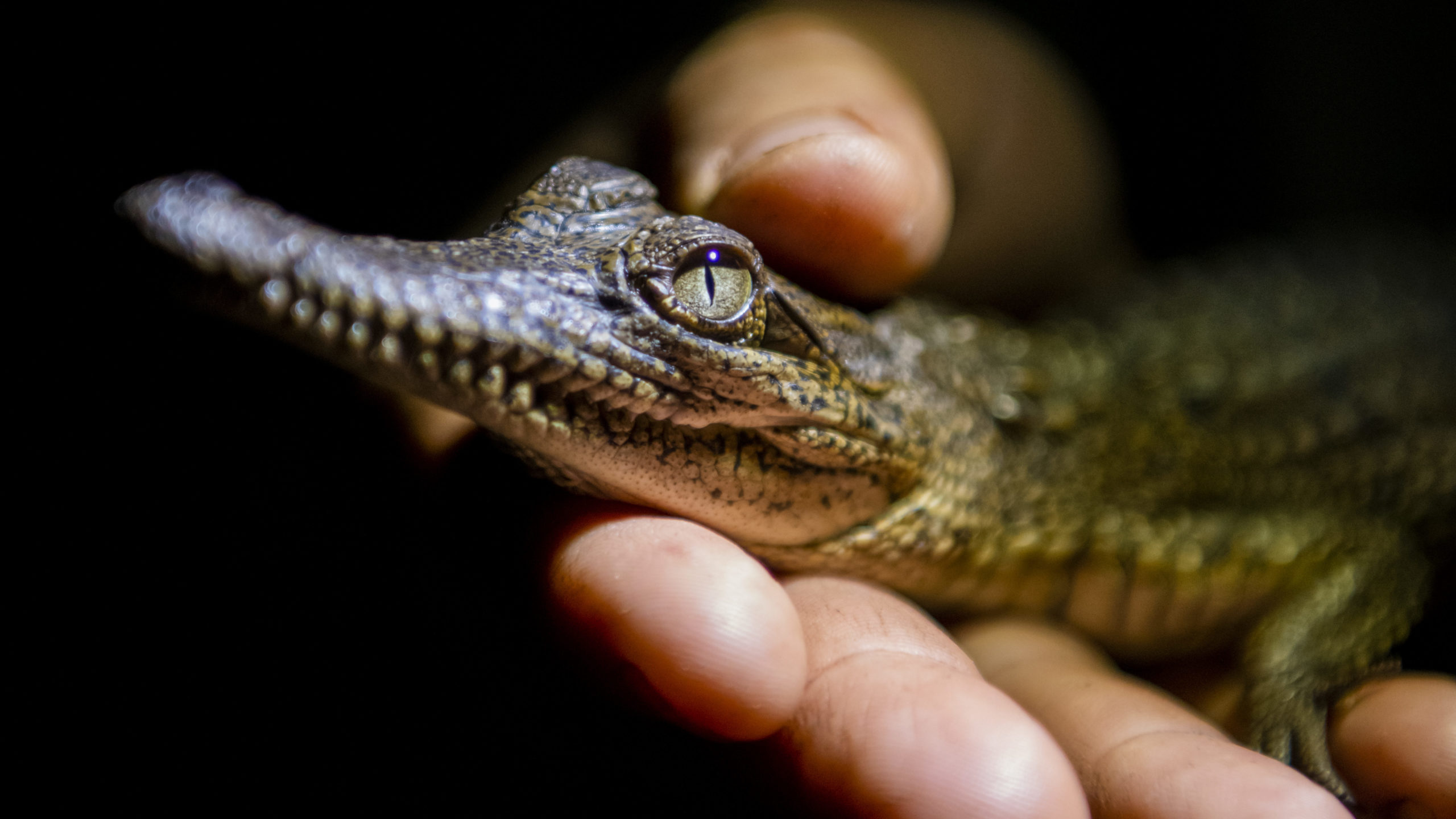
‘Salties’ might be as Aussie as koalas, but it was clear to Grahame that Territorians would need a strong incentive to develop empathy for the big reptiles. And so he and his colleagues swung their weight behind crocodile farming and tourism to transition croc protection into an economically valuable proposition. It was the beginning of what’s now known as “incentive-driven conservation”, which has helped transform wild crocodiles into a commodity, underpinning goods and services worth well over $100 million dollars to the Territory’s economy.
The NT government’s “Problem Crocodile” control program deals swiftly with potentially dangerous animals in public areas, and as many as 300 individuals are now caught annually at places such as Darwin Harbour, Litchfield National Park, and Nitmiluk (Katherine) Gorge; they are either relocated or euthanised. These days, NT croc conservation translates into many hundreds of jobs in tourism, farming and management, and the resurrection of Australia’s saltwater crocodile population is recognised as one of the world’s most stunning conservation success stories.
It’s hard to imagine in these enlightened days of wildlife appreciation that for much of the 20th century saltwater crocs were on par with cockroaches for many Australians – vermin that needed to be eradicated. They were hunted for sport and as a community service and when, after World War II, their skins became highly sought after overseas, it became open season here on the species.
A wild and reckless rifle-wielding mob of croc hunters blasted their way across the estuaries and swamplands of the country’s north, making a living under difficult and dangerous conditions. They were a notoriously tough and pioneering group of mostly men, some of whom became the stuff of legend, like Fred Pocock and Ray Petherick, each of whom in the 1950s famously brought down a few 18-footers (5.4m).
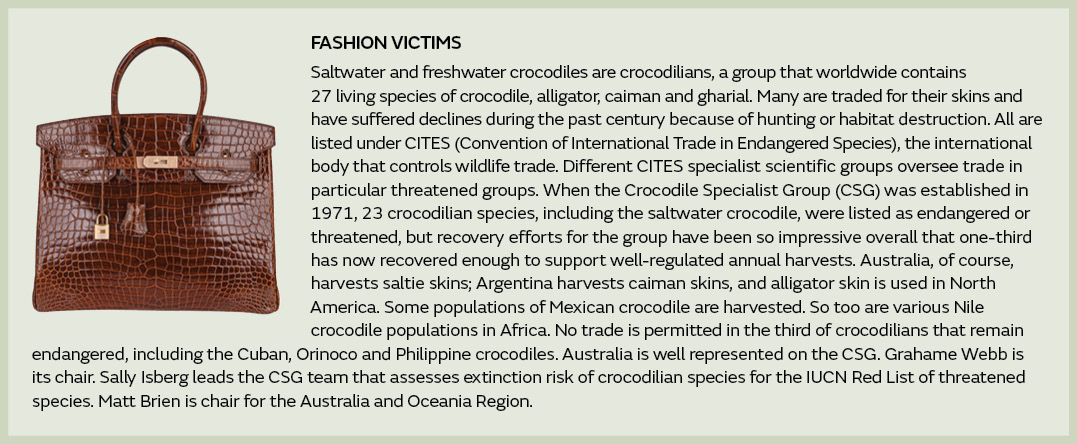
By the 1960s, the saltwater crocodile was almost extinct in the wild here, and a generation of Aussies grew up swimming freely in the estuaries and tidal river systems of the country’s north, including Darwin Harbour. Most had never even heard of saltwater crocs in Australia, let alone seen one in the wild.
Western Australia was first to introduce protection for the species in 1970, with the NT following in 1971, and finally Queensland in 1974. It was a simple action that saved the species in Australia, but ultimately led to the contentious human/reptile conflicts that peaked in Darwin during the 1980s. Before protection, saltie numbers dwindled to just a few thousand across the species’ entire range in this country, from WA to Queensland. These days there are at least a few thousand in WA alone and perhaps 30,000 in Queensland. But the species’ Australian stronghold is the NT, where at least 100,000 juvenile and adult salties are now thought to survive in the wild.
There’s no doubt you’re in croc country from the moment you step off the plane in Darwin. Airport advertising features huge crocs leaping or basking on riverbanks with mouths agape exposing massive teeth: it’s clear the magnificent reptiles have become a huge tourism drawcard for the NT. Local authorities exercise due diligence with explicit warnings near potential croc habitat, but tourists are also urged to take tours to see the reptiles safely in the wild or interact with them in captivity at one of the two major croc-themed wildlife parks in Darwin – Crocosaurus Cove and Crocodylus Park. Talk to handlers at these parks and it’s clear salties are far from the animal thugs devoid of personality they were once widely portrayed to be. At Crocosaurus Cove, for example, the reptiles are treated much like pet dogs: handlers give them names and verbal commands to which they respond, and activities to stimulate their brains.
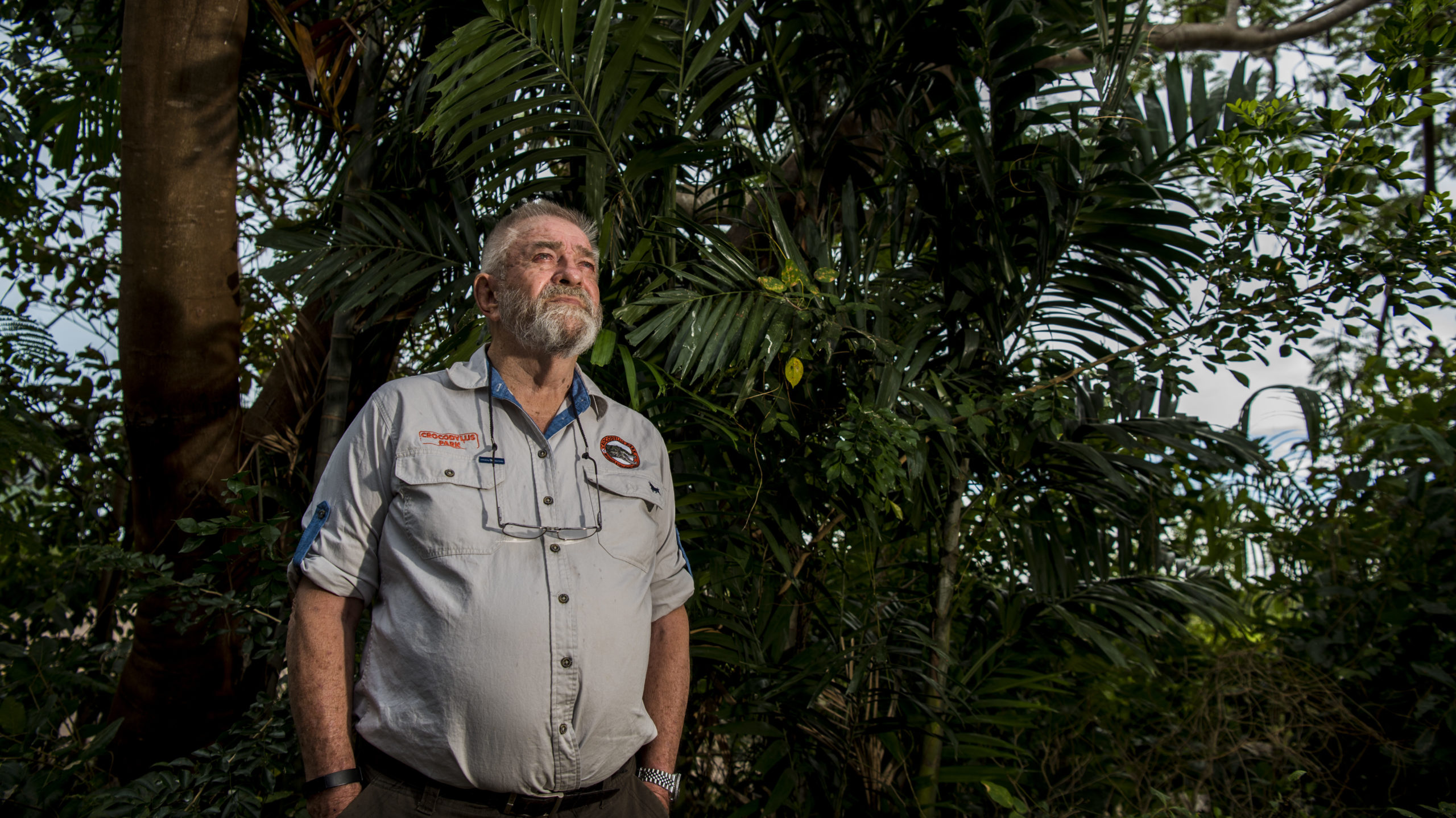
Dr Sally Isberg, who completed a PhD in crocodile genetics at Sydney University’s Agriculture Department, is now a patriotic Territorian. She’s passionate about all crocodilians, but, like Grahame, is pragmatic about the need for an imaginative response to make the wider community care for a carnivore as dangerous as the saltwater crocodile. She established and runs the Darwin-based Centre for Crocodile Research, which oversees research and development to improve efficiency and productivity in the croc-farming industry. She consults to Crocosaurus Cove and the wider croc-farming industry about animal husbandry, notably the health and ethical treatment of captive animals.
Sally points out that farming crocodiles is much like farming cows, sheep or chickens, and is overseen by similar rules and regulations in Australia that apply to other livestock. She has a major role in ensuring sustainable management is pursued using humane and hygienic practices, and she says that’s the way the majority of the industry now operates. She concedes, however, that historically that may not have always been the case.
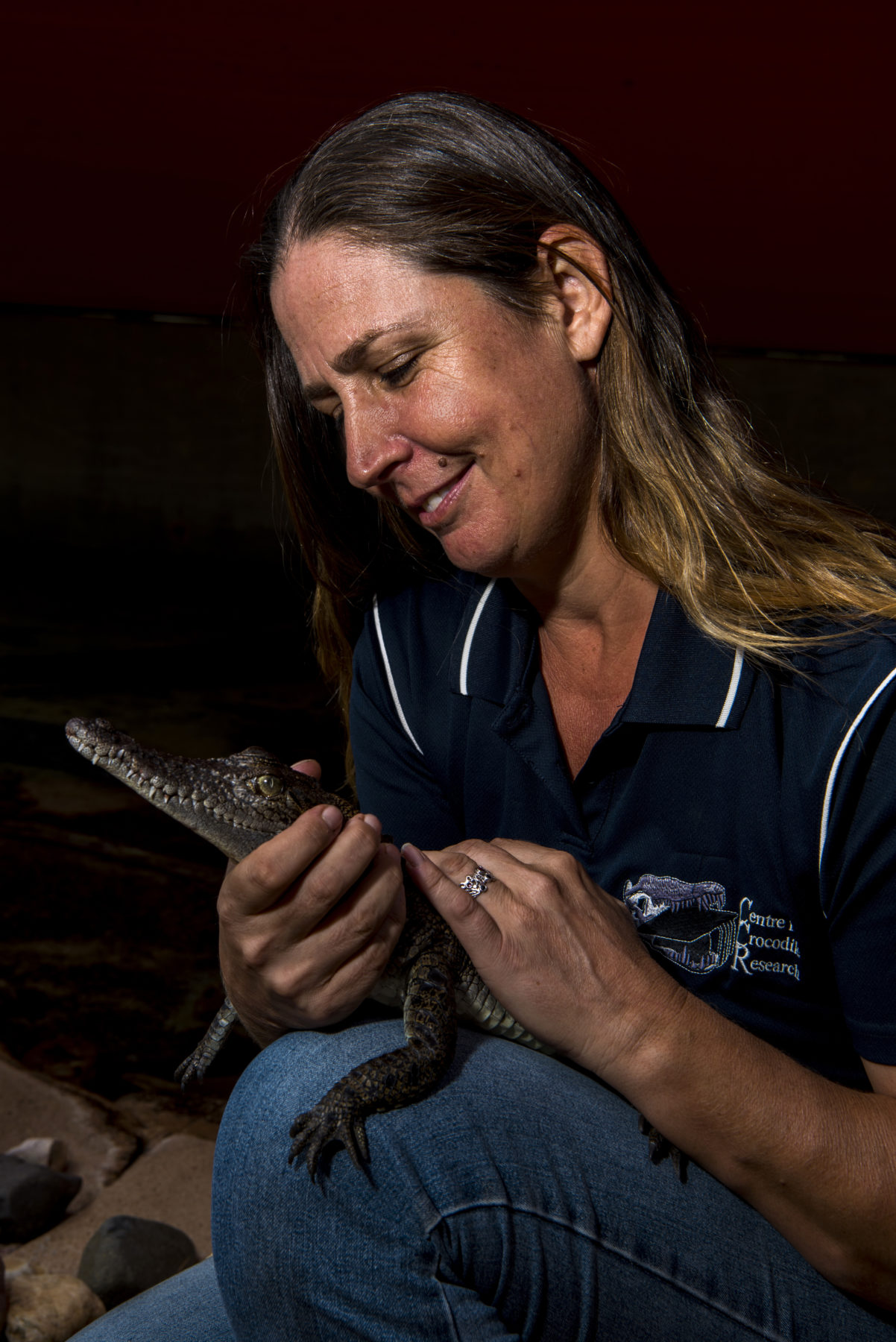
Australia’s first farms were started in the late 1970s by local operatives. Now most NT croc-farming operations are either fully or partly owned and funded by high-end French fashion houses, notably Louis Vuitton and Hermès. Animal welfare aside, Sally says, it’s not in these brands’ interests to support animals kept in overcrowded and unhealthy conditions. Apart from the public-image problems it might generate, it doesn’t equate with the quality leather needed for designer crocodile handbags that can each fetch $US50,000 or more.
Most animals in the industry are harvested at about three years, or a length of about 1.6m, which provides enough belly skin at the size and scale preferred by the fashion market in crocodile handbags. The animals enter the farms as eggs, which are largely sourced from the wild. “Most eggs die in the wild due to flooding and predation, so this is seen as capitalising on a potential loss,” Sally explains. Permits are issued for up to 90,000 viable saltwater croc eggs to be harvested each year in the NT. Any NT landholder who preserves saltwater crocodile habitat on their property and tolerates the animals nesting can also receive a financial windfall by selling eggs. However, most nesting in the NT is on Aboriginal land, and eggs are collected by or under the supervision of Traditional Owners (TOs), so it’s largely Indigenous people who operate in, and benefit from, this stage of the supply chain. “Every crocodile nest needs to have a risk assessment before harvesters go in and open it up,” Sally says, explaining harvesting is a dangerous job because nests are usually well guarded by adult females. “And they need to be very careful in opening up a nest to make sure eggs don’t rotate.” Crocodile eggs aren’t leathery like those of most reptiles. They’re like very hard birds’ eggs, but unlike birds’ eggs, don’t tolerate being rotated during incubation. This is because developing embryos attach to the upper margin of eggs, meaning they need to stay in an upright position to survive through to hatching. To ensure that happens, each egg is marked with a line as a nest is opened, enabling eggs to be removed, transported and later incubated in the same orientation in which they were found.
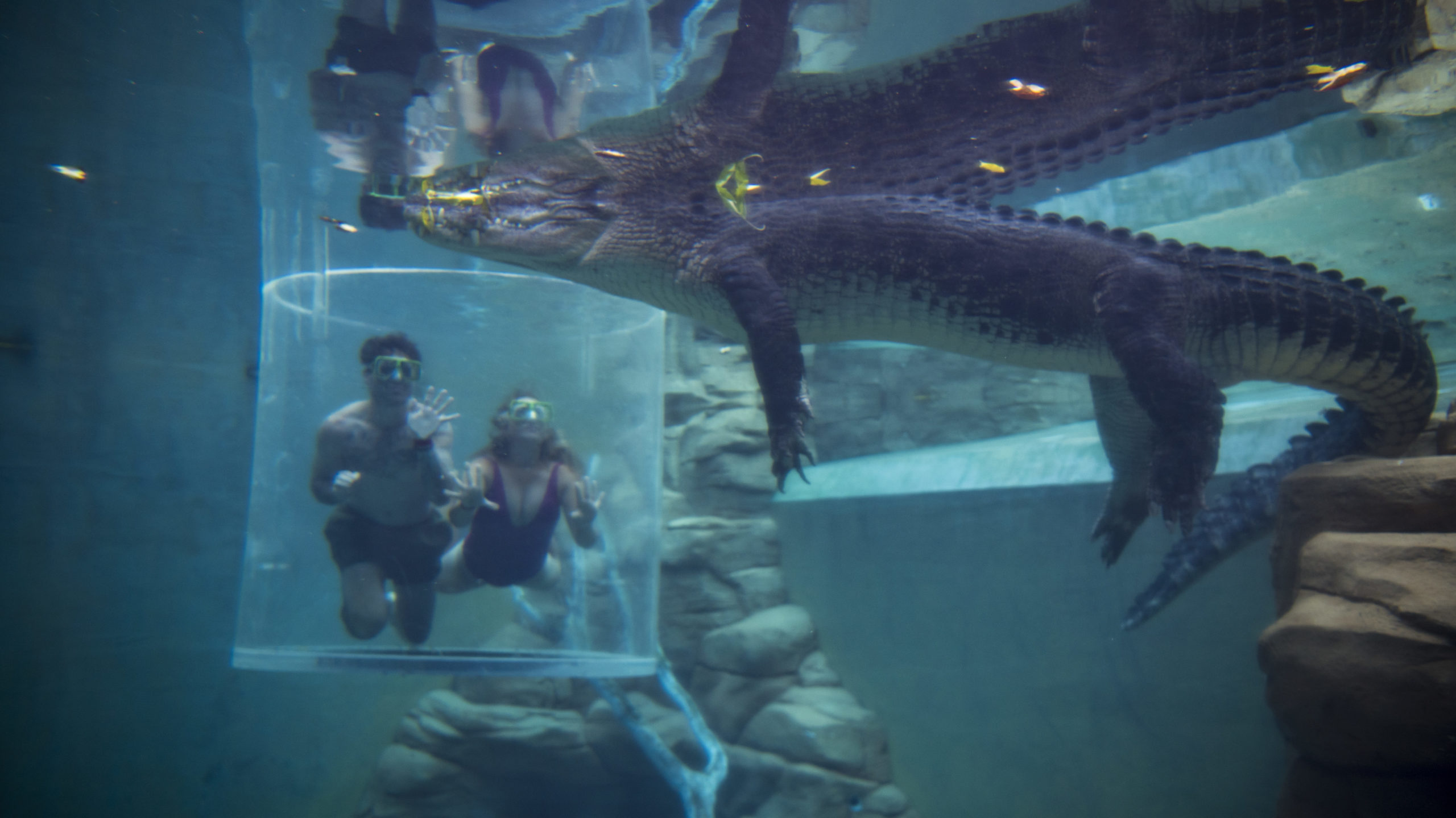
The Yolŋu people in East Arnhem Land have for many years been harvesting saltwater crocodile eggs in the Arafura Swamp – a huge, pristine inland floodplain – to sell to Darwin farms. But in 2021 the Arafura Swamp Rangers Aboriginal Corporation began taking the operation up a notch with the completion of the first stage of a state-of-the art facility in the community of Ramingining to hatch the eggs and grow hatchlings to about 1m in length, before selling them to the various farms. The project, which taps deeply into long-held Indigenous knowledge of saltwater crocodiles, has been widely lauded for creating employment and income in one of Australia’s most remote communities. The second and final construction stage of the project, which is being funded jointly by both the NT and federal governments, was due for completion in late 2022.
The perceived monetary value of saltie eggs makes them a target for some of Australia’s most sophisticated theft operations. In Kakadu National Park, which has become a saltwater crocodile safe haven since protection for the species was introduced, there’s no commercial egg harvesting because it’s a World Heritage area under federal government management. And yet that hasn’t stopped thieves arriving in helicopters to raid saltwater croc nests. In one past illegal sortie onto the park, about 30 nests were raided. “If we catch them,” says Garry Lindner, supervisor of Crocodile Management and Coastal Surveillance in the park, “they’ll lose their helicopter. We’ll go all out to seize it and seek confiscation through the courts.”
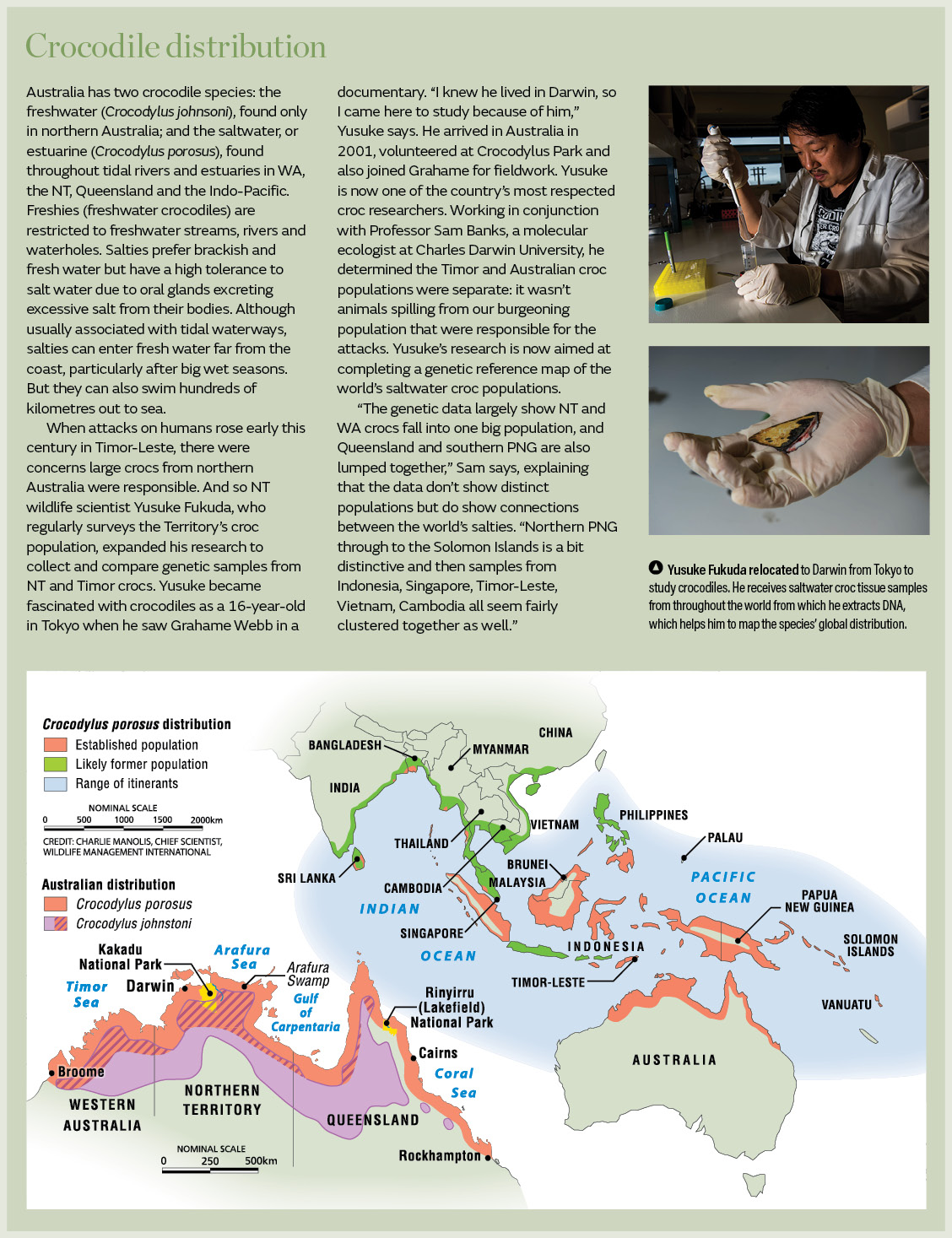
Garry, who’s been working in wildlife management in the park for almost three decades, says saltwater croc numbers in Kakadu have reached the level they would have been before Europeans arrived. Up to 10,000 juvenile and adult saltwater crocs now live and breed in the 20,000sq.km park, and that’s probably maximum carrying capacity for the species there. It’s a population controlled by Kakadu’s mostly natural rhythms and is not expected to grow in density or total number. But the upper average size range of crocodiles in the park, where the biggest animals are mostly 2.5–4m, is likely to continue increasing. Perhaps, after another decade or two of protection, we might see individuals in Kakadu reaching the species’ upper potential size range, which is thought to be 6m-plus.
For salties to reach that size takes a lot of luck, particularly in their early years. Egg mortality in nests is high, with an average 75 per cent failing to hatch in the wild, and then life as a croc hatchling is notoriously precarious. Hatchlings are guarded by highly protective mothers for their first 2–3 months. Then the next few years are spent avoiding the mouths of pythons, barramundi, catfish, black-necked storks (jabirus), birds of prey, feral cats, and larger saltwater crocs. If they make it to about 2m – about 13 or 14 years – their only threats are humans and larger crocs, although animals that swim in coastal estuaries or out to sea are sometimes attacked by sharks. It’s estimated that less than one in every 50 eggs – the average number laid in a nest – will make it to the 2m stage.
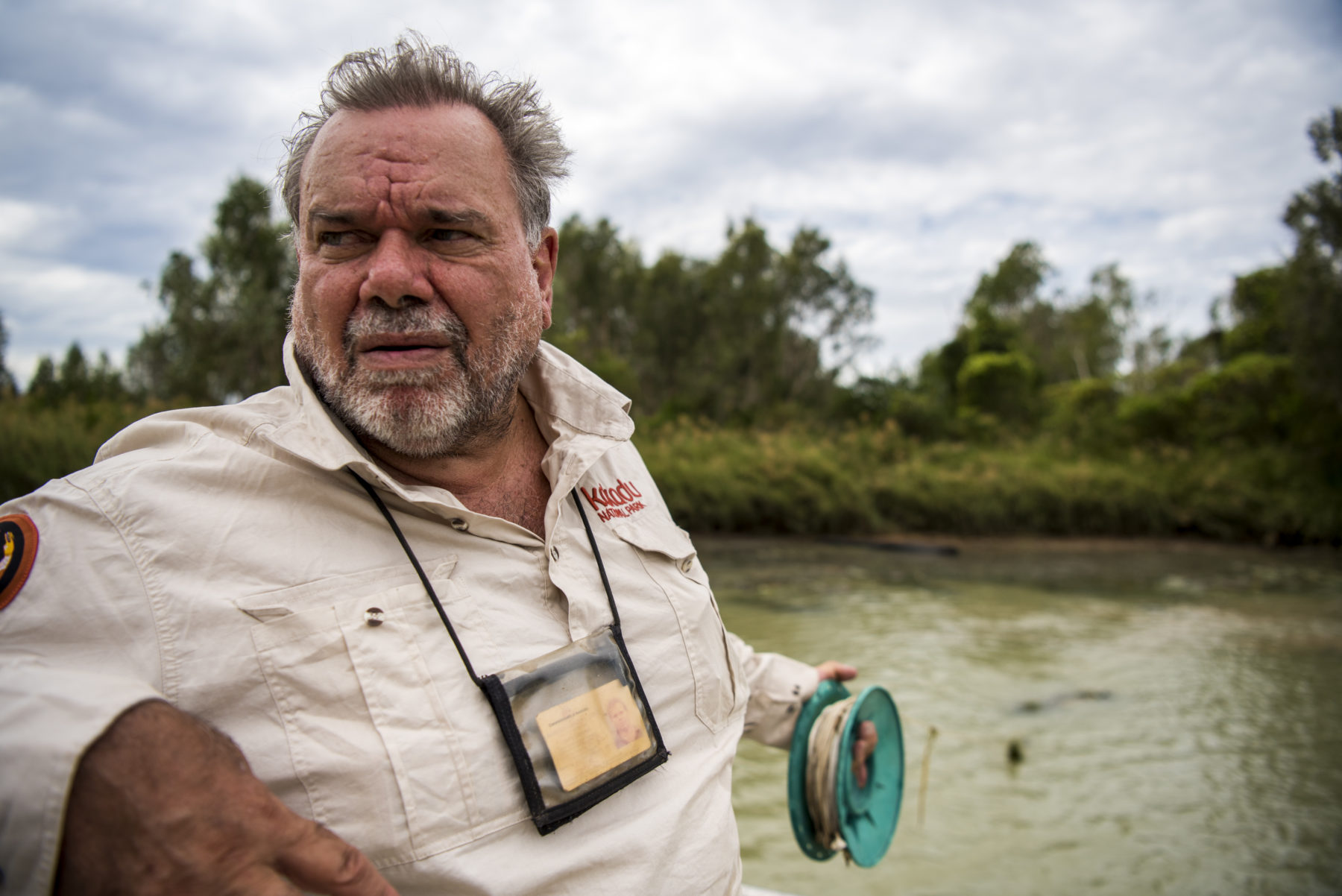
Garry Lindner’s team deals with interactions between humans and crocs in the park and tracks and collects data on the croc population there. We join him and two of his young rangers – Desiree ‘Des’ Neidjie and Charlotte Bayne – on a late spring afternoon for a training exercise on East Alligator River. We climb into a purpose-built croc boat – open but protected by high railings and with a flat bottom so it can glide across shallow water. It’s heavily built to withstand knocks from crocs and also barramundi, which can reach more than a metre in length. We head out looking for an undocumented croc of no more than 2.5m so Des and Charlotte can do a catch, tag and release procedure.
Charlotte’s mother grew up in the central Kakadu area, around Yellow Waters. Des, a Gaagudju and Bunitj woman, is from the land at the park’s northern end. Her grandfather Bill Neidjie, a Kakadu Elder famed for his commitment to protecting the natural environment here, was instrumental in seeing Kakadu achieve national park, and then World Heritage, status.

East Alligator is one of four major tidal rivers connecting Kakadu with the ocean to the north and on any given day its banks are lined with basking crocs. At night, when they prefer to hunt, the river lights up with croc eyeshine. We head upstream past Cahills Crossing, where in September–October up to 40 large saltwater crocodiles at a time line up to gorge on mullet and barramundi arriving to breed in the river from the ocean on spring tides. Garry says this annual end-of-dry season phenomenon has become one of the world’s great wildlife viewing opportunities since crocodiles returned to Kakadu. Raised platforms built there have recently been upgraded to safely accommodate the ever-growing numbers of tourists it attracts.
Just past the crossing, a huge 4m animal lying on the riverbank is opening and shutting its mouth. It’s undoubtedly a male because females rarely grow longer than 3.5m. Garry explains it’s probably trying to bring up a furball. Crocs can’t digest keratin and so hair and nails from mammals, such as feral pigs, on which larger crocs prey, concentrate in their stomachs into sometimes soccer ball–sized accumulations that are then regurgitated. “That’s special to see,” Garry says. “Seeing behaviour like that is why I love Kakadu – these crocs are just doing their stuff and we get the privilege of watching. It’s only been in the last 20 years we are starting to see the real Kakadu and learning so much about the behaviour of the species that hasn’t been documented before.”
We motor past Catfish Creek, where in 1985 Sydney academic Dr Val Plumwood, en route to an Aboriginal art site, was knocked from a canoe by a large crocodile and severely mauled. She fought back, escaped to higher ground and was later found near death but alive, surviving to became an advocate for crocodile conservation.

We locate an appropriate croc specimen for the women to test their data-gathering techniques and Garry snares it with a small harpoon. As Des manoeuvres the boat, Charlotte brings the croc to the boat’s edge, where, using first a cable tie and then duct tape, Garry secures its jaws safely shut. The croc is then brought on board by Charlotte where its length (2.5m) is measured, along with a range of other metrics; it’s sexed (male); and marked permanently and uniquely (349) by the removal of tail scutes – bony external plates – according to a particular pattern. It’s an ID system used widely by crocodilian researchers worldwide and means a crocodile can be identified throughout its life. Finally, the animal is given a name (Fynn) and returned to the water. We later take the scutes back to Darwin for DNA to be extracted and entered into a global database (see page 75).
“This is a special place where crocs can do their thing, without interference,” Garry says. “That’s the beauty of Kakadu from a conservation point of view. Because it’s a Commonwealth reserve, wildlife can just do what it does, and you also get local Indigenous people hunting in tune with what they did historically.”
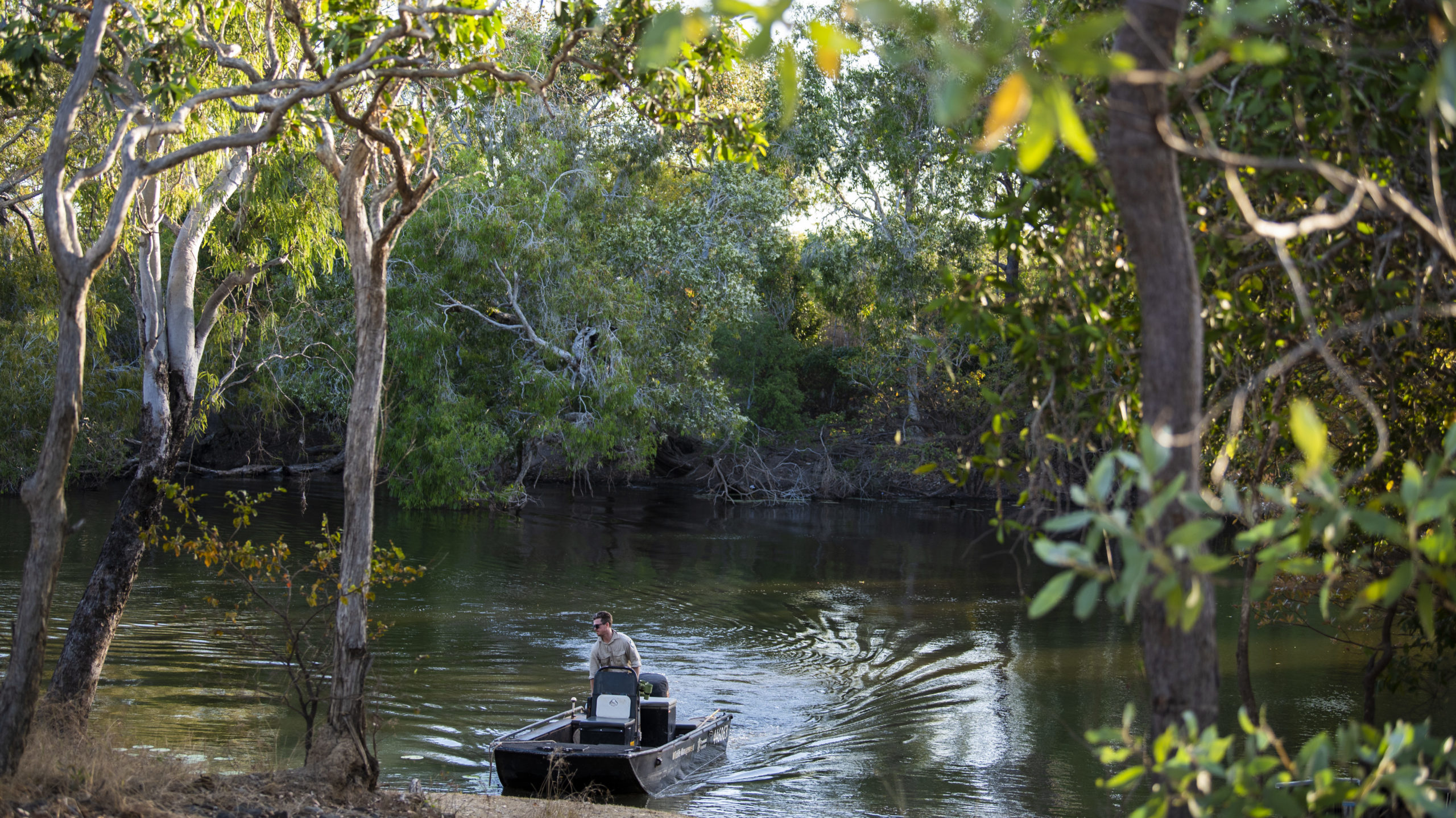
Although Kakadu struggles with several ongoing maintenance problems – from water weeds choking its waterways to feral buffalo and pigs trashing habitat – it’s finally got its top-order predator back wielding influence over its plants and animals. “What we’re seeing now is something that hasn’t been seen in more than 200 years, since the time of first European contact with Indigenous people – it’s unique. A lot of people grew up here not knowing what a peak croc population was like and now we are actually seeing that.”
Dr Matt Brien and his team are working quickly to safely secure a 5.2m croc caught in a gate trap set deep into riverbank vegetation at Seven Mile Waterhole on the North Kennedy River, in Rinyirru (Lakefield) National Park in Queensland’s eastern Cape York Peninsula. “What a dinosaur,” Matt whispers in hushed reverence. He is program coordinator for the Queensland Parks and Wildlife Service (QPWS) Northern Wildlife Operations; croc management takes up most of the team’s work, ahead of cassowaries and flying foxes. He’s been in croc research and management for more than 20 years and spent time early on working with Grahame Webb.
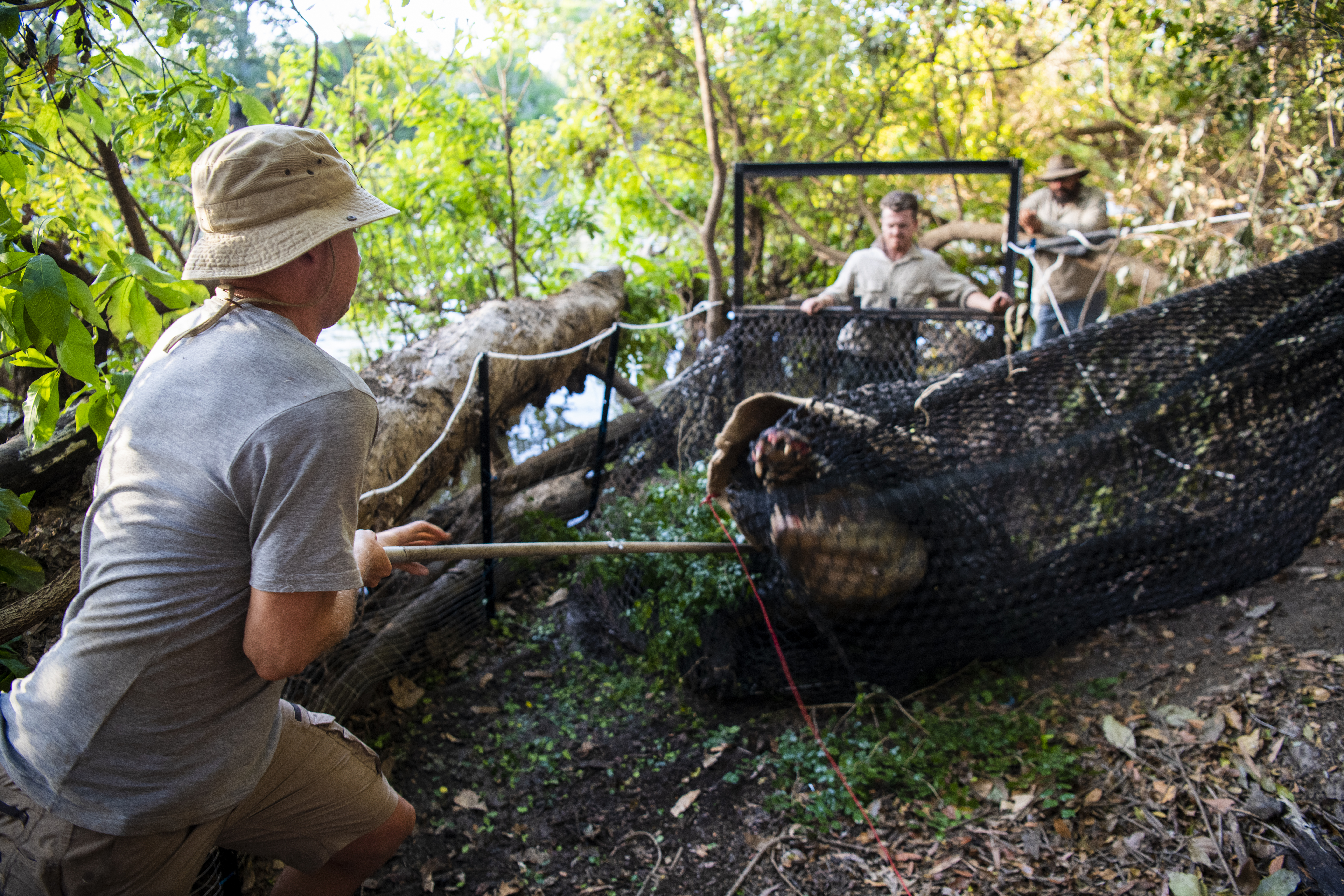
The huge crocodile captured at Seven Mile has had its tail scutes cut, indicating it’s been caught previously, and Matt’s confident he recognises him. When Matt later checks the records, it turns out he attached a radio transmitter to this animal in 2003 as part of a tracking study and gave him the name Chopper. In the two decades since then, Chopper has grown about 50cm in length.
When a saltwater crocodile reaches this size, there’s also been an exponential growth in its body mass so, it’s not only very long but also very wide and bulky. Chopper’s head alone is now about 60cm wide, and he looks to measure more than a metre across his body at its widest. (You don’t take a measuring tape to a carnivore of this size, so measurements have to be estimates.)
Chopper now seems to be 700kg or more in weight: he’s truly huge and, understandably, not happy at being caught, which is evident by the low-pitched rumble he’s emitting. But he’s surprisingly still, almost as if he realises there’s no point expending energy if there’s no clear escape plan.
With crocodile numbers growing in Queensland as they have been in the NT and WA, QPWS has been expanding its work in the research and management of potential conflicts between the reptiles and the general public.
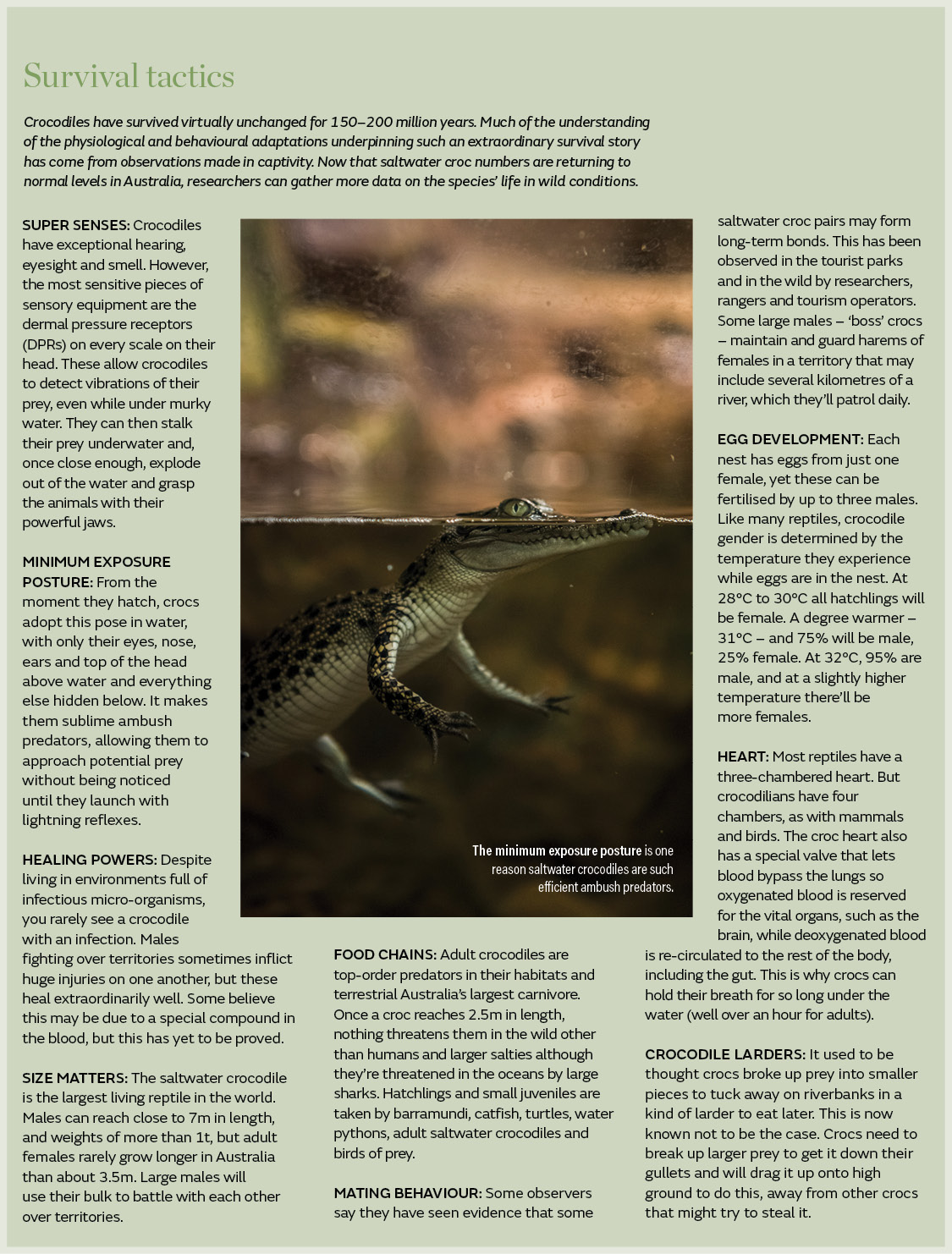
Since 1975 Queensland has had 46 crocodile attacks, including 17 that were fatal. Attacks are rising, mostly along the east coast where the human population has grown along with the croc population, which has been climbing back to its original size after protection. Matt’s team now remove about 50 animals a year in response to public concern, many of them in the Cairns area.
“With a large predator that’s increasing in number you have to manage them around people,” Matt says. “The bottom line is, with the success of crocodile conservation, you want almost no crocodiles where there are lots of people and lots of crocodiles where there’s no people. So, in and around Cairns [far north Queensland’s most populous city], you just can’t have big crocodiles.”
Senior field ecologist Dr Laurence Taplin, who’s worked on surveys of the Queensland population since the mid-1980s and now consults to Matt’s team, explains that genetic studies show there are essentially five or six separate populations of the reptile across the state, with little interaction between them. Removing large animals doesn’t mean others will move in from another area to take its place, as was once thought. “The fatal attacks are big animals,” Laurence says. “The non-fatals are caused by animals typically between 2m and 3m; so they’re big enough to see splashing in the water, become interested and approach, but when they grab hold, it often tends to be they’ve bitten off more than they can deal with because humans can fight back and crocs tend to let go when that happens.”
During his latest capture, Chopper is being fitted with a sonar tag as part of a trial using multibeam sonar and artificial intelligence technology to detect crocodiles under water, alert QPWS officers about their presence via phone networks if they enter an area where people swim, and then deter them with unpleasant sounds. At this stage it’s still a pilot project, but early results are promising.
“People can’t swim at the beaches and estuarine areas in northern Queensland [because of stingers and sharks], but we’ve got all these beautiful rivers and creeks up in the mountains like Crystal Cascades – the problem is crocodiles are now moving into these areas, and so we are trying to find a way to better detect and deter animals moving into these upper freshwater areas,” says Matt. It’s one of several detection strategies being developed by QPWS to manage potential croc–human conflicts. Another is eDNA technology (see And now for CSI Australia , AG 169), whereby simple water testing can reveal if a creek or river has crocodiles present.
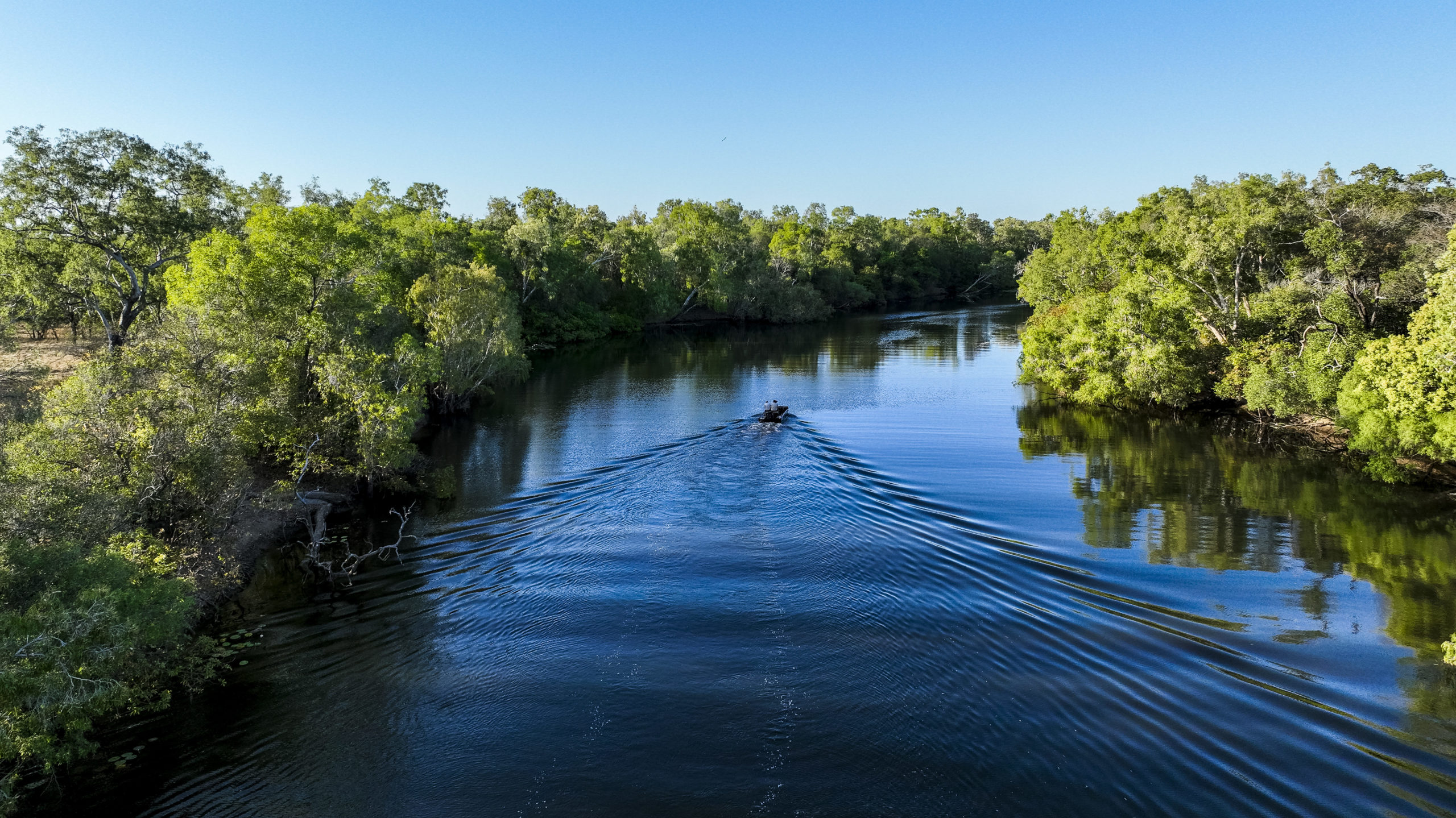
QPWS is also experimenting with crocodile capture and trapping techniques, adapting the best of what’s been developed around the world but also developing its own approaches, including the use of drones to catch crocodiles by dropping snares over their snouts. The range of capture techniques is necessary for different crocs in different environments. Matt says this means he and his team can move in quickly when problem animals have been identified, catching and removing most within 48 hours.
Laurence and Matt are surprised there aren’t more attacks in Queensland because they see so many people ignoring crocodile warning signs. Crocodiles are naturally wary of humans and tend to keep their distance anyway, so following simple protocols to avoid crocs works well. Statistics show it’s mostly local males who are likely to be blasé about warnings that get attacked; alcohol is often involved.
Laurence and Matt speculate that Chopper must be 60 to 70 years old and evading humans would have been how he’s made it to such an age. He’s somehow avoided getting his head blown off during the era when hunters would have taken out most of his compatriots.
He’s been lying quite still while his restraints are in place, but as soon as they’re loosened, he seizes his chance to escape. One massive thrust of his tail and he silently and swiftly slips back into the water. Just upstream a couple fishing for barramundi from a tinnie are oblivious as he passes silently beneath them and swims to freedom.
The sonar system detects Chopper cruising these waters – his territory – daily, during the next few weeks. But no-one sees him, and if it stays that way he’ll likely live for another decade or two.

Polar dinosaur stomping ground discovered in Victoria
New research into ancient fossil tracks discovered near Melbourne last year proves that dinosaurs lived at the poles.

Warmer winters are waking snakes from their slumber sooner
Warm winters are waking snakes early – here’s what that means for them and us.

Gondwanaland: the search for a land before (human) time
The Gondwana supercontinent broke up millions of years ago. Now, researchers are piecing it back together again.
Watch Latest Web Stories
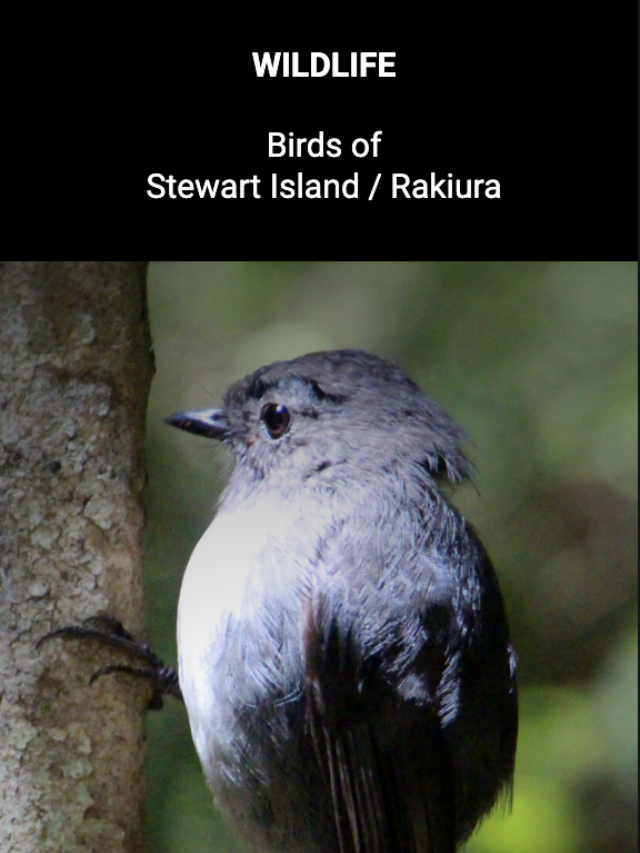
Birds of Stewart Island / Rakiura
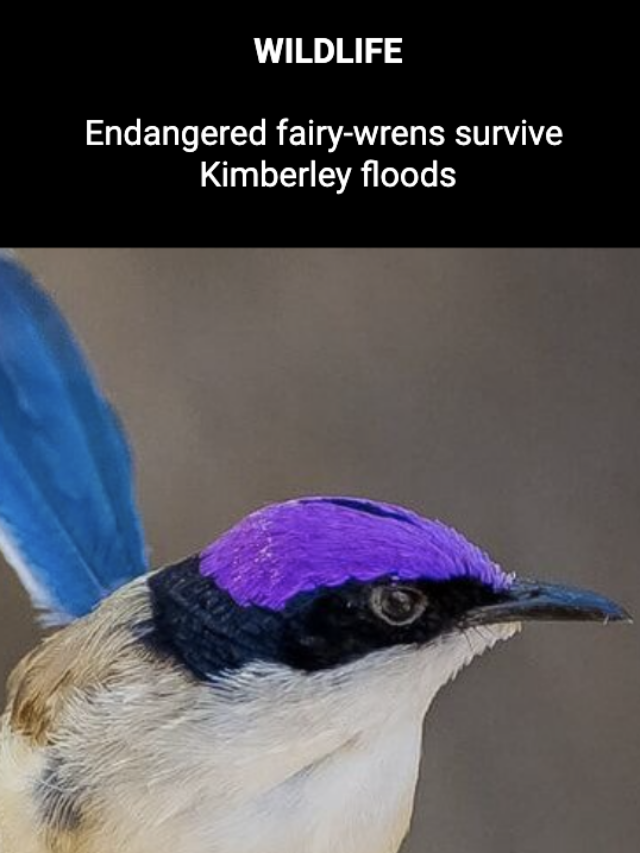
Endangered fairy-wrens survive Kimberley floods
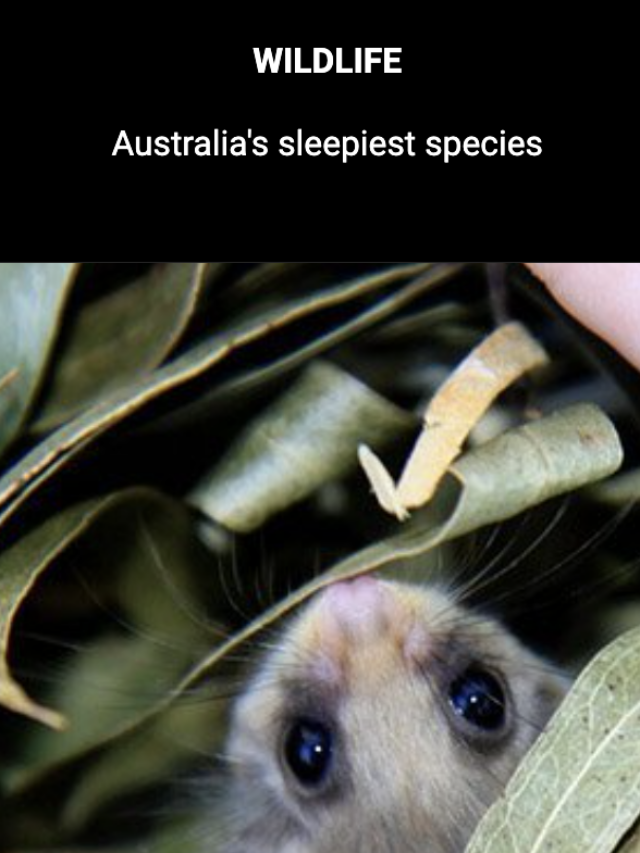
Australia’s sleepiest species
Latest Updates
- Call for papers: First articles of early-career conservationists
- Avoiding negative interactions between humans and crocodiles in Mexico
By Giovany A. González-Desales, 21st May 2021
Human–wildlife coexistence is an important conservation issue that requires careful investigation to provide solutions to possible conflicts. In the case of crocodilians, negative interactions affect people, resulting in injury or even death, which in turn can lead to the retaliatory killing of the animals concerned. These incidents are caused by various factors, including human activities in crocodilian habitat, the effects of temperature and precipitation, and crocodilian physiology and territoriality. In Mexico, as of February 2021, there have been 277 recorded cases of negative interactions between people and crocodiles ( Caiman crocodilus , Crocodylus acutus and Crocodylus moreletii ), according to the Worldwide Crocodilian Attack database (CrocBITE). We focused our analysis on C. acutus as in Mexico this is the species with the most recorded cases of negative interactions with people: there were 121 incidents recorded as of June 2018, and by February 2021 this had increased to 182.

Caiman crocodilus chiapasius reproductive female in Isla La Concepcion, La Encrucijada Biosphere Reserve. Photo: Giovany A. González-Desales
In our study we analysed the frequency of incidents with C. acutus and how these related to nesting season, proximity of human settlements to nesting sites, crocodile abundance, and socio-economic characteristics of the municipalities where incidents occurred. At the local level, we analysed negative incidents in the largest protected natural area on the Chiapas coast. We identified that incidents between people and C. acutus occurred more frequently during the nesting season (February–September) and in sites close to nesting areas. There was a greater probability of incident occurrence when human activities or human settlements were located less than 30 km from a nest. We did not find a relationship between the number of incidents and crocodile abundance. In municipalities where the incidents occurred, the principal economic activity was tertiary, or services such as tourism, with a low human population density.

Left: Crocodile Crocodylus acutus hatchlings in Isla La Concepción. Photo: Humberto Yee. Right: Crocodylus acutus neonate in Isla La Concepcion, La Encrucijada biosphere reserve. Photo: Giovany A. González-Desales
In El Hueyate estuary within the La Encrucijada Biosphere Reserve, Chiapas, we carried out unstructured interviews with local inhabitants to obtain information on negative interactions in the area and their possible causes. Most interviewees mentioned that incidents occur as a result of the area’s high crocodile abundance, which lead to the retaliatory hunting of 30 individuals of 1.5–3.7 m length and the destruction of nests. The incidents occurred during the nesting season and hatchling care, less than 13 km from a nest, and there did not seem to be a relationship between the frequency of the incidents and the abundance of crocodiles.

Left: Octavio Monroy Vilchis interviewing people in a region of the Mexican Pacific coast to document negative incidents with crocodiles. Photo: Giovany A. González-Desales. Right: Humberto Yee and Tio Abel, the main promoters of the conservation of Crocodylus acutus and Caiman crocodilus in the Estero el Hueyate. Tio Abel was the victim of an incident with a spectacled caiman in May 2012. Photo: Humberto Yee
How can we reduce negative incidents between people and crocodiles? The response to this challenging question is complex and researchers are continuing to investigate these incidents to better understand their causes. We propose several potential solutions:
- Reduce human activities in the vicinity of crocodile nests during the nesting season, both by tourism service providers and managers of natural areas.
- Disseminate information about the potential for negative incidents, using various media platforms and with an emphasis on season, and increase the use of visual material such as posters in nesting areas.
- Rescue and incubate crocodile eggs in areas where nests are being destroyed.
- Consider the socio-economic aspects of the local population, to identify the most vulnerable areas with the highest probability of incidents with crocodiles.

The sighting of crocodiles in their habitat is a very popular tourist activity in Mexico. Pictured is a spectacled caiman Caiman crocodilus. Photo: Humberto Yee. Right: Caiman crocodilus chiapasius reproductive female in Isla La Concepcion, La Encrucijada biosphere reserve. Photo: Giovany A. González-Desales
A particular success story is that of the ecotourism site within El Hueyate estuary, known as Isla La Concepción. The conservation programme that runs here for C. acutus and C. crocodilus includes activities such as wild nest monitoring and protection, talks for tourista to explain the importance of crocodiles in the area, and the use of posters to warn of the potential for incidents with crocodiles. Participants in this project have suffered negative incidents with crocodiles (incidents in April 2011 and May 2012). Fortunately none were fatal, but in the 2011 incident the affected person lost his arm. The members of this ecotourism project who have suffered negative incidents mention that it was their fault, not the crocodiles’, for invading the species’ habitat. Since 2013, the members of this ecotourism project, including members affected by negative incidents, have supported the authors of this work to generate more information about crocodilians in the region.

Left: Information poster about crocodile presence in Isla La Concepción, mentioning some restrictions to avoid negative incidents with crocodiles. Right: Caiman crocodilus chiapasius neonate in Isla La Concepcion, La Encrucijada Biosphere Reserve. Photo: Giovany A. González-Desales
The open access article Factors influencing the occurrence of negative interactions between people and crocodilians in Mexico is available in Oryx—The International Journal of Conservation.

Giovany A. González-Desales
Giovany A. González Desales is a MSc and academic at the Centro de Investigación en Ciencias Biológicas Aplicadas and the Asociación para la Investigación y Conservación de Anfibios y Reptiles. His research focus is on the study of Mexican crocodilians and is part of the Group of Specialists in Mexican Crocodilians.

Australia Recommends 2024

Travel Inspiration

G'day, the short film

Discover your Australia

Travel videos

Deals and offers

Australian Capital Territory

New South Wales

Northern Territory

South Australia

Western Australia

External Territories

The Whitsundays

Mornington Peninsula

Port Douglas

Ningaloo Reef

Airlie Beach

Kangaroo Island

Rottnest Island

Hamilton Island

Lord Howe Island

Tiwi Islands

Phillip Island

Bruny Island

Margaret River

Barossa Valley

The Grampians

Hunter Valley

McLaren Vale

Glass House Mountains

Alice Springs

Uluru and Kata Tjuta

The Kimberley

Flinders Ranges

Kakadu National Park

Eyre Peninsula

Karijini National Park

Great Barrier Reef

Blue Mountains

Daintree Rainforest

Great Ocean Road

Purnululu National Park

Cradle Mountain-Lake St Clair National Park

Litchfield National Park

Aboriginal experiences

Arts and culture

Festivals and events

Food and drink

Adventure and sports

Walks and hikes

Road trips and drives

Beaches and islands

Nature and national parks

Eco-friendly travel

Health and wellness

Family travel

Family destinations

Family road trips

Backpacking

Work and holiday

Beginner's guide

Accessible travel

Planning tips
Trip planner

Australian budget guide

Itinerary planner

Find a travel agent

Find accommodation

Find transport

Visitor information centres
Deals and travel packages

Visa and entry requirements FAQ

COVID-19 travel and entry advice

Customs and biosecurity

Working Holiday Maker visas

Facts about Australia

Experiences that will make you feel like an Aussie

People and culture

Health and safety FAQ

Cities, states & territories

Iconic places and attractions

When is the best time to visit Australia?

Seasonal travel

Events and festivals

School holidays

Public holidays
How to get to Australia's most iconic cities

How long do I need for my trip to Australia?

How to travel around Australia

Guide to driving in Australia

How to hire a car or campervan

How to plan a family road trip

How to plan an outback road trip

Crocosaurus Cove, Darwin, Northern Territory © Tourism Australia
Where to see crocodiles around Darwin
See a crocodile in one of Darwin's wildlife parks, national parks, rivers or even a museum.
By Jac Taylor
Few animals in the Northern Territory fascinate visitors as much as these prehistoric creatures. Both freshwater and saltwater crocodiles can be found in the waters and river systems around Darwin , but it is the larger species, the saltwater crocodile, that captures the imagination. With their sheer size, "salties" resemble dinosaurs more than any other modern-day animal. Your trip isn’t complete without seeing the world's largest reptiles at these places around Darwin.
Crocosaurus Cove

Crocodile encounters at Crocosaurus Cove, Darwin, Northern Territory © Tourism NT/ Shaana McNaught
A wildlife park where even the kids can get interactive with crocodiles? It can be done at Crocosaurus Cove , right in the centre of Darwin. Take a tour of the park to watch some of the largest crocodiles be fed, and grab a fishing rod to feed the baby crocs yourself. There are plenty of underwater viewing opportunities, and you can even "swim with the crocs" in the Cage of Death , a crocodile swimming experience in which you are lowered into the crocodiles' water in a perspex enclosure.
Crocodylus Park

Crocodylus Park, Darwin, Northern Territory © Tourism Australia
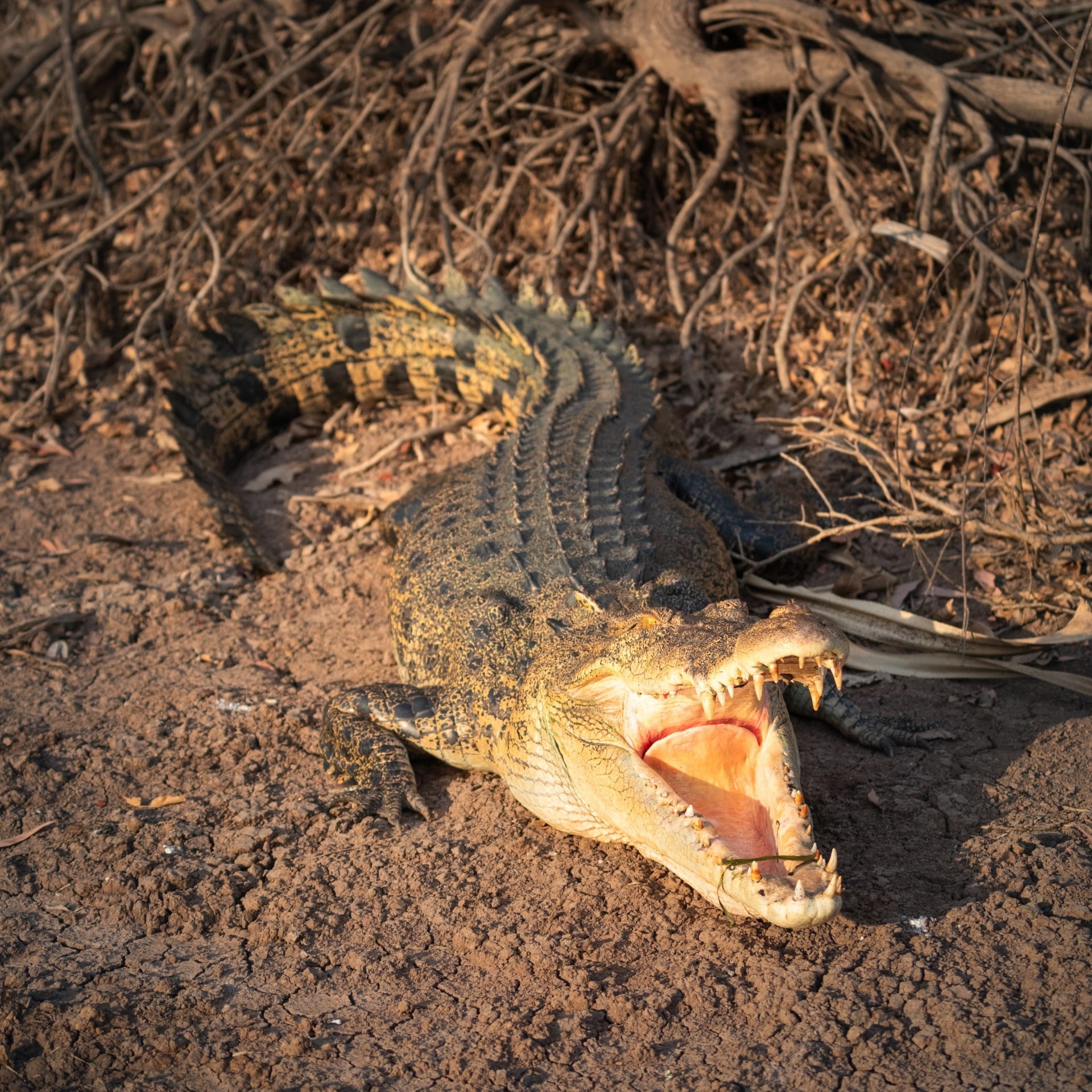
Did you know?
Saltwater crocodiles can live up to 70 years and usually grow to around 5m (16ft).
If you have a little more time, try a day out at Crocodylus Park , a 15-minute drive out of Darwin. With more than a thousand crocodiles, and an emphasis on research, this is an exciting place to fill up on facts and watch crocodiles in the extensive grounds. Take the Croc and Eco Cruise, join crocodile feeding tours and try holding a baby croc, baby turtle, snake or lizard. There are enough other animals here for a full zoo safari experience: you can see kangaroos, water buffalo, iguanas and snakes, too.
Adelaide River's jumping crocodiles

Spectacular Jumping Crocodile Cruise, Adelaide River, Northern Territory © Shaana McNaught
"Jumping" crocodiles aren't a special croc species – these wild creatures get this nickname because they jump out of the water when food is dangled overhead, lifting themselves in a mind-blowing display of strength (and hunger). With an estimated four crocodiles per square kilometre on the Adelaide River, your chances of seeing several on a jumping crocodile cruise are excellent. Spectacular Jumping Crocodile Cruises and Adelaide River Cruises run one-hour tours, an hour out of Darwin. It's a great stop on the way to Kakadu National Park .

Crocodile, Corroboree Billabong Wetland Cruises, Marrakai, Northern Territory © Edwin Lais
The massive, world-renowned wilderness of Kakadu National Park is home to well over 10,000 crocodiles. Stay croc safe by going crocodile spotting with a guided cruise at either the Mary River wetlands and floodplain (just west of Kakadu's border), home to the world’s highest concentration of saltwater crocodiles, or the beautiful Yellow Water billabong . The sunrise and sunset cruises through Yellow Water are particularly breathtaking.
Territory Wildlife Park, Berry Springs

5 ways to enjoy Darwin’s waterfront
Despite the crocodiles being in an enclosure, viewing them at the Territory Wildlife Park feels like spotting them in the wild. You walk through a tunnel beneath an aquarium to view freshwater crocodiles swimming in their natural habitat, then head to the nearby lagoon to spot the park's resident 3.4m (11ft) saltwater crocodile. Next door, you'll find picturesque Berry Springs Nature Park – a popular local swimming spot (crocodile free) with beautifully clear water and a waterfall (open seasonally).
Museum and Art Gallery of the Northern Territory
For a glimpse into the complex relationship and history that Darwin's locals share with their crocodile neighbours, visit the always interesting and beautifully curated Museum and Art Gallery of the Northern Territory . Alongside exhibitions featuring some of Australia's best fine artists, street artists and Aboriginal artists, you'll find the mummified body of Sweetheart, the city's most famous crocodile. Measuring an impressive 5m (16ft) and weighing 780kg (1,720lbs), Sweetheart is a fondly regarded local legend, carefully taxidermied and holding pride of place in the museum.
Spot crocodiles around Darwin
More articles like this.

We use cookies on this site to enhance your user experience. Find out more . By clicking any link on this page you are giving your consent for us to set cookies.
Acknowledgement of Country

We acknowledge the Traditional Aboriginal and Torres Strait Islander Owners of the land, sea and waters of the Australian continent, and recognise their custodianship of culture and Country for over 60,000 years.
- New Zealand (English)
- United States (English)
- Canada (English)
- United Kingdom (English)
- India (English)
- Malaysia (English)
- Singapore (English)
- Indonesia (Bahasa Indonesia)
- Deutschland (Deutsch)
- France (Français)
- Italia (Italiano)
- 中国大陆 (简体中文)
*Product Disclaimer: Tourism Australia is not the owner, operator, advertiser or promoter of the listed products and services. Information on listed products and services, including Covid-safe accreditations, are provided by the third-party operator on their website or as published on Australian Tourism Data Warehouse where applicable. Rates are indicative based on the minimum and maximum available prices of products and services. Please visit the operator’s website for further information. All prices quoted are in Australian dollars (AUD). Tourism Australia makes no representations whatsoever about any other websites which you may access through its websites such as australia.com. Some websites which are linked to the Tourism Australia website are independent from Tourism Australia and are not under the control of Tourism Australia. Tourism Australia does not endorse or accept any responsibility for the use of websites which are owned or operated by third parties and makes no representation or warranty in relation to the standard, class or fitness for purpose of any services, nor does it endorse or in any respect warrant any products or services by virtue of any information, material or content linked from or to this site.
Crocosaurus Cove, located in the heart of Darwin, Northern Territory
Look down the jaws of some of the largest Saltwater crocodiles on the planet on the Big Croc Feed VIP Experience
Reptile House
Home to the World’s largest display of Australian reptiles, meet & hold some of the coolest critters of the Top End.
Junior Reptile Ranger Program
School Holiday program for 7-12 year olds
Darwin Packages
Explore Darwin with a range of flexible attraction packages, showcasing the best of Australia’s tropical capital city.
Latest from Instagram

Hartley's Crocodile Adventures open to the public 8.30am Saturday 20th January 2024
The Captain Cook Highway is scheduled to reopen 8.00am Saturday 20th January 2024. Hartley's Crocodile Adventures will be open to the public from 8.30am on Saturday. Our normal schedule of wildlife presentations and boat cruises will recommence on that day. We look forward to seeing you soon. Please allow extra travel time due to ongoing road works.
- Hours and Tickets
- Self-Drive Itineraries
- Transport Options
- Multi-Park Passes
- Terms & Conditions
- Yearly Pass
- Breakfast with the Koalas
- Premium Wildlife Encounters
- Download Your Photos
- Food & Shopping
- Visitor Facilities
- Wangetti Valley
- Onsite Sustainability
- Environmental Management
- Rainforest Restoration Project
- Koala Food Tree Plantations
- North Queensland Wildife Trust
- Hartley's Creek Crocodile Farm
- Yirrganydji People
- Early Explorers
- The Halfway House
- Charlie The Crocodile
- Hartley's Crocodile Adventures
- Groups & Functions
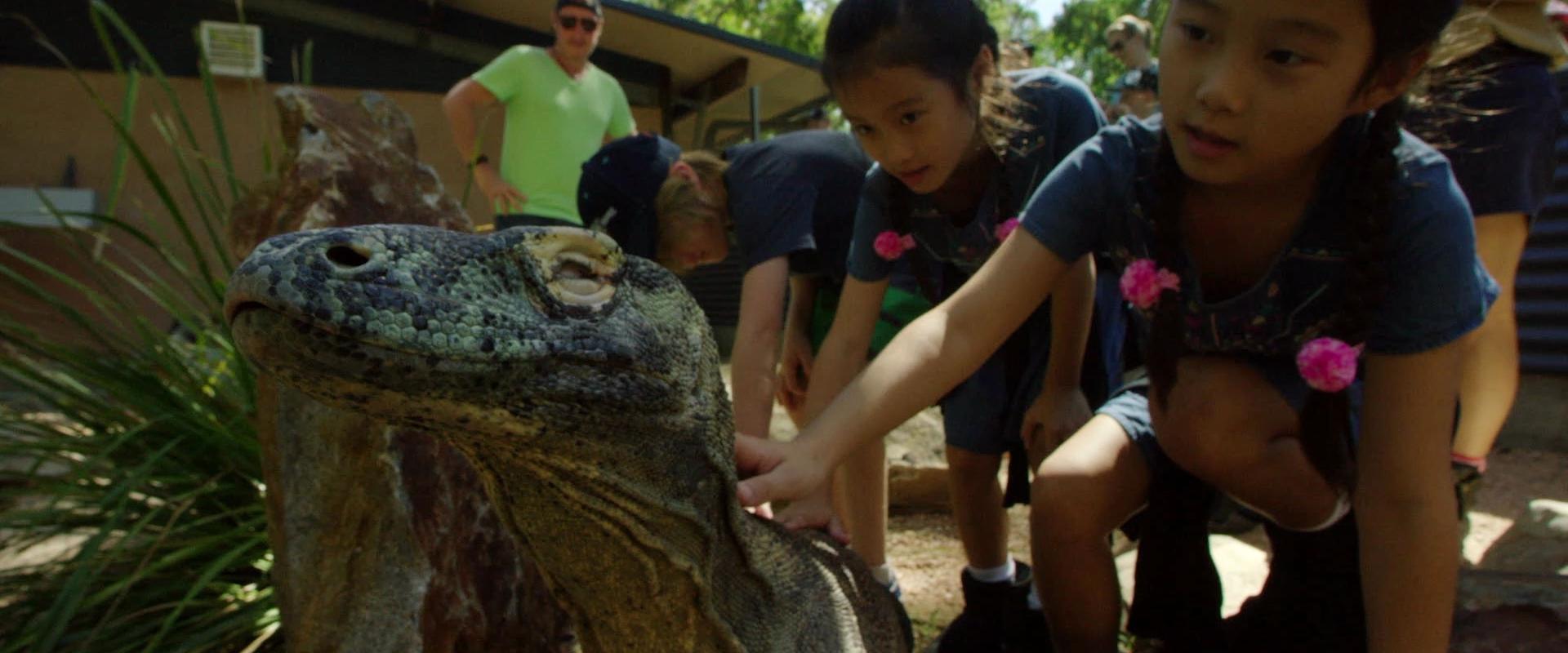
Crocodile Adventures
Exciting by nature.
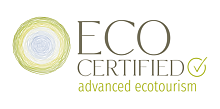
- Everything you need to know about crocodiles in Tropical North Queensland
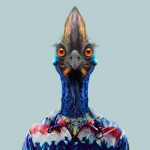
Tropical North QLD
They say to never smile at a crocodile, but there’s plenty more to know about this ancient reptile species before you set foot in Tropical North Queensland.
Put simply, Tropical North Queensland is crocodile country, so it’s important to be croc-wise, regardless of where you are travelling in the region.
Be alert but not alarmed, because these evaders of evolution are as fascinating as they are ferocious, and well worth safely observing on your next holiday. After all, crocodilians are one of only a few animals left on earth who’ve lived to tell the dinosaur-extinction tale.
So, if you want to be more croc-wise than an Irwin before your trip to Tropical North Queensland, here’s everything you need to know.
Should you be scared of crocodiles?
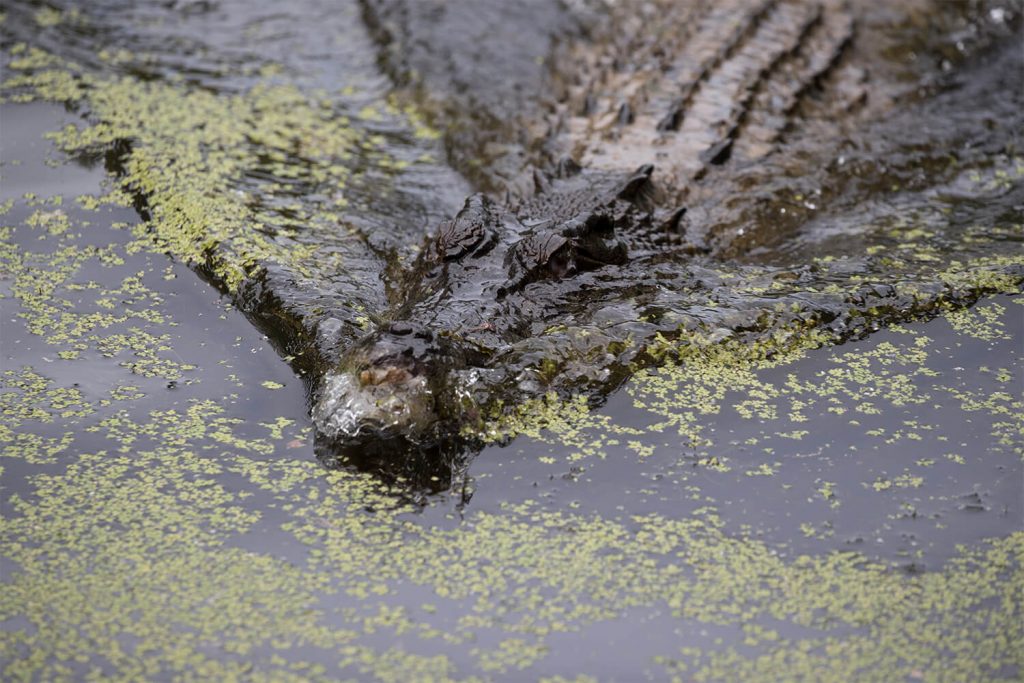
Estaurine Crocodile at Hartley's Crocodile Adventures
Cautious, yes. Scared, no. These aggressive reptiles are one of Australia’s most awe-inspiring ( see why ) and play an important role in the ecosystem of Tropical North Queensland.
Where better than Tropical North Queensland to see an apex predator that can grow longer than a ute and weigh up to 1000kg, wrapped neatly in leather armour?
The saltwater crocodile may be the largest terrestrial predator on earth but don’t be scared to safely spot these giants because there is real beauty in their biology.
Can you swim in Tropical North Queensland?
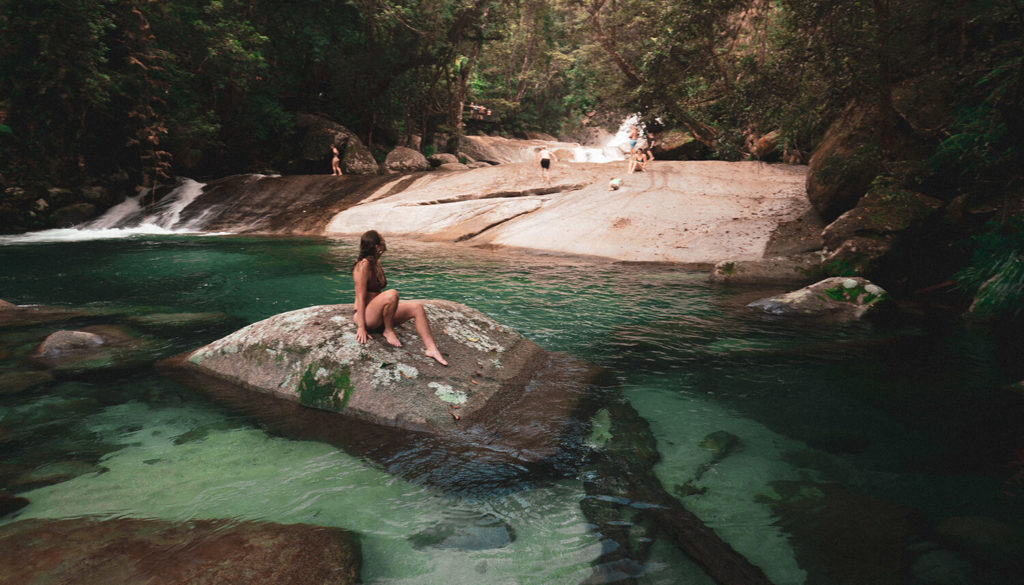
Josephine Falls is one of the many safe swimming holes in the area
With a climate that seldom dips to single digits, it’s always swimming weather in Tropical North Queensland.
Provided you follow the signs, exercise caution and are croc-wise , you can safely swim in many (NOT all) spots across the region.
For crocodile-free swimming conditions, you’re best to head inland to one of these freshwater swimming spots or waterfalls , or venture out to the reef to cool off. There’s always, of course, your hotel pool or the 4,800m² sparkling lagoon on the Cairns Esplanade.
How come saltwater crocodiles don’t inhabit the salty reef, you ask? It’s a good question – but the Great Barrier Reef’s clear water, lack of crocodile-friendly food sources and large swimming distances from the mainland make seeing a crocodile on the outer reef (aka where the reef tours go) extremely unlikely.
Of course, there are still safe places to swim in natural waterholes where freshwater crocodiles (ONLY!) reside such as Lawn Hill (Boodjamulla) National Park , but these will be signed.
What is the habitat of saltwater crocodiles
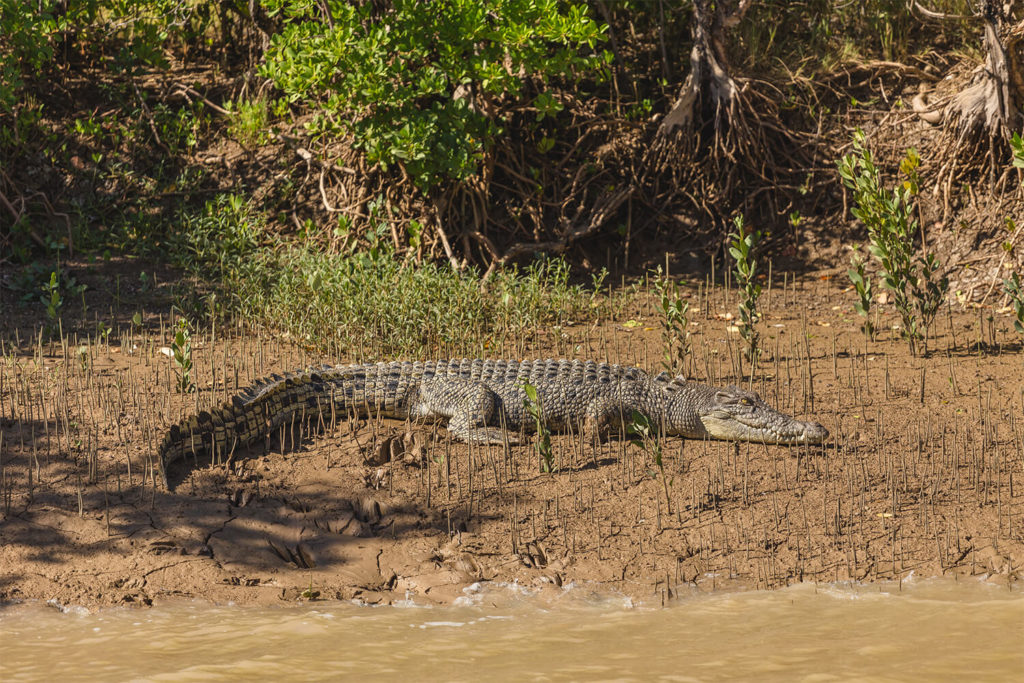
A saltwater crocodile in its natural habitat
Crocs are more at home in the water than on dry land and are found throughout Tropical North Queensland.
They can live in just about any water environment from rivers and wetlands, the open sea to billabongs and freshwater swamps, which is why it’s important to remember the absence of a yellow warning sign doesn’t equal an absence of crocodiles. Typically though, saltwater crocodiles are found in brackish (low salinity) water including river mouths near the coast.
Crocodiles are fiercely territorial, with large males fighting it out for the best river systems, some inhabiting their territory for decades until de-throned by a bigger bloke.
With a diet of fish, crustaceans, birds, livestock and mammals, the healthy river systems of Tropical North Queensland are a crocodile’s dream buffet.
What’s the difference between saltwater and freshwater crocodiles?
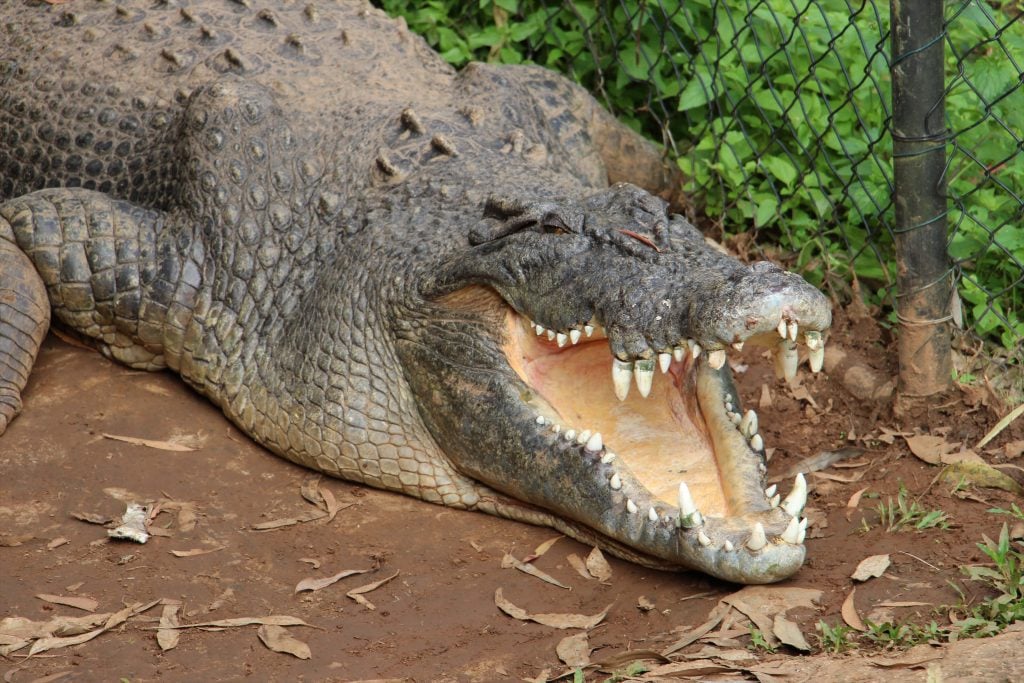
Saltwater Crocodile at Rainforestation Nature Park
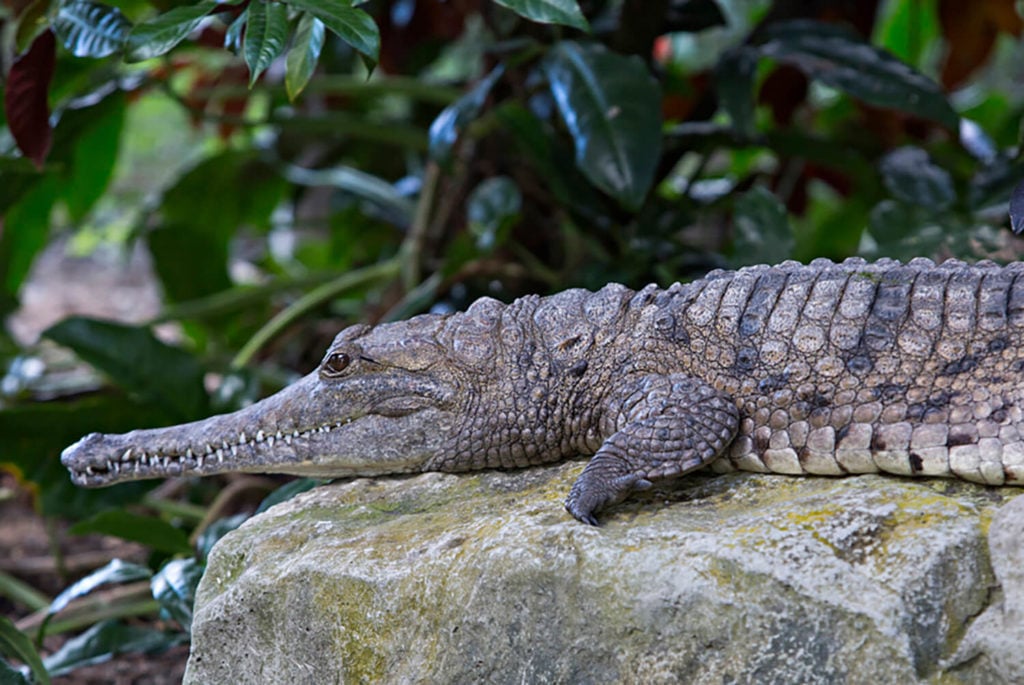
Freshwater Crocodile at Cairns ZOOM & Wildlife Dome
There are two species of crocodiles in Tropical North Queensland, but aside from their name and appearance at first glance, the saltwater (or estuarine) crocodile and freshwater crocodile are quite dissimilar.
The biggest difference you’ll see is their size. Freshwater crocodiles are decidedly smaller and they also have a longer, narrower snout with equal sized teeth – not that we recommend getting close enough for a dental inspection.
Freshwater crocodiles are deemed a visitor-friendly reptile and outside of breeding season, relatively harmless, and will only bite if provoked. As with any wild animal though, it’s important you follow advice from Queensland Parks & Wildlife or locals in-the-know.
However, we don’t recommend resting on your laurels in freshwater environments thinking you might only meet a ‘freshie’.
Just because it’s a freshwater creek doesn’t mean there’s an absence of saltwater crocodiles. It’s well established that ‘salties’ can live in fresh water – they just prefer a saltwater environment where there’s more feed to be found.
In contrast to their freshwater cousins, saltwater crocodiles are aggressors of the land and sea in every sense of the word – larger in size with jagged, uneven teeth, and built for speed to ambush unsuspecting prey.
Where can you see crocodiles?
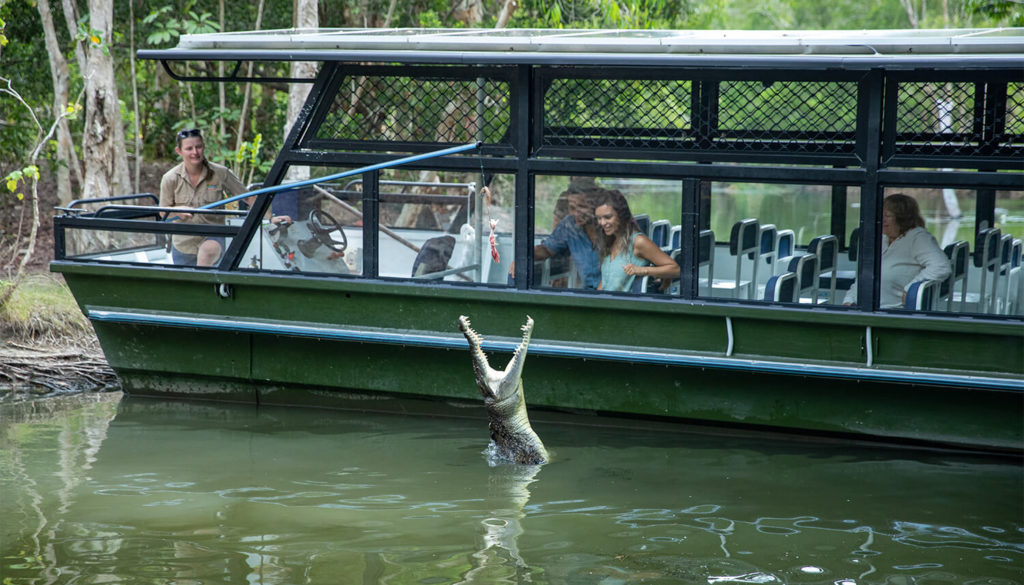
Cruise on a croc-infested lagoon at Hartley's Crocodile Adventures
While you’ll technically find crocodiles all over Tropical North Queensland – even as far west as Lawn Hill (Boodjamulla) National Park (albeit freshies) one of the biggest surprises about them is, despite their size, they’re incredibly good at hiding.
Crocodiles are camouflaged by design – not just physically with khaki skin that blends effortlessly into murky river systems, but biologically, with a small hole near their heart, which allows them to hold their breath underwater for more than an hour.
So despite the abundance of signs and warnings about crocodiles, a bit like the elusive cassowary , you may never actually physically see one in the wild.
However, this is no reason to be complacent. Crocodiles are more likely to see you than you are to see them, so it’s best to always be on the lookout.
If you really want to see one during your time in the tropics, turn the odds in your favour by joining a croc-spotting tour or visit one of the wildlife parks in Tropical North Queensland.
To catch these cold-blooded locals in action, add one of these stops to your itinerary:
- Hartley’s Crocodile Adventures, between Cairns and Port Douglas
- Rainforestation , Kuranda
- Kuranda Koala Gardens
- Wildlife Habitat Port Douglas
- Cairns ZOOM and Wildlife Dome, Cairns
- Cairns Aquarium
Or, join one of these croc-spotting tours in the wild:
- Solar Whisper Wildlife Cruises
- Snapping Tours
- Daintree Boatman Nature Tours
- Bruce Belchers Daintree River Cruises
When is the best time to spot crocs?
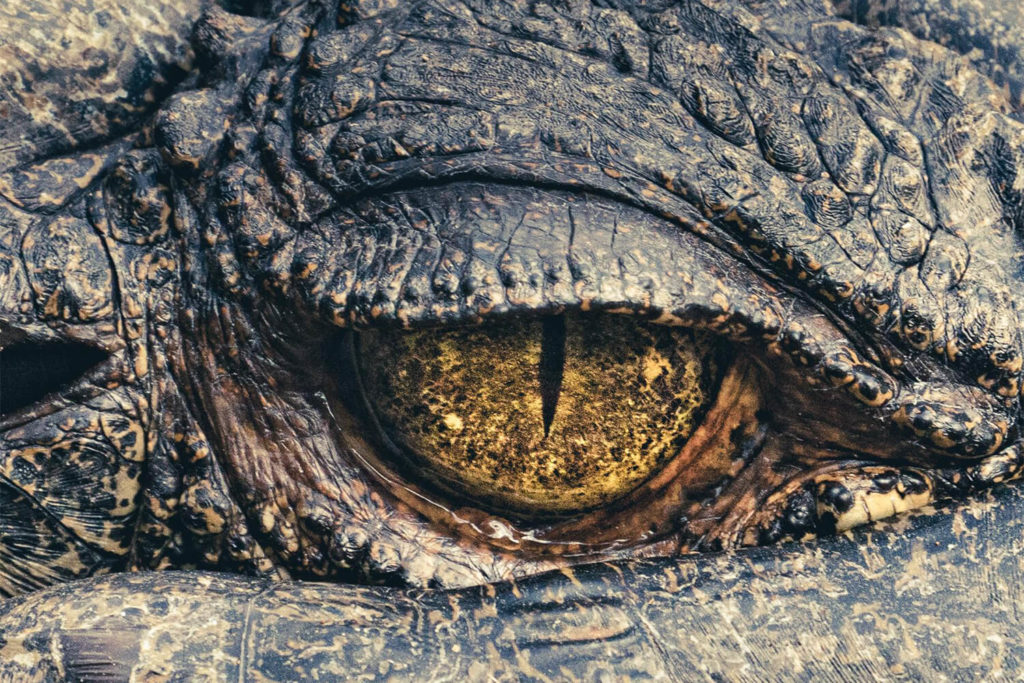
Close up of crocodile eye at Rainforestation Nature Park
You can see crocodiles all year round but you’re more likely to see them active during the warmer months.
One thing to remember is the warmer weather between September and April is breeding season for crocodiles and females guarding their nests will become aggressive.
Fun fact: crocodiles build nests on the ground to lay their eggs – around 50 eggs per nest. A bit like turtles, the heat of the nest determines the sex of all the hatchlings – with temperatures below 30 degrees resulting in females and above 32 degrees, all males.
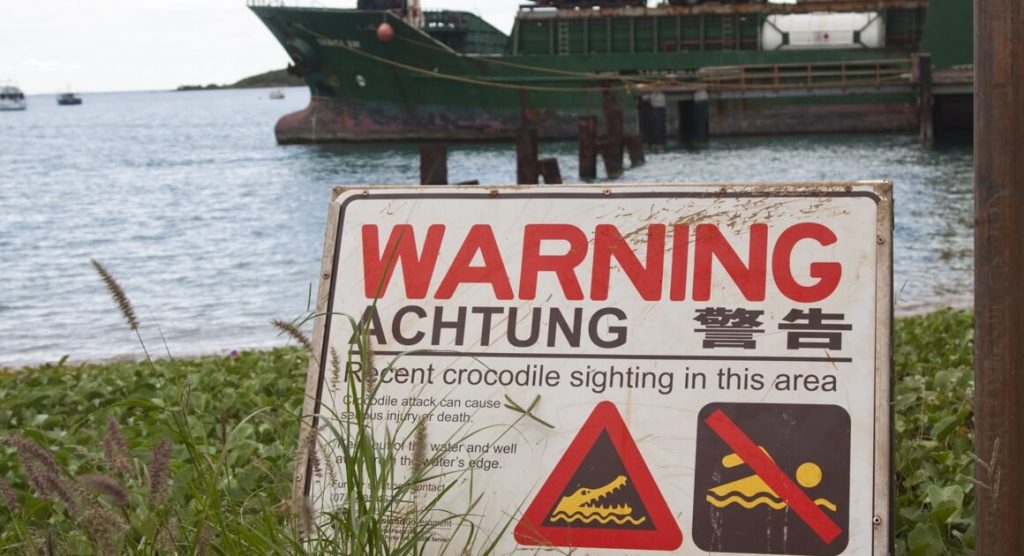
Always look out for crocodile warning signs
There’s no two ways about it – crocodiles are dangerous, but provided you’re sensible and stay croc-wise, you can still see them safely.
Remember these handy tips:
- Avoid the water’s edge – crocodiles are excellent hunters and frequently ambush and grab their prey from the water’s edge. Aim to stand at least 5m back.
- Don’t leave food scraps lying around – since fish are a staple diet for these reptiles they can be attracted to fishing scraps and bait lying around as an easy meal.
- Never feed a crocodile – it goes without saying, what you see in a wildlife park should never be tried in the wild. Feeding crocodiles is SO dangerous it’s actually illegal.
- Be vigilant in crocodile hunting hours – like most Australian natives, crocodiles are crepuscular (aka more active at dawn and dusk).
- Don’t make yourself crocodile bait by using small craft like kayaks and paddleboards in crocodile habitats.
- Keep your dog out of the water – dogs are the perfect meal size for crocodiles and are known to attract them, so keep them on a lead and away from the water.
- Report any sightings — If you spot a crocodile, you can log it in the Qwildlife App to help keep track of the movements and behaviour of crocodiles in the area.
How important are crocodiles to the eco system?
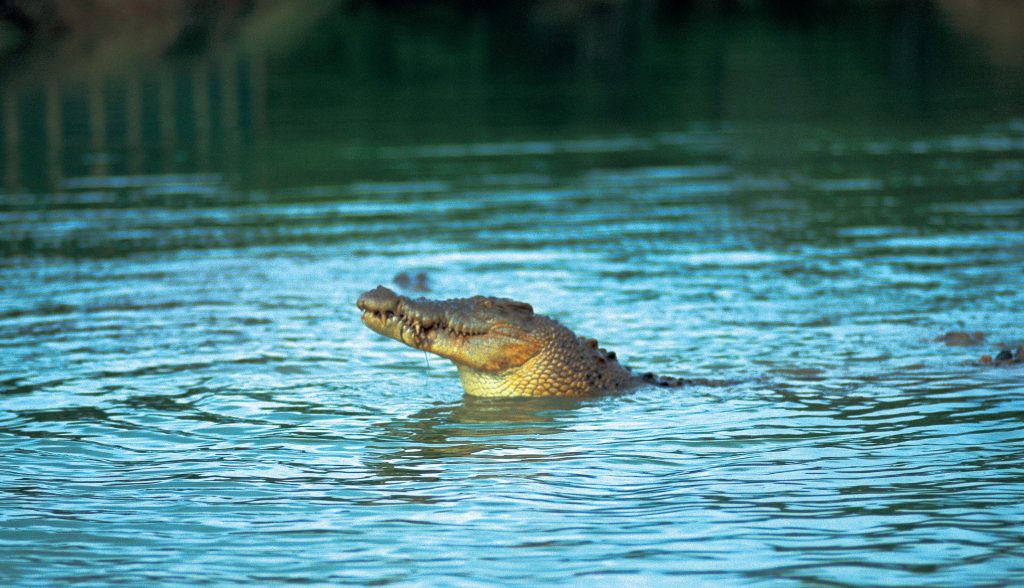
A wild crocodile in a river
Like most animals, crocodiles play an important function in the eco-system and are currently under protection after being destined for extinction due to serial poaching practices in the 1970s.
They’re designed to be predatory to help manage the wetland environment they inhabit, something they’ve successfully done for the past 200 million years.
Both freshwater and saltwater crocs play an important role in managing marine overpopulation, while equally protecting their estuaries from other predators who may otherwise move in.
While crocodiles are ferocious, apex predators, it’s important to remember humans remain one of their biggest threats, and these ancient inhabitants of Tropical North Queensland need protecting too.

What should you do if you see a crocodile?
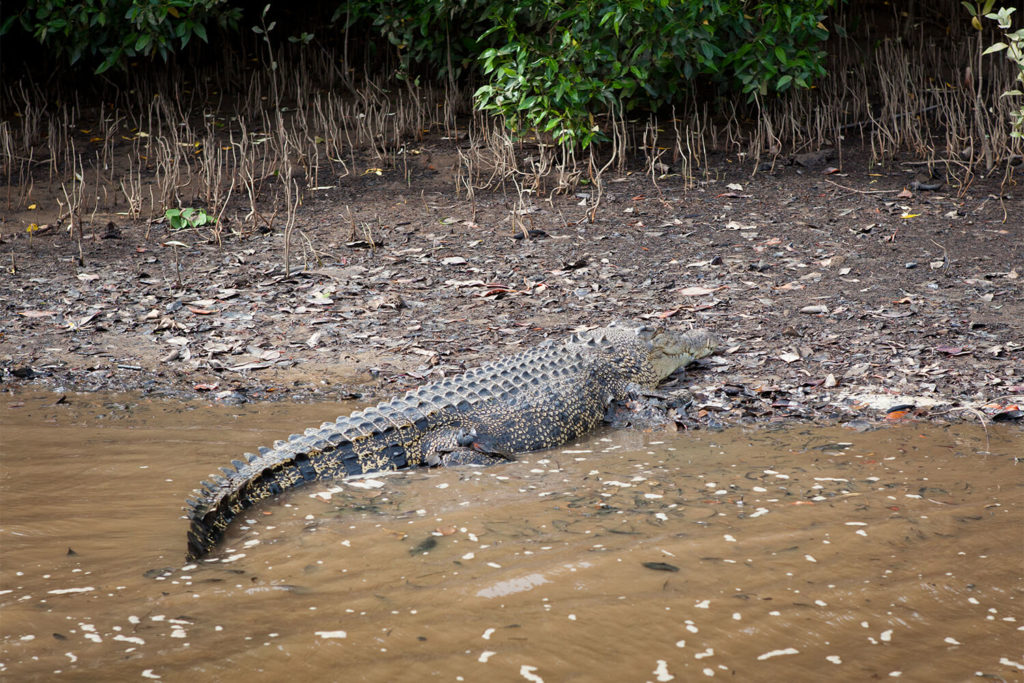
If you see a crocodile, report it
If you see a crocodile in the wild, it’s important you report your sighting as soon as possible to Queensland Parks & Wildlife, particularly if they are in an unexpected area.
You can do this in a few ways: by downloading the QWildlife app, accessing the sighting report online , or calling 1300 130 372.
These notifications help rangers track their movements and mitigate any potential risk to humans.
Discover unique nature experiences
From spotting the endangered Southern Cassowary to hand-feeding wallabies, Tropical North Queensland is an animal lover’s dream.
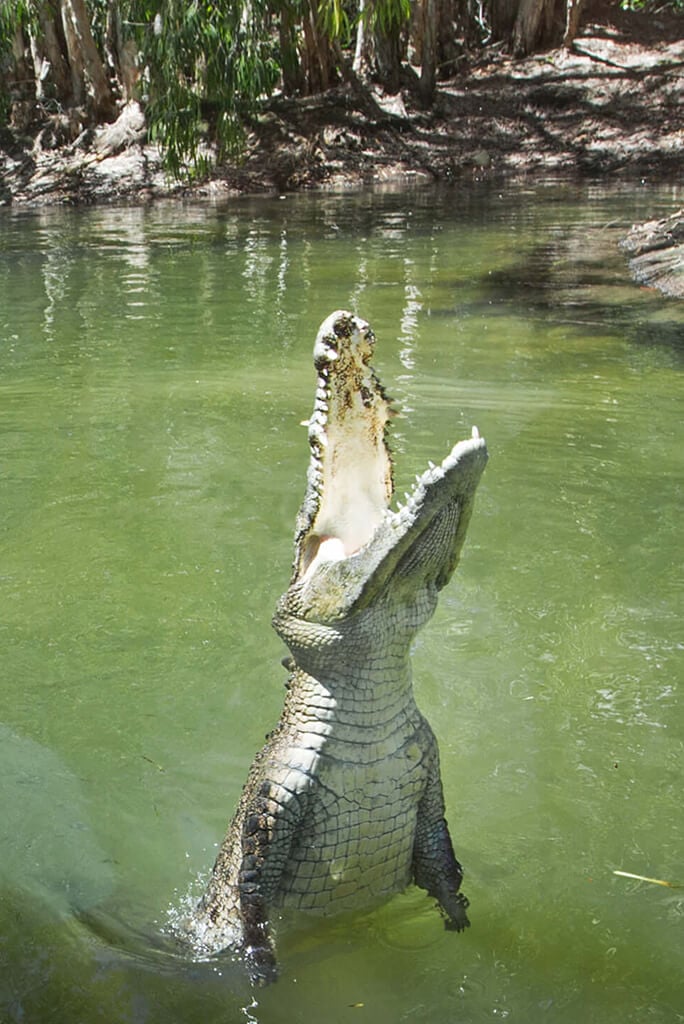
Things to do with little travellers at Hartley’s Crocodile Adventures
When you want to see Australian natives up close, it pays to visit an animal sanctuary who have perfected up close and personal experiences for more than eight decades, Hartley’s Crocodile Adventures.
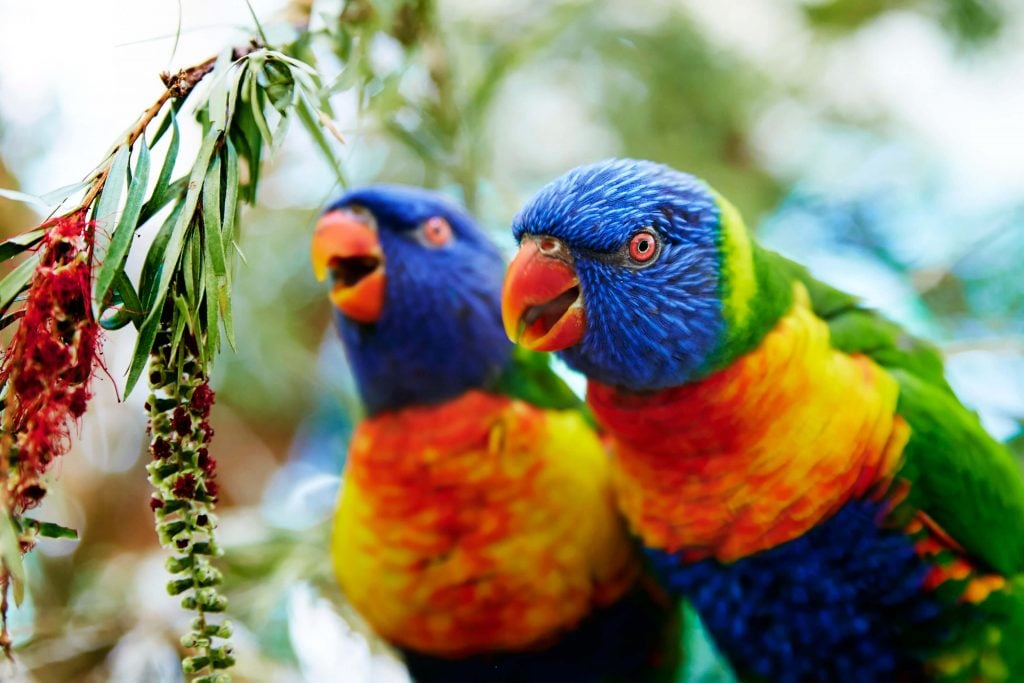
A wildlife warrior’s 3 day guide to the tropics
Love animals? Love nature? Love khaki? If you answered yes, this guide has your name written all over it, and we’re calling you a wildlife warrior from now on. Trek to the tropics for three days of nature in the north with this itinerary.
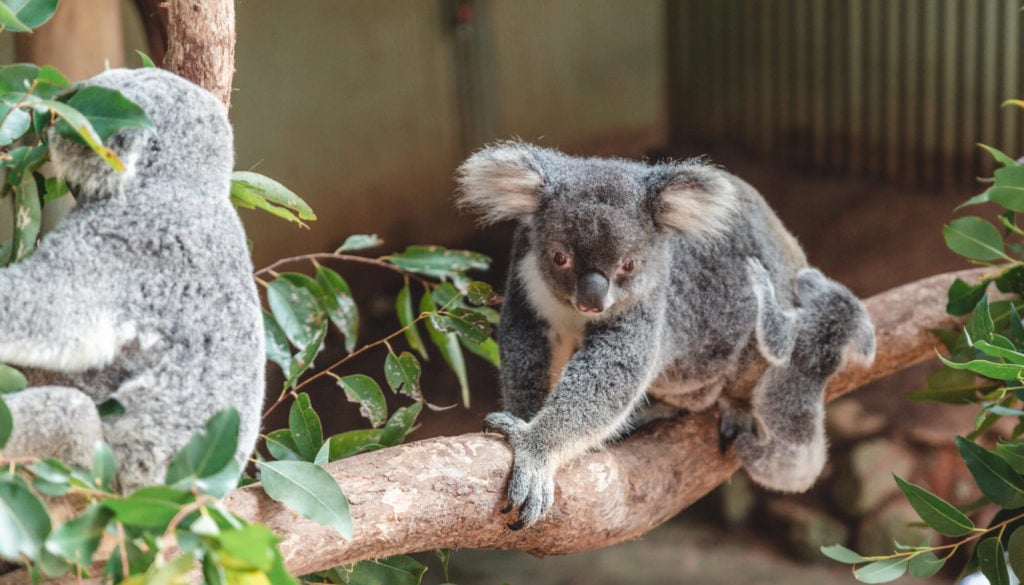
Where to have a guaranteed wildlife experience near Cairns
You know what rates as highly as the reef and rainforest on visitor’s to-do-lists when they come to Cairns? Having a wildlife encounter.
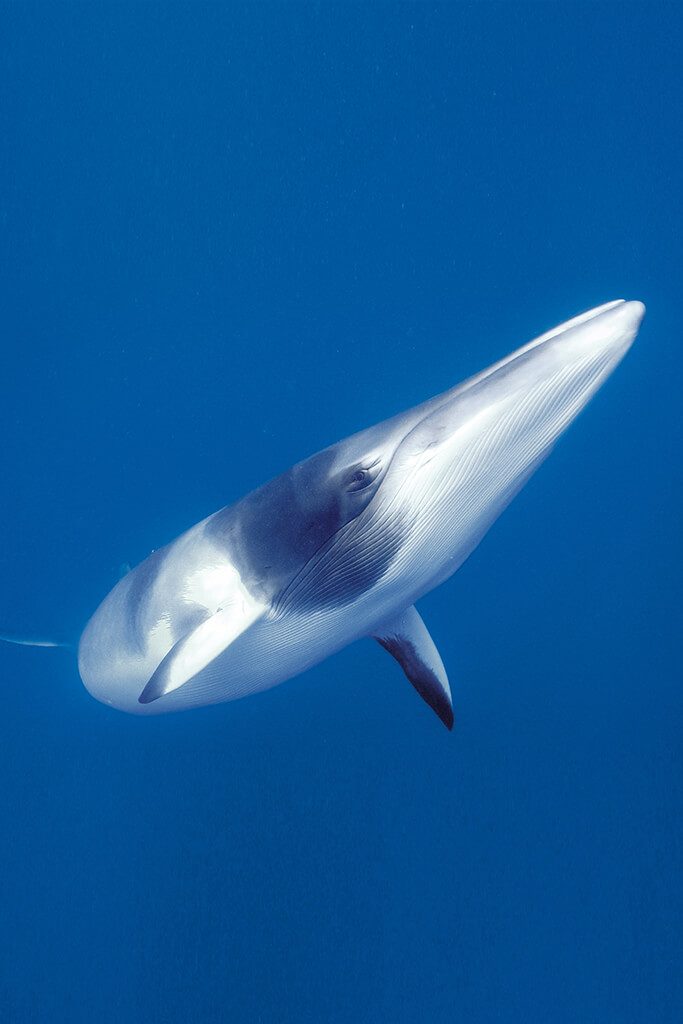
Swim with dwarf minke whales on the Great Barrier Reef
The Great Barrier Reef is the only place in the world that you can swim with dwarf minke whales: an experience so exclusive it only happens for two months of the year and only in Tropical North Queensland.
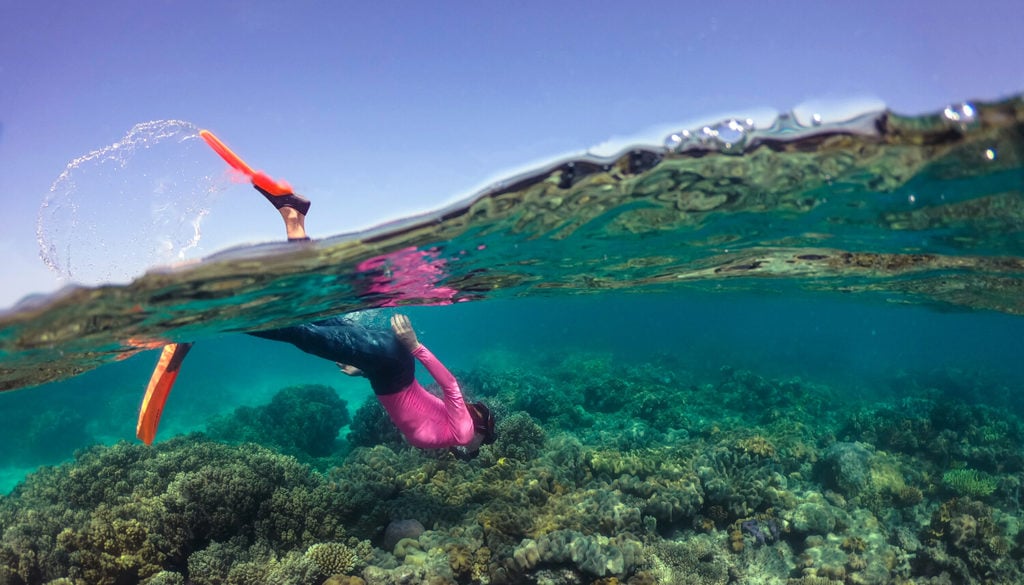
Fact or Fiction: 10 things you may not know about Tropical North Queensland
Thought you knew everything there is to know about Tropical North Queensland? Read on to put these common myths to bed.
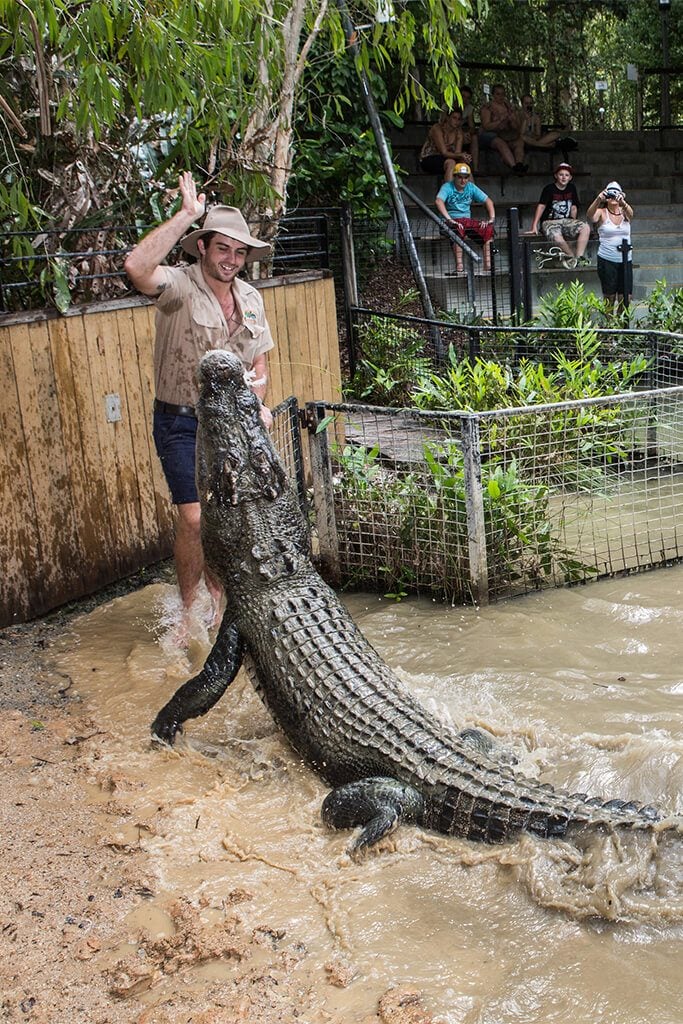
5 things you didn’t know about crocodiles
They may have a reputation as one of the planet’s most powerful creatures, but crocodiles are equally as fascinating as they are fearsome.
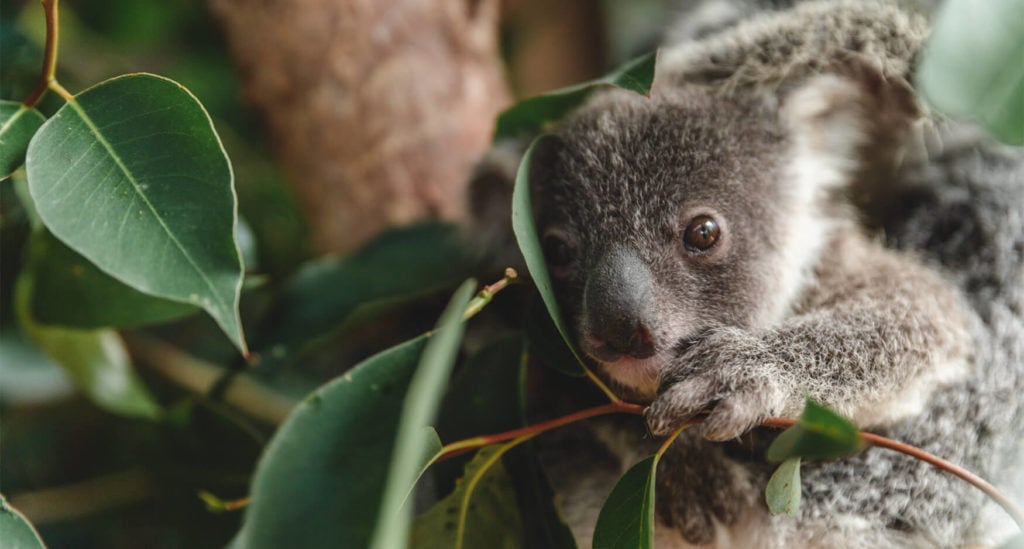
5 places to spot animals in Kuranda
Kuranda, the picturesque village on the Atherton Tablelands, is home to many of our tropical wild friends, so where better to go animal-spotting than at one of Kuranda’s many wildlife gardens and sanctuaries.
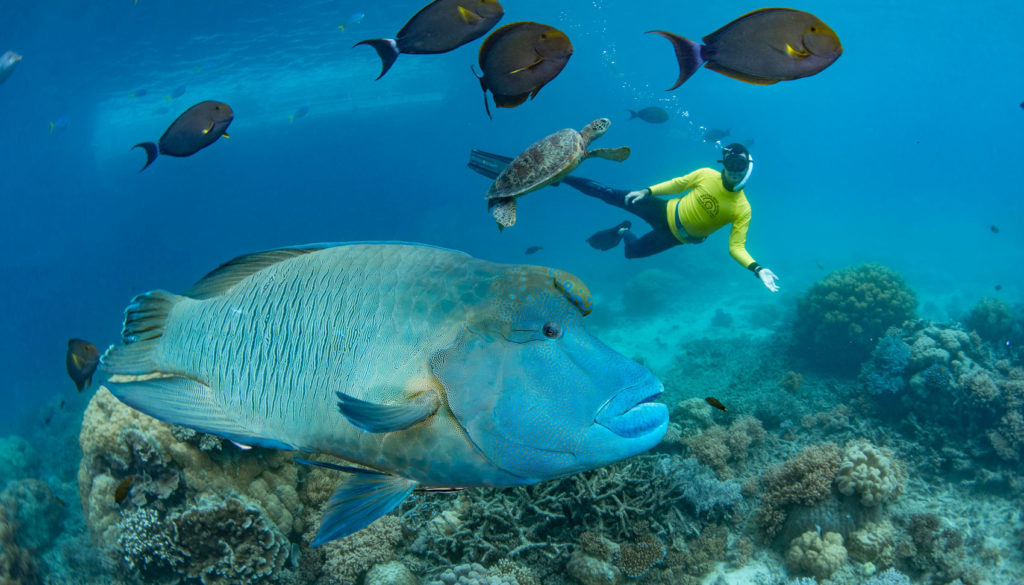
12 Famous residents of the Great Barrier Reef
Only 12 residents? There’s probably a gazillion of them, but let’s start things slowly shall we. It’s not easy to keep track of every single one of the Great Barrier Reef’s inhabitants but here are some of the most famous ones in Tropical North Queensland.

Everything you need to know about cassowaries
There’s plenty of reasons to visit Cairns & Great Barrier Reef in summer – balmy weather, crystal clear reef visibility and pumping waterfalls – but what you might not know is it’s also the best time of year to spot Australia’s living dinosaurs and their chicks, cassowaries.
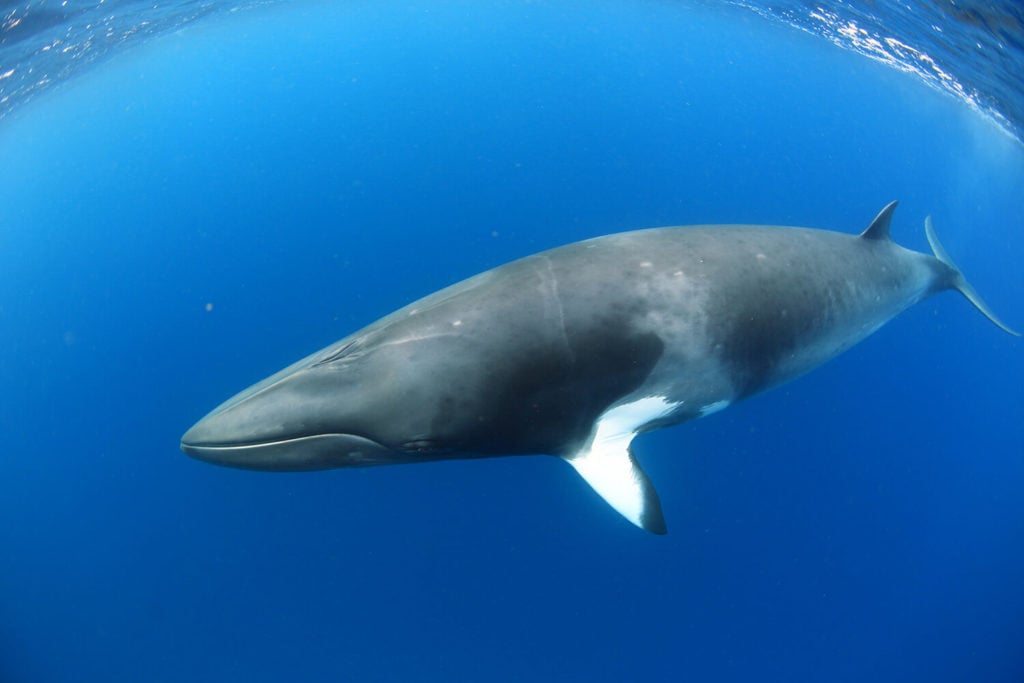
Moved By a Giant : Swimming With Dwarf Minke Whales
There’s nothing quite like coming face to face with a Dwarf Minke Whale on the Great Barrier Reef. Cathrine Best reflects on the moment she gazed into the eye of a gentle giant.
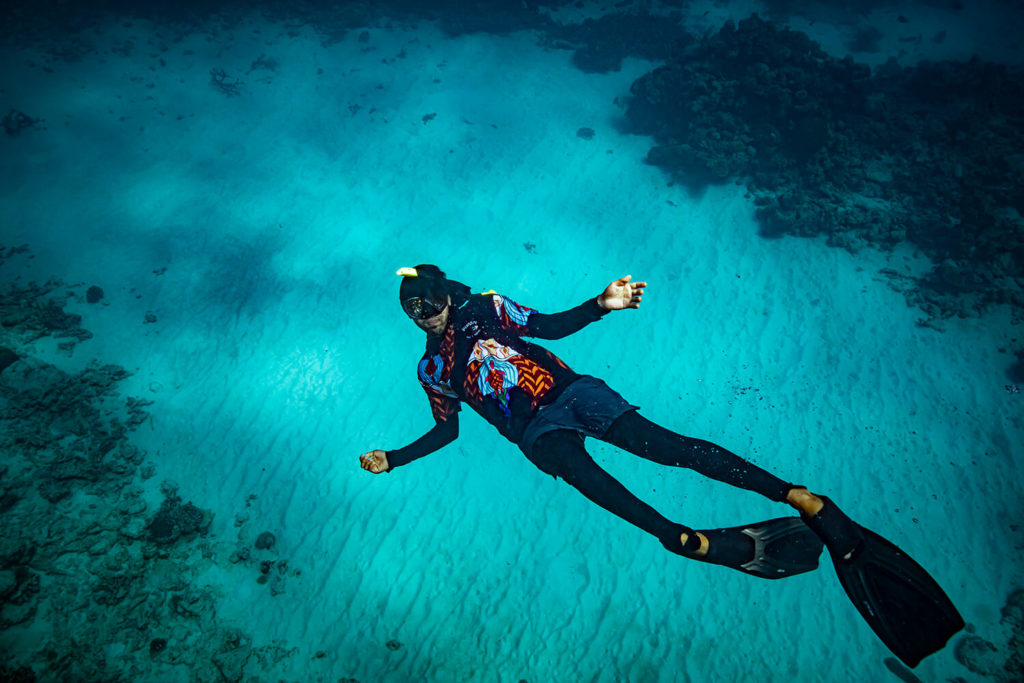
Reef Dreaming: Discover the Reef with Indigenous Rangers
As you discover the Great Barrier Reef, uncover the culture of the Traditional Custodians with personal interpretation by local Indigenous rangers on Dreamtime Dive & Snorkel.
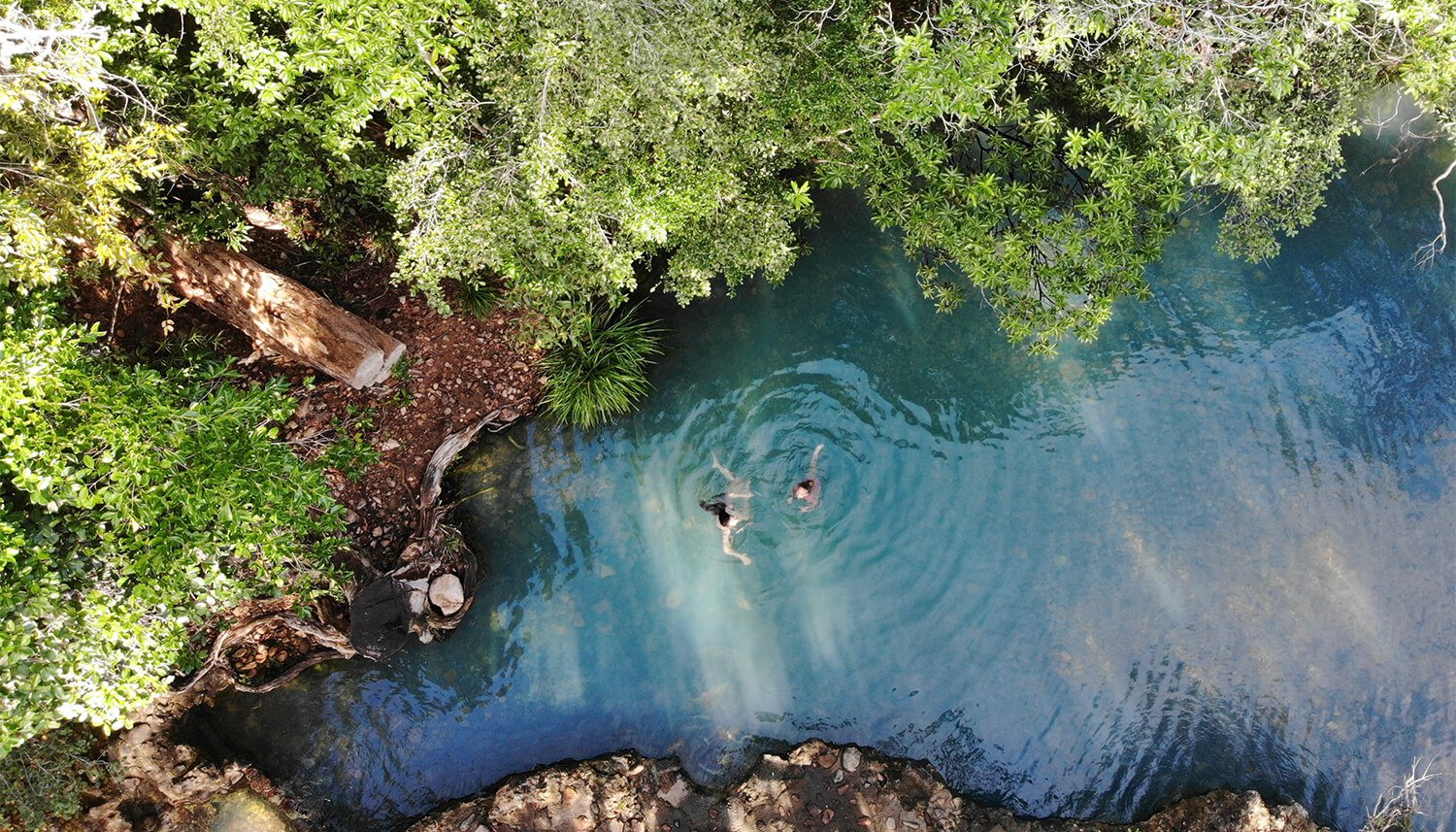
Swim safely
There are plenty of safe places to cool off in the tropics.
Privacy Overview
Accessibility, accessibility modes, online dictionary, readable experience, visually pleasing experience, easy orientation.
Cairns & Great Barrier Reef Accessibility Statement
Accessibility Statement
- tropicalnorthqueensland.org.au
- September 17, 2024
Compliance status
We firmly believe that the internet should be available and accessible to anyone, and are committed to providing a website that is accessible to the widest possible audience, regardless of circumstance and ability.
To fulfill this, we aim to adhere as strictly as possible to the World Wide Web Consortium’s (W3C) Web Content Accessibility Guidelines 2.1 (WCAG 2.1) at the AA level. These guidelines explain how to make web content accessible to people with a wide array of disabilities. Complying with those guidelines helps us ensure that the website is accessible to all people: blind people, people with motor impairments, visual impairment, cognitive disabilities, and more.
This website utilizes various technologies that are meant to make it as accessible as possible at all times. We utilize an accessibility interface that allows persons with specific disabilities to adjust the website’s UI (user interface) and design it to their personal needs.
Additionally, the website utilizes an AI-based application that runs in the background and optimizes its accessibility level constantly. This application remediates the website’s HTML, adapts Its functionality and behavior for screen-readers used by the blind users, and for keyboard functions used by individuals with motor impairments.
If you’ve found a malfunction or have ideas for improvement, we’ll be happy to hear from you. You can reach out to the website’s operators by using the following email
Screen-reader and keyboard navigation
Our website implements the ARIA attributes (Accessible Rich Internet Applications) technique, alongside various different behavioral changes, to ensure blind users visiting with screen-readers are able to read, comprehend, and enjoy the website’s functions. As soon as a user with a screen-reader enters your site, they immediately receive a prompt to enter the Screen-Reader Profile so they can browse and operate your site effectively. Here’s how our website covers some of the most important screen-reader requirements, alongside console screenshots of code examples:
Screen-reader optimization: we run a background process that learns the website’s components from top to bottom, to ensure ongoing compliance even when updating the website. In this process, we provide screen-readers with meaningful data using the ARIA set of attributes. For example, we provide accurate form labels; descriptions for actionable icons (social media icons, search icons, cart icons, etc.); validation guidance for form inputs; element roles such as buttons, menus, modal dialogues (popups), and others. Additionally, the background process scans all the website’s images and provides an accurate and meaningful image-object-recognition-based description as an ALT (alternate text) tag for images that are not described. It will also extract texts that are embedded within the image, using an OCR (optical character recognition) technology. To turn on screen-reader adjustments at any time, users need only to press the Alt+1 keyboard combination. Screen-reader users also get automatic announcements to turn the Screen-reader mode on as soon as they enter the website.
These adjustments are compatible with all popular screen readers, including JAWS and NVDA.
Keyboard navigation optimization: The background process also adjusts the website’s HTML, and adds various behaviors using JavaScript code to make the website operable by the keyboard. This includes the ability to navigate the website using the Tab and Shift+Tab keys, operate dropdowns with the arrow keys, close them with Esc, trigger buttons and links using the Enter key, navigate between radio and checkbox elements using the arrow keys, and fill them in with the Spacebar or Enter key.Additionally, keyboard users will find quick-navigation and content-skip menus, available at any time by clicking Alt+1, or as the first elements of the site while navigating with the keyboard. The background process also handles triggered popups by moving the keyboard focus towards them as soon as they appear, and not allow the focus drift outside it.
Users can also use shortcuts such as “M” (menus), “H” (headings), “F” (forms), “B” (buttons), and “G” (graphics) to jump to specific elements.
Disability profiles supported in our website
- Epilepsy Safe Mode: this profile enables people with epilepsy to use the website safely by eliminating the risk of seizures that result from flashing or blinking animations and risky color combinations.
- Visually Impaired Mode: this mode adjusts the website for the convenience of users with visual impairments such as Degrading Eyesight, Tunnel Vision, Cataract, Glaucoma, and others.
- Cognitive Disability Mode: this mode provides different assistive options to help users with cognitive impairments such as Dyslexia, Autism, CVA, and others, to focus on the essential elements of the website more easily.
- ADHD Friendly Mode: this mode helps users with ADHD and Neurodevelopmental disorders to read, browse, and focus on the main website elements more easily while significantly reducing distractions.
- Blindness Mode: this mode configures the website to be compatible with screen-readers such as JAWS, NVDA, VoiceOver, and TalkBack. A screen-reader is software for blind users that is installed on a computer and smartphone, and websites must be compatible with it.
- Keyboard Navigation Profile (Motor-Impaired): this profile enables motor-impaired persons to operate the website using the keyboard Tab, Shift+Tab, and the Enter keys. Users can also use shortcuts such as “M” (menus), “H” (headings), “F” (forms), “B” (buttons), and “G” (graphics) to jump to specific elements.
Additional UI, design, and readability adjustments
- Font adjustments – users, can increase and decrease its size, change its family (type), adjust the spacing, alignment, line height, and more.
- Color adjustments – users can select various color contrast profiles such as light, dark, inverted, and monochrome. Additionally, users can swap color schemes of titles, texts, and backgrounds, with over seven different coloring options.
- Animations – person with epilepsy can stop all running animations with the click of a button. Animations controlled by the interface include videos, GIFs, and CSS flashing transitions.
- Content highlighting – users can choose to emphasize important elements such as links and titles. They can also choose to highlight focused or hovered elements only.
- Audio muting – users with hearing devices may experience headaches or other issues due to automatic audio playing. This option lets users mute the entire website instantly.
- Cognitive disorders – we utilize a search engine that is linked to Wikipedia and Wiktionary, allowing people with cognitive disorders to decipher meanings of phrases, initials, slang, and others.
- Additional functions – we provide users the option to change cursor color and size, use a printing mode, enable a virtual keyboard, and many other functions.
Browser and assistive technology compatibility
We aim to support the widest array of browsers and assistive technologies as possible, so our users can choose the best fitting tools for them, with as few limitations as possible. Therefore, we have worked very hard to be able to support all major systems that comprise over 95% of the user market share including Google Chrome, Mozilla Firefox, Apple Safari, Opera and Microsoft Edge, JAWS and NVDA (screen readers).
Notes, comments, and feedback
Despite our very best efforts to allow anybody to adjust the website to their needs. There may still be pages or sections that are not fully accessible, are in the process of becoming accessible, or are lacking an adequate technological solution to make them accessible. Still, we are continually improving our accessibility, adding, updating and improving its options and features, and developing and adopting new technologies. All this is meant to reach the optimal level of accessibility, following technological advancements. For any assistance, please reach out to
share this!
February 29, 2024
This article has been reviewed according to Science X's editorial process and policies . Editors have highlighted the following attributes while ensuring the content's credibility:
fact-checked
reputable news agency
From edge of extinction to Australia's croc 'paradise'
by Andrew LEESON
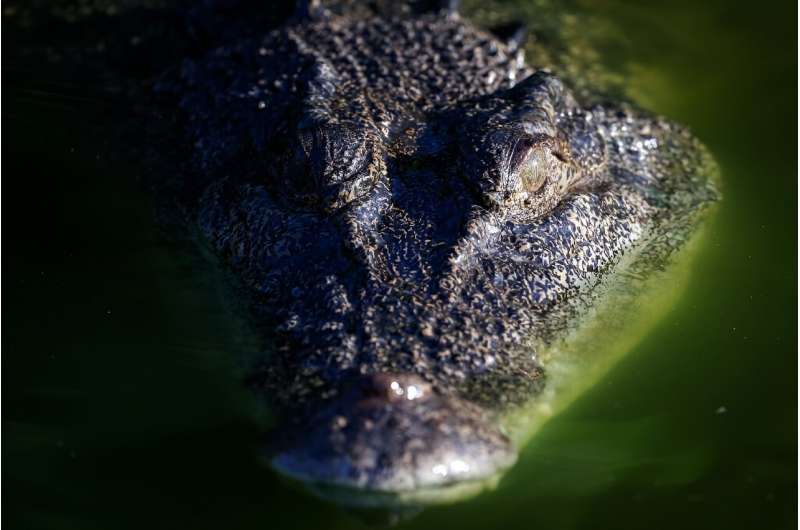
If you want a snappy death, one expert's advice is to leap into a river near the Australian city of Darwin—within minutes, you'll be in the jaws of one of the hundreds of crocodiles that stalk its murky waters.
That's the promise of Grahame Webb, whose conservation efforts are credited with helping wrestle Australia's saltwater predators back from the verge of extinction.
"You can't sugarcoat crocs; these are seriously dangerous," Webb told AFP in his leafy garden in the country's tropical Top End.
Blunt messaging about the dangers around the waterways of Australia's north has been vital to rebuilding a population of the scaly reptiles once decimated by uncontrolled hunting, he said.
Before government protection in the 1970s, an estimated 98 percent of the wild saltwater crocodile population had disappeared in the Northern Territory, driven by leather demand and culling.
Now, according to government figures, over 100,000 "salties", which can grow over six meters long and weigh more than 1,000 kilograms (2,200 pounds), hunt along the coasts, rivers and wetlands of the continent's far north.
'Eating people'
"It's been a raging success story," Webb said.
But protecting the animals was only a first step.
"To conserve predators, you've got to rebuild their population; if you're successful at doing that, they then start eating people again, and everyone wants to get rid of them."
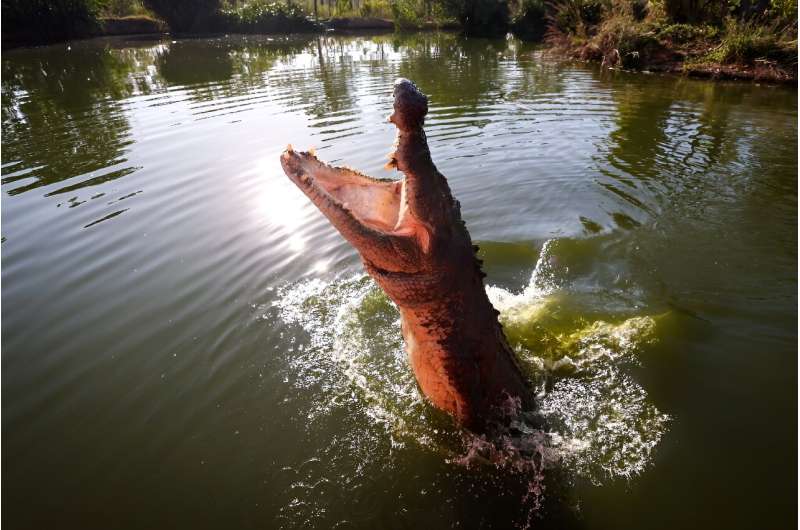
Charlie Manolis, a crocodile expert from the International Union for Conservation of Nature, said that by the 1980s, it was clear the community needed to see real value in the creatures to tolerate them as neighbors.
A public safety campaign, known locally as Crocwise, and regular relocations of the toothy predators from densely populated areas have helped them to coexist more peacefully with their sometimes-prey.
Wild egg harvesting is part of a "ranching" program in the Northern Territory that links the leather industry and livelihoods directly to the animals, according to colleagues Webb and Manolis.
Under the scheme, landholders—many of them Indigenous Australians—can receive payments for wild eggs collected from their properties, which are then supplied to ranches.
The lucrative leather trade relies on farms primarily stocked with eggs and animals plucked from the wild, with 70,000 eggs and 1,400 crocodiles allowed to be taken each year.
"There are quite a lot of people who are employed through crocodiles," Webb said, highlighting both tourism and farming industries.
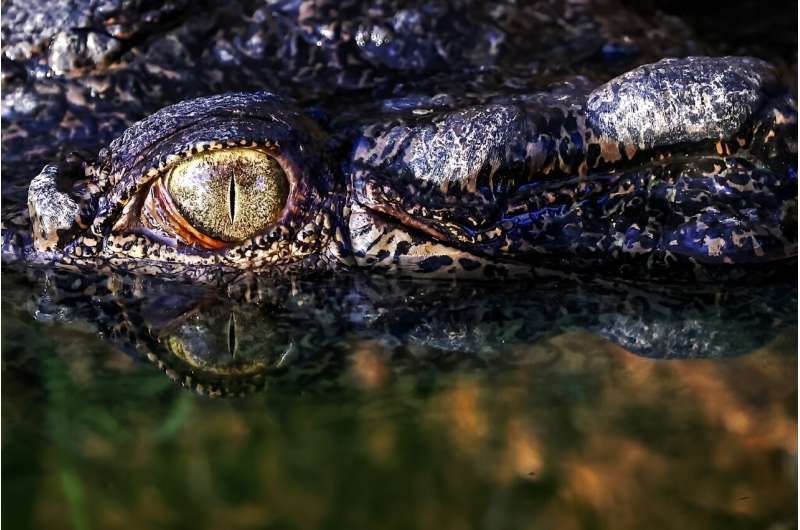
'Cattle eater'
The crocodile farming industry has been estimated to be worth over Aus$100 million (US$66 million) a year to the Territory, which is the largest producer of skins in Australia. The resulting leather is highly prized by luxury brands such as Hermes and Louis Vuitton.
Manolis said that although some people are critical of the management strategy for "using" animals and removing them from the wild, the connection to an industry has helped save the species from mass culls.
"It's not about farming, per se. Farming is what we used to make sure the wild population is conserved," he said.
"I was in mining, then I was a mother, and now I'm a croc keeper," Jess Grills, 32, told AFP with a smile as she manoeuvred a boat through an artificial river at Crocodylus Park near Darwin.
The park, founded by Webb, is a tourist attraction and "paradise" for "problem crocs"—animals removed from the wild for posing a danger to locals or developing a soft spot for chomping on livestock.
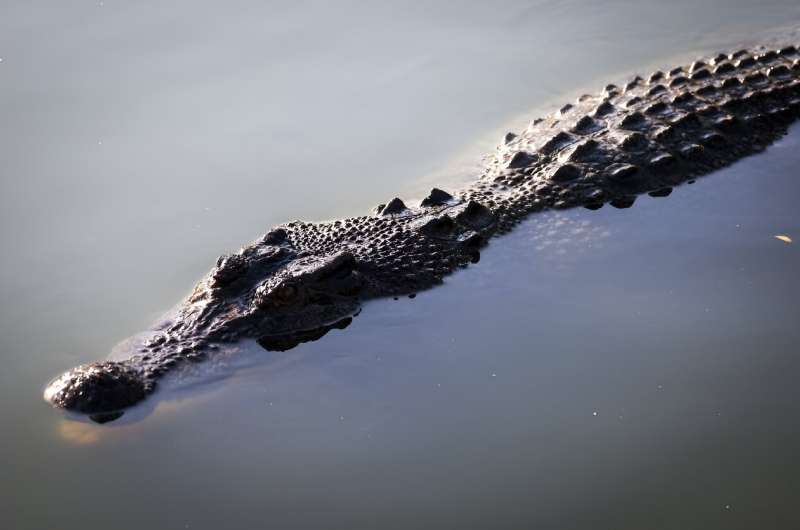
"You can't train a crocodile, but you can put them in a place where they are not going to be a problem," she said as she routinely hoisted a hock of meat tethered to a long pole over the side of the boat.
She slapped the water with the bait and dangled it above.
The dark green muzzle of a once notorious "cattle-eater" called Prince slowly surfaced, followed by the glaring reptilian eyes.
The creature launched its hulking body upwards, its jaws at full stretch, before clamping its teeth deep into the flesh and splashing back into the water.
The message is clear for onlookers: be wary around where these giants hunt and live.
'A million years' of fear
"You've always got to speculate that there is a crocodile in the water, no matter what," Grills said.
As populations boom and larger crocs become common, attacks, though rare, are likely to increase, Manolis said
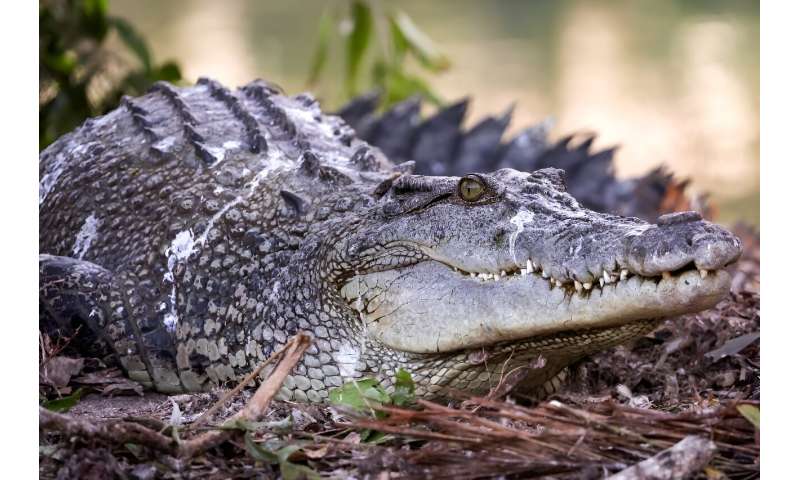
Dealing with a fear that goes back "a million years" while keeping support for conservation will be "the biggest challenge", Manolis said.
"Let's face it, WWF (World Wildlife Fund) doesn't have a picture of a crocodile on it. It has a panda."
For Grills, the chance to admire the predators up close helps get support to save the animal.
"If you respect them and their territory, I don't think they would be as terrifying."
Explore further
Feedback to editors

Biologists find that hardship early in life can affect health and longevity—even for marmots
10 minutes ago

Possum shrimp use their cave's special smell to trace their way home, study finds
9 hours ago

Researchers test ChatGPT, other AI models against real-world students
16 hours ago

Study finds mine-drainage treatment cost effective, but far more costs lay ahead

Researchers develop new method for delivering RNA and drugs into cells
17 hours ago

Scientists discover how TGF-Beta sends its message even while tethered to the cell membrane

New algorithm rights wrongs of precipitation-type classification over Tibetan Plateau

An AI tool for scanning sand grains opens windows into recent time and the deep past
18 hours ago

Scientists discover nonstomatal control of water loss in critical crops

Researchers find golden eagles improve their flight skills with age
Relevant physicsforums posts, why does a series of pulses generate a pitch.
Sep 15, 2024
Epothilone B study connected to 'Hard Problem of Consciousness' Model
Sep 9, 2024
Any stereo audio learning resources for other languages?
Sep 8, 2024
Too much fluoride might lower IQ in kids?
Sep 6, 2024
The predictive brain (Stimulus-Specific Error Prediction Neurons)
Sep 1, 2024
Any suggestions to dampen the sounds of a colostomy bag?
Aug 31, 2024
More from Biology and Medical
Related Stories

Australian rangers trap big crocodile near tourist gorge
Jul 10, 2018

A croc's life: There's more than meets the eye
Nov 3, 2023

770-pound crocodile caught at Outback tourist destination
Aug 31, 2020

Vaccine developed to protect crocodiles and multi-million dollar industry
Jun 29, 2023

Saltwater crocodiles are slowly returning to Bali and Java. Can we learn to live alongside them?
Oct 17, 2023

Banning exotic leather in fashion hurts snakes and crocodiles in the long run
Mar 27, 2019
Recommended for you

New 'grumpy' fish species discovered in the Red Sea
22 hours ago

Flowers use adjustable 'paint by numbers' petal designs to attract pollinators, researchers discover
Sep 13, 2024

Soil pH drives microbial community composition: Study shows how bacteria work together to thrive in difficult conditions

Hawk-eyed photographer snaps threatened bird feared lost
Let us know if there is a problem with our content.
Use this form if you have come across a typo, inaccuracy or would like to send an edit request for the content on this page. For general inquiries, please use our contact form . For general feedback, use the public comments section below (please adhere to guidelines ).
Please select the most appropriate category to facilitate processing of your request
Thank you for taking time to provide your feedback to the editors.
Your feedback is important to us. However, we do not guarantee individual replies due to the high volume of messages.
E-mail the story
Your email address is used only to let the recipient know who sent the email. Neither your address nor the recipient's address will be used for any other purpose. The information you enter will appear in your e-mail message and is not retained by Phys.org in any form.
Newsletter sign up
Get weekly and/or daily updates delivered to your inbox. You can unsubscribe at any time and we'll never share your details to third parties.
More information Privacy policy
Donate and enjoy an ad-free experience
We keep our content available to everyone. Consider supporting Science X's mission by getting a premium account.
E-mail newsletter
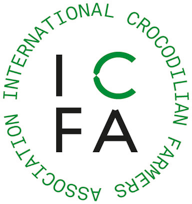
Crocodilians conservation
- Historically, the social value of crocodilians was largely restricted to them being dangerous pests, hunted without regulation. The hunting was incentivised, and continued unabated, when skins became economically valuable. For many Indigenous people, the hunting of crocodilians and harvesting of eggs, for food, has occurred for millenia, sometimes governed by complex cultural systems and values. At the same time, wetlands were being converted to agricultural farmland, for commercial food production. By the 1960’s, reducing wild crocodilian populations because they were pests, was overtaken by social concerns about possible extinction. Yet for many countries, the institutional and legal frameworks needed to regulate wildlife conservation, management and use were embryonic.
- In the 1960’s, International trade was recognised by IUCN, the world recognised environmental protection agency, as the fundamental process linking supply from countries without the capacity to regulate, to demand, within developed consumer nations. IUCN championed the cause of an international legal instrument to regulate trade, which saw CITES come into force in 1975. The Parties to CITES have all established better legislation to manage wildlife in trade. and comply with CITES. For species in trade conservation and management programs now exist.
- Crocodilian farming was developed in the 1950’s and 1960’s, firstly as a mechanism for the ex-situ production of crocodile skins, and later as a mechanism for restocking and supplementing wild populations. Farms have played a central role in avoiding extinction of crocodilian species in trade. In many remote regions, revenues derived from sustainable harvest of crocodilian eggs or juveniles provide incentives to local communities to protect and sustain wetland environments, rather than convert them to other forms of productive land-use.
Papers on conservation cases
- Northern Territory Government - Saltwater crocodile management program
- Louisiana's alligator management program - Annual report
- The following case studies show the successful relationship between farming and the conservation of crocodilians:
Alligator in the United-States : The conservation program developed in Louisiana has permitted numbers to reach around 2 million alligators in 2016 (from less than 10 000 nests in 1970 to almost 51 000 estimated in 2017). Young animals born in the farms are also reintroduced to the wild to ensure a regular restocking. In Louisiana, 10% of the young are reintroduced in the environment. The survival rate of young alligators has tripled with this program, from 3 to 9%.
Porosus in Australia : Crocodiles were protected in the 1970s after their numbers in the wild were severely depleted due to hunting. By the 1980s, numbers had once again flourished, increasing public safety concerns after a number of fatal attacks. As a result, the most apparent way to leverage support for continuing conservation was through the introduction of sustainable use programs to generate an income for landowners, from the increasing crocodile resource. Crocodile farms purchased wild eggs, providing an incentive for landowners to conserve crocodiles. The egg harvest itself, has no discernible negative impact on the wild population of Saltwater crocodiles, which increased from an estimated 5000 individuals in 1971, to between 30,000 and 40,000 in 1984, and has now stabilised at around 100,000 individuals. The growing abundance of crocodiles in the wild regions of the Northern Territory, Queensland and Western Australia, especially in the last 10 years, provides flow-on benefits for the growing tourism industry, with visitors paying to view these protected habitats, generating further revenues for regional indigenous and non-indigenous populations.
Crocodylus acutus in Colombia : The Crocodilus acutus is the most widely distributed in Americas, ranging from the southern tip of Florida to northern South America. Overexploitation and unregulated commercial hunting from the 1930s to the 1960s led to a severe decline of their population. The government of Colombia decided to ban the hunting in 1968, and then shaped conservation programs based on sustainable use.
Beside the pilot project for the recovery and conservation of the species in Cispatá Bay, the Colombian commercial farms registered with CITES are involved in conservation programs which can take different shapes: they can choose to return 5% of the captive populations to the wild or decide to finance social and / or environmental programs. This is an example of conservation of the species through the sustainable utilization of a wild resource.
Crocodylus moreletii in Mexico : The use of crocodiles as food or medicinal purposes goes back to earlier times when the indigenous people of the coasts of Mexico captured them in rivers and estuaries. There is data about the commercial exploitation of the skins of the crocodiles in Mexico since 1855. In 1902, the tanneries of United States received about 280,000 crocodile’s skins, half of them coming from Mexico and central America. In the 1940s, Mexico began the tanning of the crocodile skins and the industrialization of the fat, the bones, the meat and the musk.
In the 1970s, wild population had severely declined and were under threat. The Mexican government totally banned hunting and exploitation in 1970, and Morelet was included in CITES in 1975. Thanks to active conservation policy, the specie is no longer considered in danger of extinction since 2004, with a population around 100 000 individuals.
Coordinated by the Mexican CITES Scientific Authority (CONABIO), pilot conservation programs are involving both farms and local communities for the conservation of the species and their habitat. The sustainable use model is based on the sales of hatchlings to farms.
The Nile crocodile in South Africa : Throughout its distribution in Africa, the Nile crocodile has long been associated with spiritual power and exists within a great diversity of human cultures, in a variety of social and economic contexts.
Nile crocodiles were severely exploited for their skins in an uncontrolled manner throughout their distribution in Africa, during the early and mid-19th century. They had largely been exterminated in the 1900’s having been classified as vermin. More recently declines outside protected areas have occurred due to increased agricultural activities, human encroachment and loss of habitat. In the early 1990’s the total wild Nile crocodile population in South Africa was estimated to be around 9500. The most recent 2017 – 2019 aerial count of the wild Nile crocodile population is 10 663, mainly occurring in protected areas. In contrast, the productive breeding populations in private ownership now exceeds 16 500 mature breeders.
The growth in crocodile populations in private ownership was enabled through legalised trade in crocodile products. South Africa became a member state of the Convention on International Trade in Endangered Species (CITES) in 1975 and in 1992 trading in South African crocodile skins was permitted by CITES. The South African Constitution recognises the ecological sustainable utilisation of natural resources. Local legislation and regulations have been adopted to promote, control and protect utilisation of wildlife, including wild crocodile populations outside of protected areas.
Crocodile farming is recognized by the government as a participant to the overall biodiversity economy of the country. The crocodile industry supports a wide range of research that indirectly benefits conservation, has offered its support for the monitoring of wild populations and is committed to supply crocodiles for reintroduction to the wild, if required by conservation agencies.
Legalised trade has contributed significantly in the reduction in poaching and hunting of wild crocodiles used for commercial trade. Some localised illegal poaching, mainly for supply to the traditional medicines and witchcraft still remain. Reprisal killing of crocodiles and destruction of nests occur in response to attack on humans and livestock by people living close to the same water resources.
Based on several successful conservation programs, protection of wild crocodile populations outside protected areas usually succeed when direct economic incentive is made to local communities living close to the wild populations. The crocodile industry and South African government is collaborating to develop partnerships and incentives for communities that live near waterbodies where wild crocodiles occur. These initiatives include skills development programmes and job creation within the wildlife tourism and related activities and by introducing communities to commercial crocodile farming businesses.
Official documents from conservation agencies
IUCN ABU DHABI : IUCN experts are calling for global species conservation actions, including sustainable use.
The Abu Dhabi Call for Global Species Conservation Action_FINAL_ADOPTED_091019
AFWA : The Association of Fish and Wildlife Agencies adopted a resolution reaffirming its support for the sustainable use and regulated trade of fish and wildlife.
AFWA sustainable use resolution
The following articles provide further examples and commentary related to sustainable farming of crocodilians
- Rosie Cooney Letter, December 3rd 2018
- Is banning exotic leather bad for reptiles?

Dundee campaign © Tourism Australia
Crocodile Dundee inspires $36m American tourism push.
On 5 February 2018 at the Super Bowl, the most watched television broadcast in the United States, Tourism Australia kicked off a $36 million marketing push aimed at supercharging the value of American tourism Down Under.
Supported by Qantas, American Airlines and Wine Australia and featuring appearances from some of Australia’s biggest celebrities, the campaign is the largest Tourism Australia has run in the United States since Paul Hogan’s famous Come Say G’Day ads more than 30 years ago.
Campaign results (as at June 2018)
- 102M+ video views on social media
- 14K+ media articles
- $85M+ equivalent advertising value
- 367K+ total leads generated from australia.com
- 103.3M television commercial ratings - 10th most-watched program in the USA, ever
- 9.2B audience reached through articles
- 30% increase in sales to the trade
- 8 Cannes Lions coveted advertising awards
Dundee Movie: Visit The Set
In October 2018 Tourism Australia launched the next phase of the campaign with a series of videos inviting Americans to book a trip Down Under and visit the ‘set’ of the movie.
Starring Aussie actor Luke Hemsworth, the videos take US travellers on an exclusive behind the scenes tour of the Dundee movie backlot, showcasing the breadth of spectacular and unique experiences on offer across Australia.
Campaign marketplace
To convert interest into bookings, Tourism Australia has also published tailored travel itineraries and inspiring destination information on Australia.com supported with a dedicated campaign ‘marketplace’ which includes airfare and tailored holiday offers from 20 campaign partners, all aimed at encouraging Americans to book a trip Down Under.
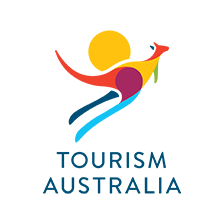
We use cookies on this site to enhance your user experience. Find out more .
By clicking any link on this page you are giving your consent for us to set cookies.
Subscribe to our news
Good news is essential! Subscribe to learn about opportunities for your business, as well as the latest destination and tourism products in our Essentials newsletter and more.
Acknowledgement of Country

We acknowledge the Traditional Aboriginal and Torres Strait Islander Owners of the land, sea and waters of the Australian continent, and recognise their custodianship of culture and Country for over 60,000 years.
*Disclaimer: The information on this website is presented in good faith and on the basis that Tourism Australia, nor their agents or employees, are liable (whether by reason of error, omission, negligence, lack of care or otherwise) to any person for any damage or loss whatsoever which has occurred or may occur in relation to that person taking or not taking (as the case may be) action in respect of any statement, information or advice given in this website. Tourism Australia wishes to advise people of Aboriginal and Torres Strait Islander descent that this website may contain images of persons now deceased.

Articles on Crocodiles
Displaying 1 - 20 of 41 articles.

I’ve researched crocodile attacks for years. Videos of people feeding crocodiles at site of latest attack are deeply concerning
Brandon Michael Sideleau , Charles Darwin University

The latest crocodile attack is tragic – but the Northern Territory doesn’t have a croc problem

Your smartphone might be linked to crocodile attacks in Indonesia. Here’s how

Crocs love feral pigs and quolls have a taste for rabbit – but it doesn’t solve the invasive species problem
Euan Ritchie , Deakin University
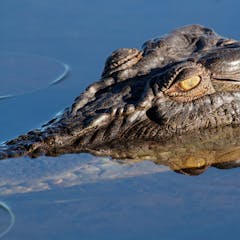
The Northern Territory does not have a crocodile problem – and ‘salties’ do not need culling

Crocodiles are uniquely protected against fungal infections. This might one day help human medicine too
Scott Williams , La Trobe University and Mark Hulett , La Trobe University

Reptiles: why one in five species face extinction
Louise Gentle , Nottingham Trent University

Traces of giant prehistoric crocodiles discovered in northern British Columbia
Guy Plint , Western University and Charles Helm , Nelson Mandela University

Curious Kids: how did crocodiles survive the asteroid that killed the dinosaurs?
Mike Lee , Flinders University

Lizards, snakes and turtles: Dispelling the myths about reptiles as pets
Melanie Denomme , Brock University and Glenn J Tattersall , Brock University

Prehistoric ‘river boss’ is the largest extinct croc species ever discovered in Australia
Jorgo Ristevski , The University of Queensland and Steven W. Salisbury , The University of Queensland

Friday essay: reckoning with an animal that sees us as prey — living and working in crocodile country
Michael Bradley , James Cook University

Crocodiles today look the same as they did 200 million years ago – our study explains why
Max Stockdale , University of Bristol

Humpback whales have been spotted in a Kakadu river. So in a fight with a crocodile, who would win?
Vanessa Pirotta , Macquarie University

Meet North Queensland First, the party that wants to kill crocs and form a new state
Claire Brennan , James Cook University

Reptiles: one in three species traded online – and 75% aren’t protected by international law
Tanya Wyatt , Northumbria University, Newcastle

What living alongside crocodiles can teach us about coexisting with wildlife
Simon Pooley , Birkbeck, University of London and Silvio Marchini , University of Oxford

Fossil track sites tell the story of ancient crocodiles in southern Africa
Charles Helm , Nelson Mandela University

Climate change created today’s large crocodiles
Pedro L. Godoy , Stony Brook University (The State University of New York)

In the remote Cambodian jungles, we made sure rare Siamese crocodiles would have enough food
Paul McInerney , La Trobe University
Related Topics
- Conservation
- crocodile attack
- northern territory
- Wildlife conservation
Top contributors
PhD student studying human-saltwater crocodile conflict, Charles Darwin University
Senior Research Associate, Charles Darwin University
Managing Director, Triple Helix Consulting; Chief Executive Officer, Australian Centre for International Agricultural Research; Professorial Fellow, ANU Fenner School for the Environment and Society, Australian National University
Adjunct Professor, Environment & Livelihoods, Charles Darwin University
Professor - Spatial Science, Charles Darwin University
Research Associate, African Centre for Coastal Palaeoscience, Nelson Mandela University
Lecturer in History, James Cook University
Lecturer in Ornithology, Ecology, Conservation and Parasitology, Charles Sturt University
PhD student, Imperial College London
Post-doctoral research fellow, The University of Queensland
Director, The Cairns Institute, James Cook University
Researcher and PhD Candidate, CQUniversity Australia
Adjunct Lecturer (Clinical), Medicine, James Cook University
Senior Lecturer in Political Science: Research Fellow at the Cairns Institute; Research Associate for Centre for Policy Futures, University of Queensland, James Cook University
Professor of Tourism & Director, Centre for Tourism and Regional Opportunities, CQUniversity Australia
- X (Twitter)
- Unfollow topic Follow topic

IMAGES
VIDEO
COMMENTS
Valued at more than AU$100 million, the Northern Territory's crocodile industry isn't just important to the local economy, but also to croc conservation, with croc tourism - and even croc farming - credited for an enormous rebound in their numbers since they became a protected species in the 1970s. There are now loads of ways to see a ...
And in Bali, it's unlikely we'll see any crocodile recovery because of the importance of beaches to tourism and a high human population. This 4.6-metre saltwater crocodile was captured in ...
Jennifer Hayes: I found myself face-to-snout with an American crocodile. Both surprised and very pleased, I greeted him through my regulator. DD: She gave me a quick thumbs-up, nodded OK, and ...
"Crocodile Dundee" came out in theaters in the U.S. 30 years ago, on Sept. 26, 1986. ... The government actually built a road from Darwin to Kakadu—not for tourism, but for mining." Today ...
Chap4: Tourism impacts on crocodiles • Intro: public safety, croc safety, croc attacks and tropical wetlands management • potential impacts of tourism on crocodiles habitats and management in the Top End - secondary data from Yellow water report and overseas studies (US alligators + African crocs) • tourism impacts on crocodile behaviour
Through an Instagram video, you can see a crocodile swimming very close to some tourists in the crystal clear waters of a cenote in Tulum. TULUM QUINTANA ROO (Social Media) - The crocodile's name ...
2016. How Paul Hogan Changed Tourism in Australia. On Sept. 26, 1986, "Crocodile Dundee" hit theaters in the United States, and Paul Hogan became the face of Australia. To celebrate the 30th anniversary of the screening of Crocodile Dundee in the USA, Jessica Plautz, a reporter for America's most famous travel magazine, Travel + Leisure ...
When it comes to tourism in Darwin and the Top End, crocodiles play a significant role in attracting visitors from around the world. The region's unique ecosystem, rich biodiversity, and the allure of witnessing these prehistoric creatures in their natural habitat make crocodile tourism a thriving industry.
In the NT's $2 billion tourism industry, the crocodile is the star.(ABC News: Michael Franchi) As croc numbers have grown since the 70s, so too has the commercial value of crocodiles.
Costa Rica's 'Crocodile Bridge' is an unlikely tourist attraction. Link Copied! Crocodile rock: The crocs who live here can reach up to 7 meters (23 feet) long. Photo op: Feeding the ...
And so he and his colleagues swung their weight behind crocodile farming and tourism to transition croc protection into an economically valuable proposition. It was the beginning of what's now known as "incentive-driven conservation", which has helped transform wild crocodiles into a commodity, underpinning goods and services worth well ...
Reduce human activities in the vicinity of crocodile nests during the nesting season, both by tourism service providers and managers of natural areas. Disseminate information about the potential for negative incidents, using various media platforms and with an emphasis on season, and increase the use of visual material such as posters in ...
The more common and more dangerous species is the saltwater crocodile. These 'salties' reside along the coastline and waterways of the Territory. They have a taste for fish, but will eat just about anything including cows and buffaloes, wild boar, turtles, birds and crabs. They can grow up to 6m long (20 feet) and weigh up to 1 tonne.
Saltwater crocodiles can live up to 70 years and usually grow to around 5m (16ft). If you have a little more time, try a day out at Crocodylus Park, a 15-minute drive out of Darwin. With more than a thousand crocodiles, and an emphasis on research, this is an exciting place to fill up on facts and watch crocodiles in the extensive grounds.
Crocosaurus Cove, located in the heart of Darwin city, allows visitors a unique, up close and personal view of Australia's iconic Saltwater Crocodiles. Bringing together some of the largest Saltwater Crocodiles in Australia & boasting the World's largest display of Australian reptiles, Crocosaurus Cove is a must see attraction when visiting Darwin and the...
Work on crocodile conservation at Hartley's Creek Zoo attracted worldwide interest. ... Since 2002, Hartley's has been the recipient of many awards and accolades for outstanding tourism achievements and ground breaking architecture. Everyday adventures Daily Activities. 9.00am: Crocodile Farm Tour 9.00am: Cassowary Feeding
Freshwater crocodiles are decidedly smaller and they also have a longer, narrower snout with equal sized teeth - not that we recommend getting close enough for a dental inspection. Freshwater crocodiles are deemed a visitor-friendly reptile and outside of breeding season, relatively harmless, and will only bite if provoked.
The crocodile farming industry has been estimated to be worth over Aus$100 million (US$66 million) a year to the Territory, which is the largest producer of skins in Australia.
The growing abundance of crocodiles in the wild regions of the Northern Territory, Queensland and Western Australia, especially in the last 10 years, provides flow-on benefits for the growing tourism industry, with visitors paying to view these protected habitats, generating further revenues for regional indigenous and non-indigenous populations.
Crocodile Dundee inspires $36m American tourism push. On 5 February 2018 at the Super Bowl, the most watched television broadcast in the United States, Tourism Australia kicked off a $36 million marketing push aimed at supercharging the value of American tourism Down Under. Supported by Qantas, American Airlines and Wine Australia and featuring ...
Crocodiles are a powerful tourism drawcard in northern Australia. Adam Britton. Widening the cull would also hit tourism and crocodile farming. Would the benefit of reducing the current population ...
March 7, 2023. Crocodiles are uniquely protected against fungal infections. This might one day help human medicine too. Scott Williams, La Trobe University and Mark Hulett, La Trobe University ...
CNN —. An enormous saltwater crocodile measuring 14.4 feet (4.4 meters) has been caught at a remote tourist hotspot in Australia's Northern Territory. The crocodile, estimated to weigh 771 ...